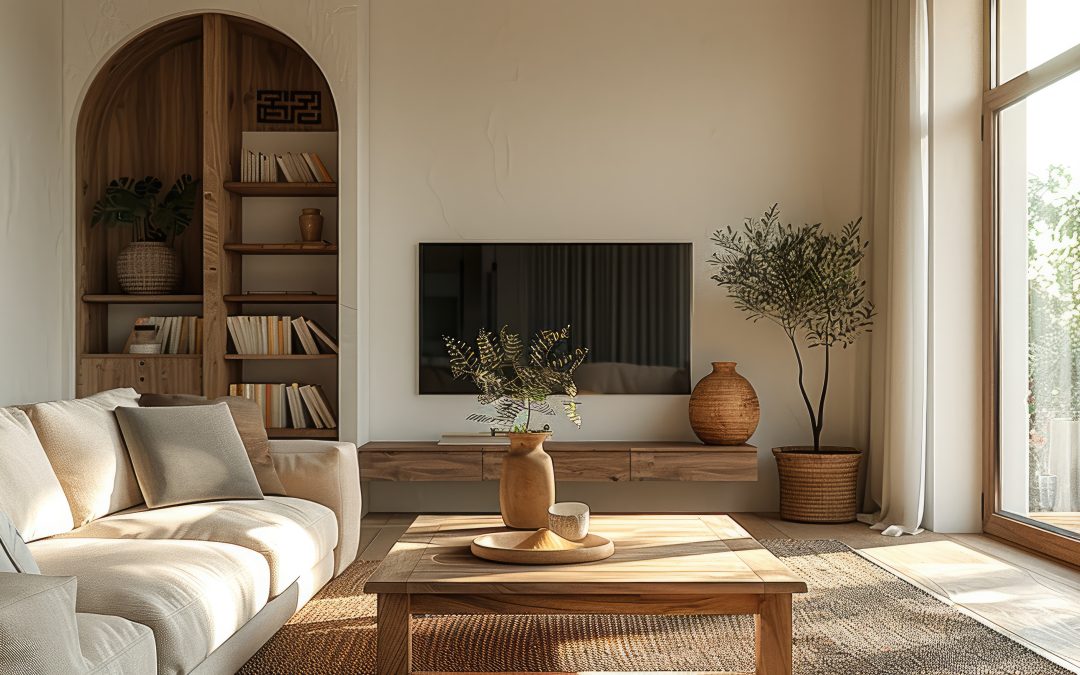
by Kesaa Interiors | DESIGN GUIDES, Living Spaces, ROOMS
This post is all about Small Living Room Layout.
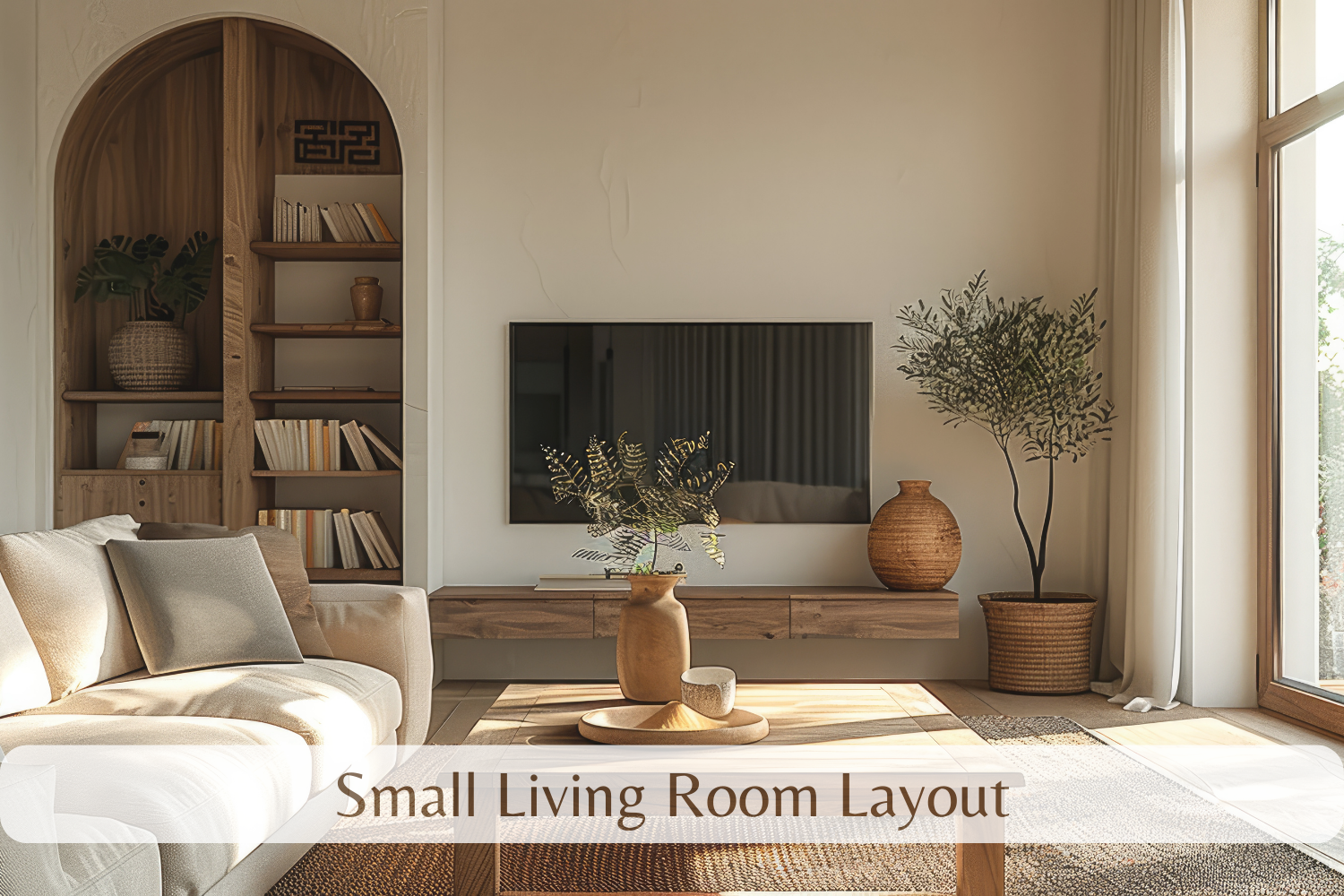
Feeling cramped in your small living room? Don’t give up! It’s a common design challenge, but even the most space-challenged living rooms can be transformed into stylish and functional havens. You can maximise your space with clever layouts and smart design choices.
A small living room layout can often feel limited, but it doesn’t mean sacrificing style or functionality. The key lies in strategic planning and maximising every square inch. This post will provide tips and tricks to transform your small living room layout into a functional and inviting space.
From furniture selection to clever spatial tricks, get ready to unlock the potential of your cosy corner. So ditch the cramped feeling, because transforming your small living room layout into a place where you feel relaxed is definitely achievable!
Best Small Living Room Layout Ideas.
Understanding Your Space
The first step in designing a successful small living room layout is to understand the space you’re working with truly. This goes beyond simply knowing the room’s dimensions; it’s about considering your needs, prioritising functionality, and recognising the inherent opportunities (and limitations) of the space.
- Assess Your Needs and Priorities:
What do you need your living room to be? Is it a place for cosy movie nights with the family, a sophisticated space for entertaining guests, a home office nook during the day, or a multi-purpose space for work and play? Identifying your primary uses will directly inform your layout choices.
Think carefully about how you currently use the space and how you wish to use it. Do you need ample seating for gatherings? Or do you prioritise open floor space for kids to play? Are you a bookworm needing a reading nook? Once you pinpoint these needs, designing an efficient small living room layout becomes significantly easier.
- Measure Everything:
Don’t skip this step! Accurate measurements are crucial when planning a small living room layout. Grab your measuring tape and meticulously record the length, width, and height of your room. Note the placement of windows and doors, since these will influence furniture placement. Don’t forget to measure the location of outlets and radiators!
Creating a floor plan – either hand-drawn on graph paper or using a simple online tool – will give you a visual representation of the space and help you avoid costly mistakes. Furthermore, it allows for strategic decisions when improving your small living room layout. Remember to measure any existing furniture you plan to keep and always measure potential new pieces before bringing them home.
- Identify Focal Points:
Every living room benefits from a focal point – a natural area that draws the eye and anchors the space. In many rooms, the focal point is obvious: a large window with a stunning view, a cosy fireplace, or even a wall-mounted television. However, if your room lacks a clear focal point, you can easily create one.
Consider incorporating an eye-catching piece of artwork, a statement rug, or even creating a gallery wall to serve as your room’s centrepiece. A proper small living room layout relies heavily on the selection of a natural focal point to draw people into the space and add definition to what would otherwise be a drab and claustrophobic area. Once you’ve identified or created your focal point, arrange your furniture around it to create a balanced and inviting seating arrangement.
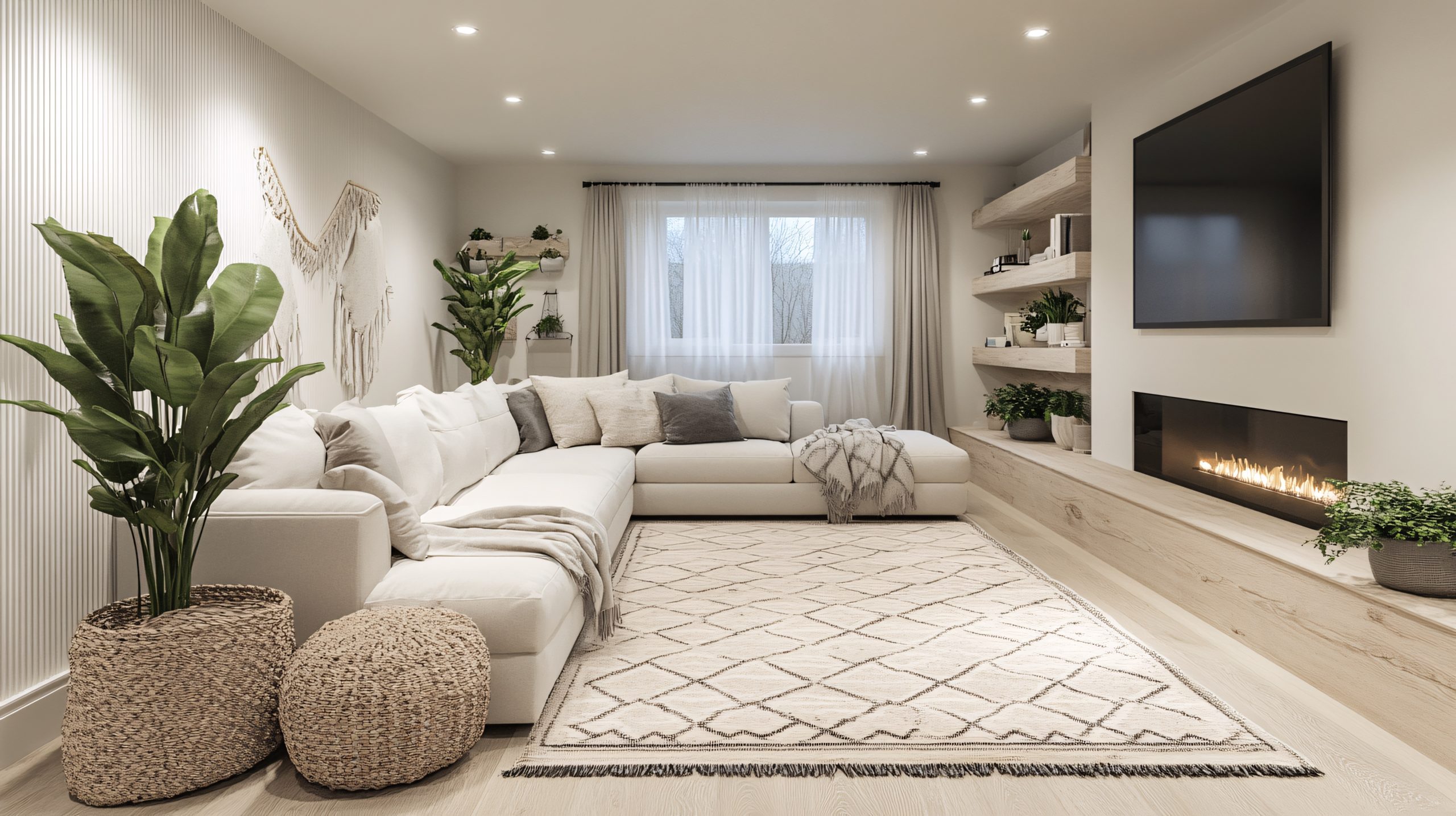
Layout Strategies for Small Living Rooms
Now that you’ve assessed your needs, measured your space, and identified a focal point, it’s time to delve into layout strategies that will truly transform your small living room layout. There’s no one-size-fits-all approach, but understanding these techniques will empower you to create a space that is both functional and stylish.
- The Floating Furniture Arrangement:
Often, the instinctive reaction when decorating a small space is to push all the furniture against the walls. However, this can actually make a room feel more cramped! A “floating” furniture arrangement, where pieces are positioned away from the walls, can create a sense of spaciousness and improve flow.
This technique involves pulling your sofa and chairs a few inches away from the wall. The sliver of open space behind the furniture visually breaks up the room and creates the illusion of more depth. Define the seating area by placing a rug underneath the front legs of your sofa and chairs. The best small living room layout will strategically play with space to optimise the feeling of openness. Using floating furniture to achieve this helps to avoid the visual feeling of being “trapped” by being hugged along every single corner of your room.
- The Corner Arrangement:
If maximising seating is a top priority for your small living room layout, the corner arrangement might be the perfect solution. This strategy involves utilising the corners of your room to create a cosy and conversational seating area.
Consider using a sectional sofa or arranging two sofas in an L-shape to make the most of the corner space. Add a comfortable armchair and an ottoman to create a complete and inviting setting. Corner arrangements are particularly effective in small rooms because they consolidate the seating area, leaving more open floor space for circulation. A good small living room layout relies on the selection of space-saving strategies to create the maximum amount of functionality, without compromising comfort or personal aesthetic expression.
- The Multi-Functional Layout:
Often, small living rooms are tasked with serving multiple purposes. Perhaps you need a dedicated workspace, a small dining area, or a play space for children. Integrating these functions seamlessly into your small living room layout requires careful planning and strategic furniture selection.
Consider using room dividers (like screens or bookcases) to create distinct zones within the living room. If you need to maintain privacy and functionality, dividing up the living area for dual or even multiple uses is essential to a good layout design. For a workspace, try a small desk tucked into a corner or a console table that doubles as a work surface. Choose furniture that serves multiple purposes: a sofa bed for overnight guests, a coffee table with lift-top storage, or an ottoman that can be used as a footrest, a coffee table, or extra seating. Implementing multi-functional components when strategising your small living room layout can make a huge improvement in overall usability and visual perception of added space.
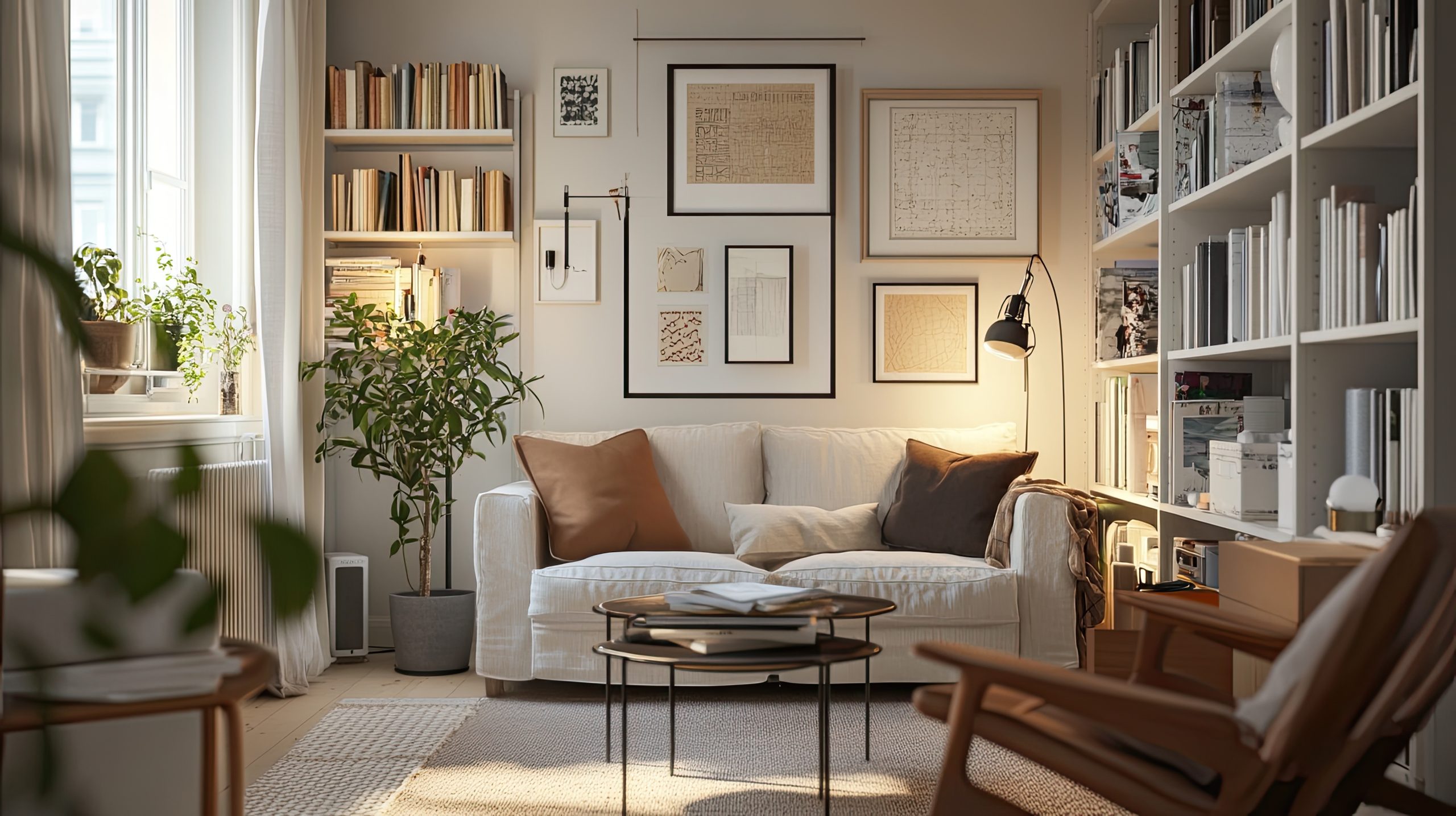
Furniture Choices for Small Spaces
Choosing the right furniture is paramount when crafting a successful small living room layout. Bulky, oversized pieces will quickly overwhelm a small space, while lighter, more streamlined options will create a more open and airy feel. The key is to prioritise functionality, scale, and visual weight.
- Prioritize Multi-Functional Furniture:
In a small living room, every piece of furniture needs to work hard. Opting for multi-functional pieces is a game-changer for maximising space and minimising clutter. This is truly essential if you are going to establish an effective small living room layout.
Think about sofa beds that can transform into guest accommodations, ottomans with hidden storage for blankets and pillows, coffee tables with lift-top surfaces for dining or working, and nesting tables that can be pulled out when needed and tucked away when not in use. Choose pieces that offer built-in storage or that can be easily repurposed. Every piece of furniture needs to provide functional utility in your small living room layout.
- Scale Down Furniture Sizes:
Resist the urge to purchase that enormous sectional sofa! In a small space, smaller-scale furniture will always be a better choice. Opt for a loveseat instead of a full-sized couch, and choose sleek accent chairs instead of bulky armchairs. Consider furniture with exposed legs or open frames, which allow light to pass through and create a sense of lightness.
To improve the efficiency of your small living room layout, try downsizing and using furniture pieces that work with, not against, your space requirements. Think small scale in every purchase: lamps, coffee tables, ottomans and shelves, or anything you want to use, the selection of “lite” in smaller quarters makes a large impact. Remember to consider your overall dimensions to scale correctly, or you could miss what small actually is!
- Vertical Storage Solutions:
When floor space is limited, the only way is up! Taking advantage of vertical storage solutions is crucial for maximizing space and keeping clutter at bay in your small living room layout. By integrating storage space onto the walls, or above the eye line with overhead storage units, an entire additional layer can be applied for function in your space.
Install bookshelves that reach the ceiling, use wall-mounted cabinets to store media equipment and books, or create a gallery wall with floating shelves. Not only does vertical storage provide practical functionality, but it can also add visual interest to your room. Don’t allow dead space! Consider vertical display cabinets, glass cases, and wall shelves for storage options to support an aesthetic but also function in your small living room layout. Think of it as your secret space management power!
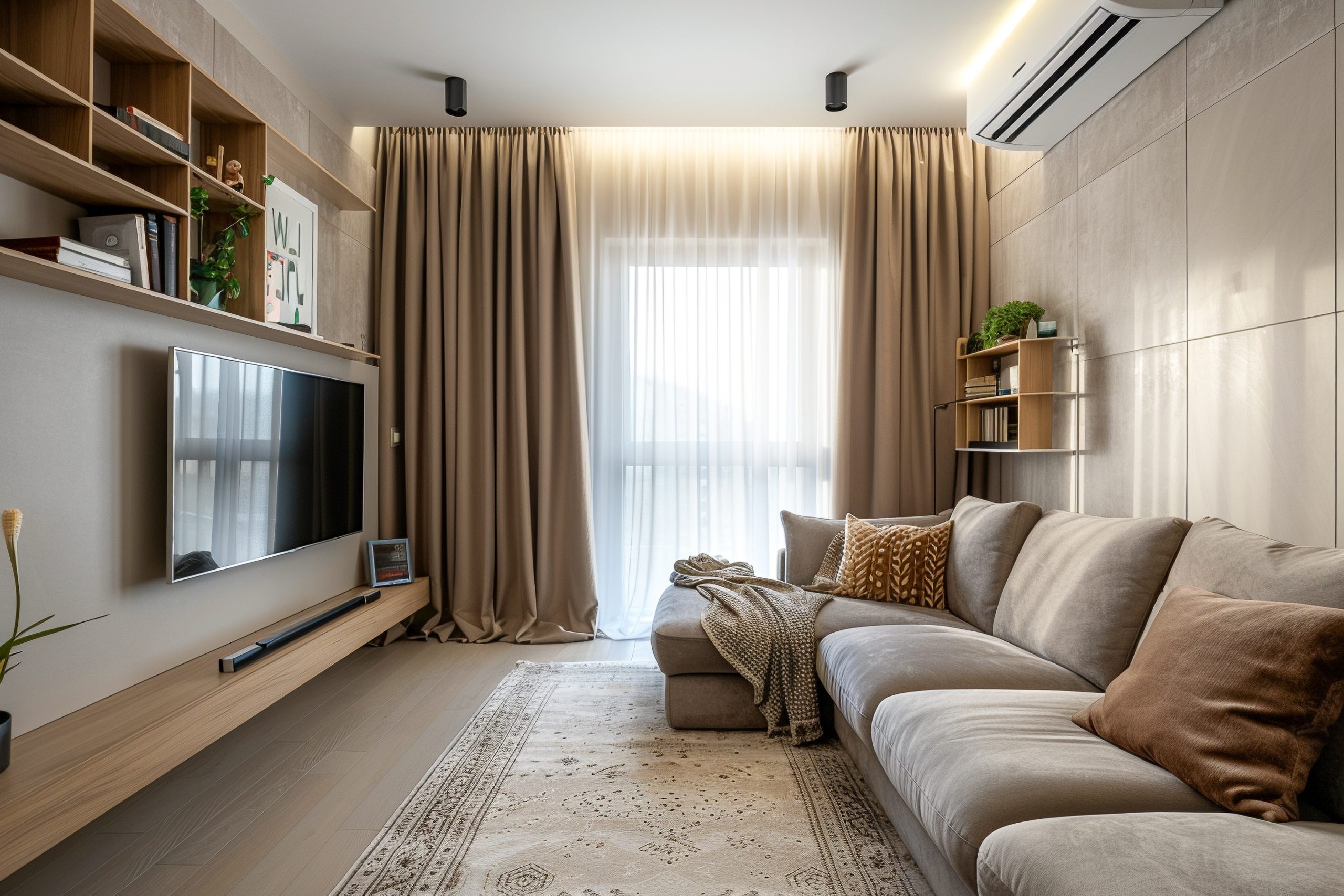
Making the Room Feel Bigger
Beyond choosing the right furniture and layout, there are several visual tricks you can put into place to make your small living room layout feel more spacious and open. These techniques play with light, colour, and perception to create an illusion of added square footage.
- Lighting is Key:
Lighting is a powerful tool in interior design, and it’s especially crucial in small spaces. Maximizing natural light is always the first priority. If possible, avoid heavy curtains that block sunlight and opt for sheer or light-filtering curtains instead. Let that sunshine in!
Layering artificial light is equally important. Combine ambient lighting (like an overhead fixture or recessed lighting) with task lighting (reading lamps) and accent lighting (wall sconces, art lighting). Avoid dark corners – strategically place lamps to brighten the space and create a more inviting atmosphere. With the effective application of both natural and artificial light, improving your small living room layout will open up a huge number of possibilities with decorating options and utility as well.
- Embrace Mirrors:
Mirrors are a designer’s best friend when it comes to creating the illusion of space. Place a large mirror on a wall opposite a window to reflect light and views, effectively doubling the perceived size of the room.
You can also use smaller mirrors to create a gallery wall or add a decorative touch. Experiment with different shapes and sizes to find the perfect fit for your space. Just be mindful of what the mirror is reflecting – avoid reflecting clutter or unflattering views! Careful placement is a high-impact decision when executing a small living room layout effectively using reflective practices.
- Colour and Texture:
The colours you choose for your walls, floors, and furniture can significantly impact the perceived size of your small living room layout. Lighter, brighter colours reflect more light, making the room feel more open and airy.
Stick to a neutral colour palette for your walls and floors, and then add pops of colour through accessories like pillows, throws, and artwork. Incorporating textures (like woven baskets, plush rugs, or patterned fabrics) can also add visual interest and depth to the space, preventing it from feeling flat or sterile. A small living room layout doesn’t have to compromise on expressing an individual or stylistic aesthetic, despite limited square footage. You can use a range of texture applications and lighter colours to really create a sense of warmth and homeliness.
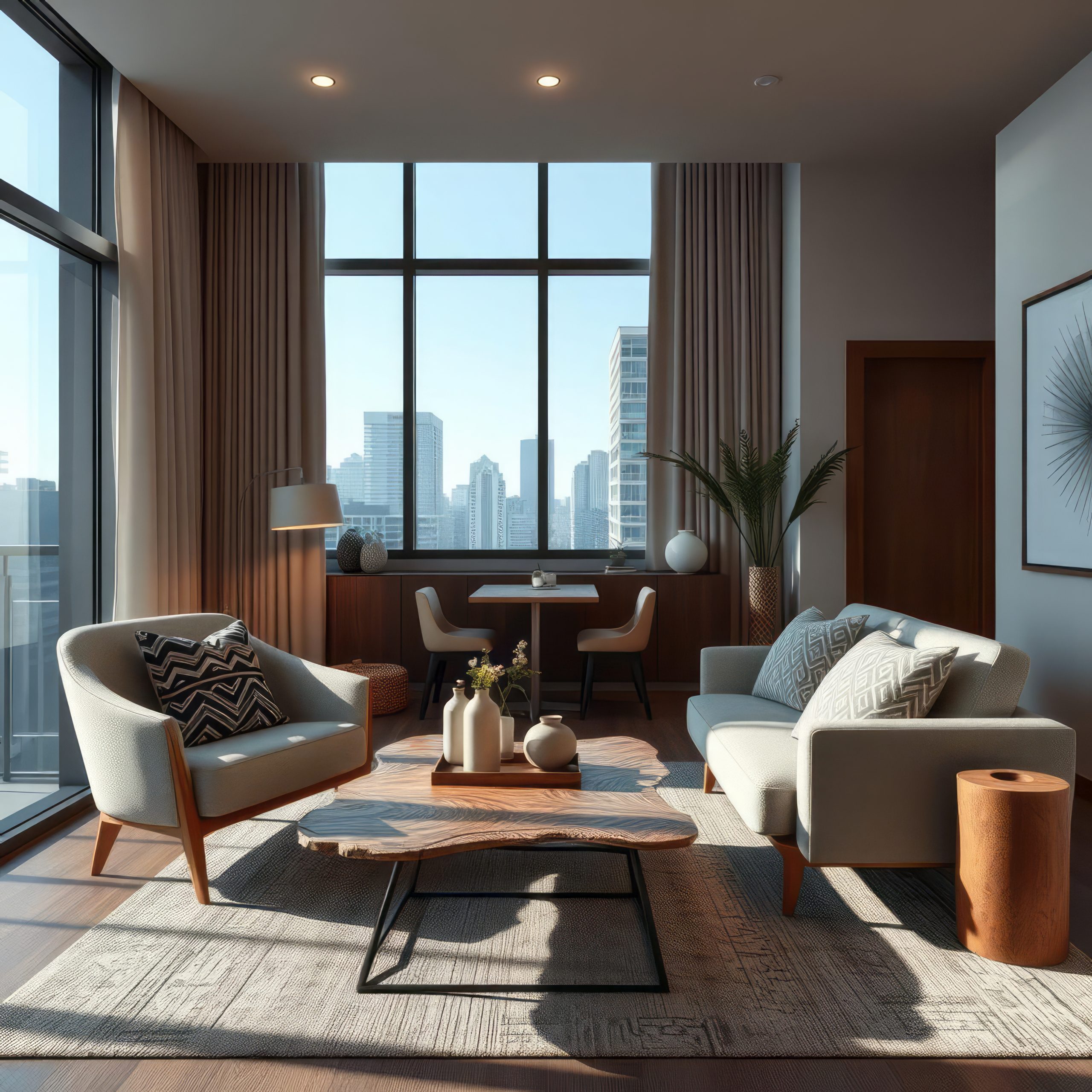
Declutter and Organise
No matter how well-designed your small living room layout is, it will always feel cramped and uncomfortable if it’s cluttered and disorganised. A clutter-free space is essential for maximising functionality and creating a sense of calm and relaxation. Getting rid of all excess junk is probably the most critical first step to a successful small area.
- Regular Purging:
Make it a habit to regularly declutter your living room and remove any items you no longer need, use, or love. Be honest with yourself – if you haven’t used something in the past year, chances are you don’t need it. A successful small living room layout benefits greatly from the art of “less is more”.
Donate unwanted items to charity, sell them online, or simply toss them in the trash. The goal is to create a space that is free from unnecessary belongings, allowing you to fully enjoy the room. Consider making it a goal to run through the things and find the clutter spots at least quarterly.
- Smart Storage Solutions:
Effective storage is essential for keeping clutter at bay. Utilise baskets, bins, and decorative boxes to conceal everyday items like remote controls, magazines, and toys. Make use of furniture with built-in storage, such as ottomans, coffee tables, and console tables with drawers or shelves. This adds some extra functionality when used to support your small living room layout!
By creating designated storage areas for all of your belongings, you’ll keep your living room tidy and organised. Creating and enforcing good habits is the first step to the benefits that come from organising with small living room layout. With strategic decluttering and careful planning, the small space will allow for functional as well as fun enjoyment.
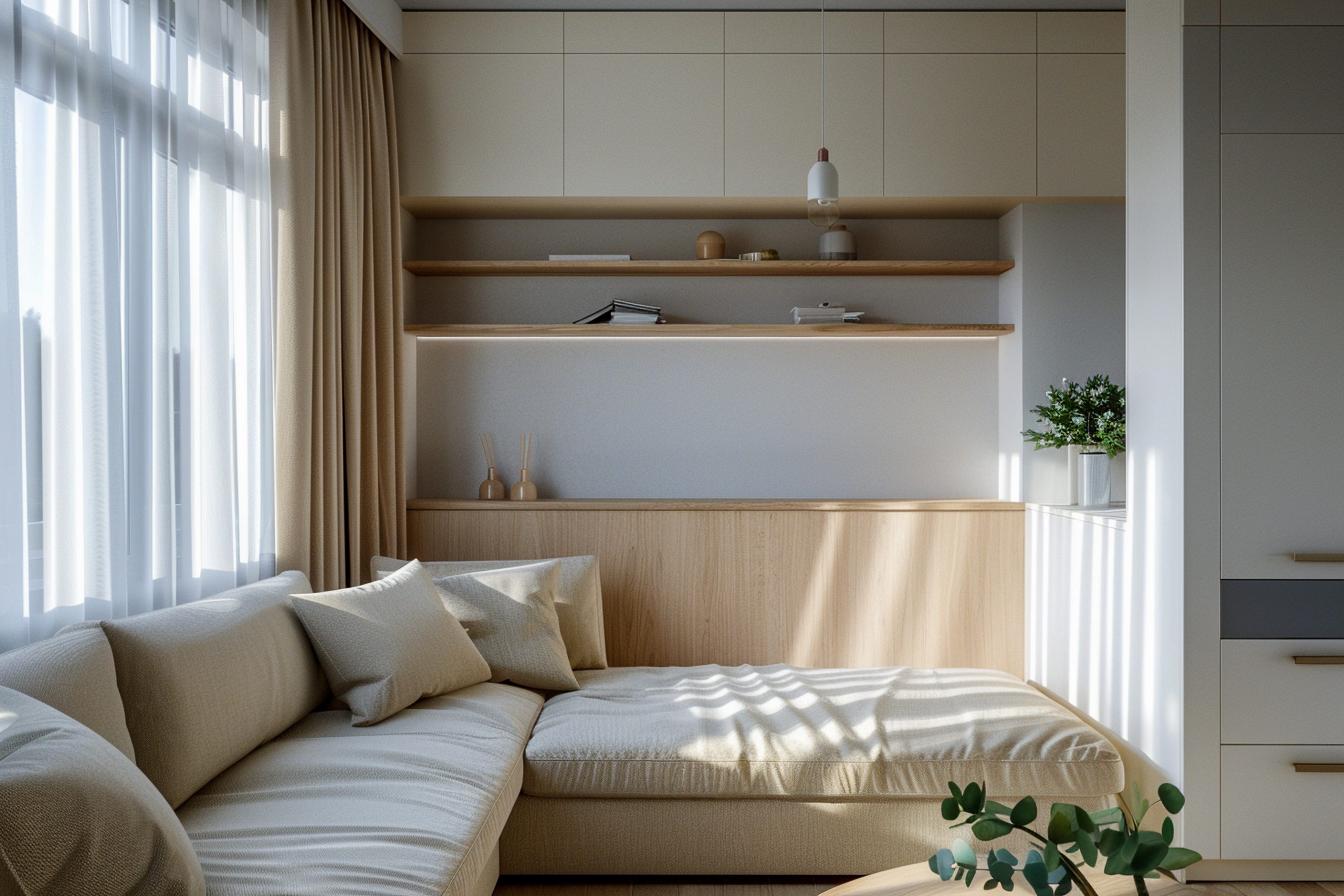
You can totally transform the cramped spaces! Planning a brilliant small living room layout is definitely doable. By strategically considering needs, measuring your space, choosing furniture pieces and arrangements carefully, the small space will provide joy, and comfort and style to those who live with its design! So get the plans flowing, come up with the optimal layout and see the changes that can come with putting some work and inspiration!
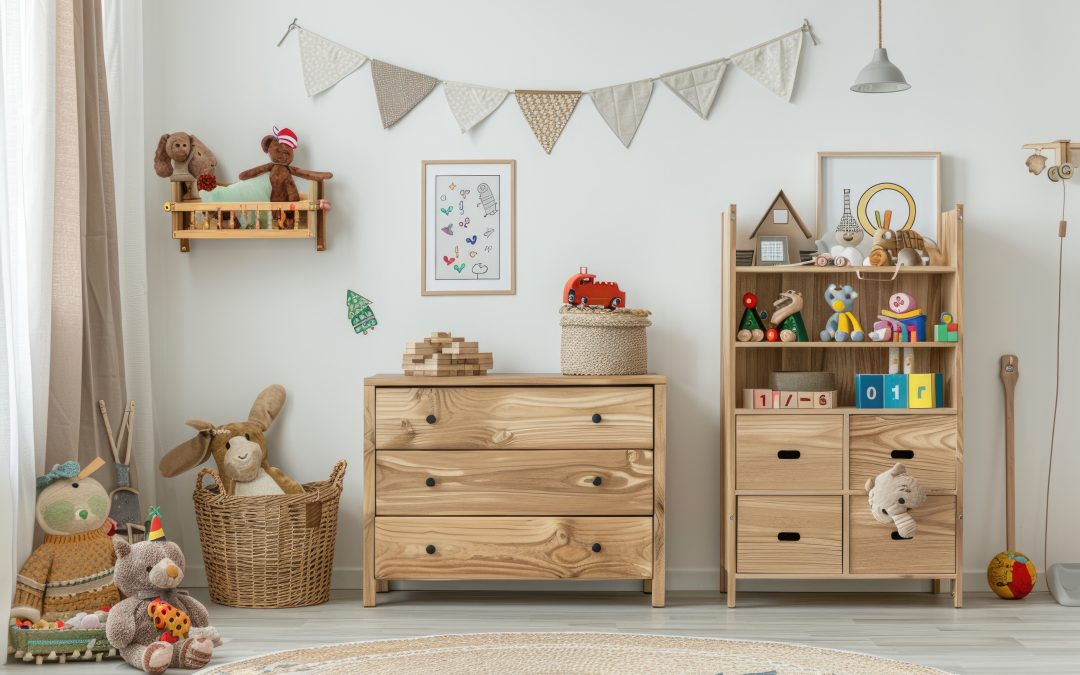
by Kesaa Interiors | Bedrooms, ROOMS, Storage & Organization
This post is all about Kids Room Storage.
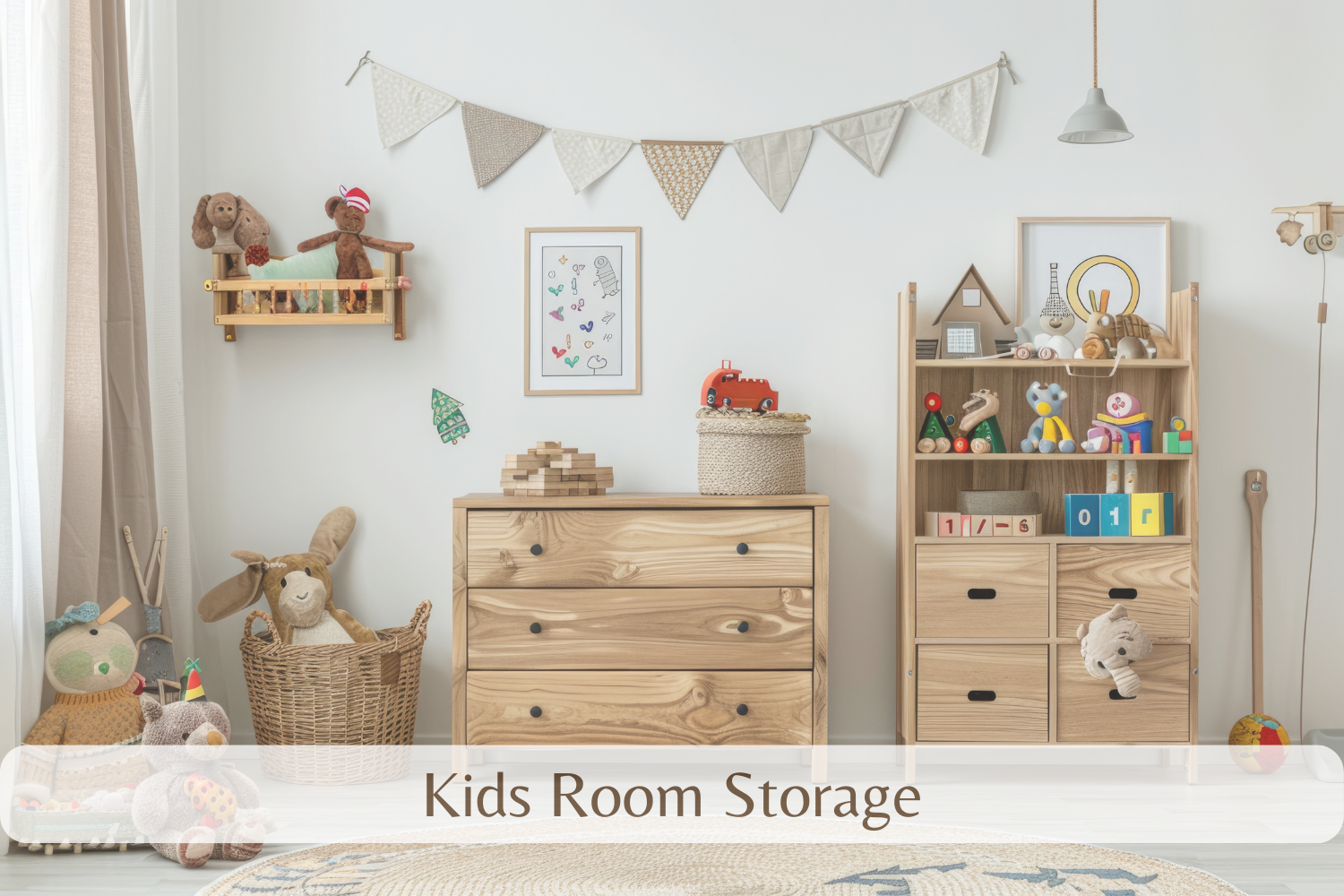
Is your child’s room more of a toy explosion than a peaceful space? You’re not alone! The never-ending cycle of toy piles, scattered clothes, and misplaced art supplies can turn any parent into a decluttering machine. This constant chaos isn’t just stressful; it can also create safety hazards and make it nearly impossible to find that one specific Lego piece when you need it most! But there’s hope.
This post is your guide to unlocking the secrets of organized kids room storage, making your life easier and your child’s space more enjoyable. Finding the right kids room storage solutions can be a game-changer, transforming a chaotic space into a functional and inviting environment where your child can play, learn, and thrive. Let’s ditch the overwhelm and dive into some practical and creative strategies!
Best Kids Room Storage Solutions.
1. Before You Buy: Assessing Your Kids Room Storage Needs & Decluttering Like a Pro
Before you even think about browsing the Container Store, the key to truly effective kids room storage lies in understanding what needs to be stored and, most importantly, getting rid of the excess! Skipping this crucial step is like trying to fit an elephant into a shoebox – it just won’t work.
Inventory is Key: The first step is to take a thorough inventory of everything that currently resides in your child’s room. Consider breaking down your search by these common room occupant items;
-
Toys: Sort toys by category – large (ride-ons, playhouses), small (action figures, miniature cars), plush toys, building blocks (Legos, Duplo), puzzles, and games.
-
Books: Picture books, chapter books, board books, workbooks.
-
Clothing: Current season, outgrown items, dress-up clothes, shoes.
-
Art Supplies: Crayons, markers, paint, paper, construction paper, modeling clay.
-
Bedding: Sheets, blankets, comforters, pillows.
-
Other: Unique to your child’s interests (e.g., musical instruments, sports equipment, collections).
Decluttering is Key: The beauty of less is truly displayed when you think about the organization of your kids room storage situation. Fewer items to store = a significant boost to any existing setup.
-
Less Stuff, Less Stress: The more you purge, the less you need to organize, making the entire process less overwhelming. It’s like clearing a path to easier mornings and calmer bedtimes.
-
Finding Items with Ease: Less clutter means items are more readily and easily accessible. You can encourage your child’s independence by allowing them to easily find items from the start.
-
Make It A Game (Age Appropriate): Try to involve your child with age-appropriate instructions in your decluttering process. Donate old stuffed toys and find new homes, your child will feel like a giving person from the get go!
Categorize & Prioritize: Next, organize those items into easily labeled categories! Group similar items together. Toys will be grouped with each other, art supplies too! Determine what your child uses the most, keep these easily accessible and at an arms reach. This can keep play time quick and cleanup easy too!
Measure & Map: Grab your measuring tape! Don’t even think about ordering storage bins without knowing the dimensions of your closet, the space under the bed, or that awkward corner in the room. Before investing in any new kids room storage, make a simple floor plan of the room. Note the dimensions of key storage areas and existing furniture. This helps visualize what will fit and avoid costly mistakes.
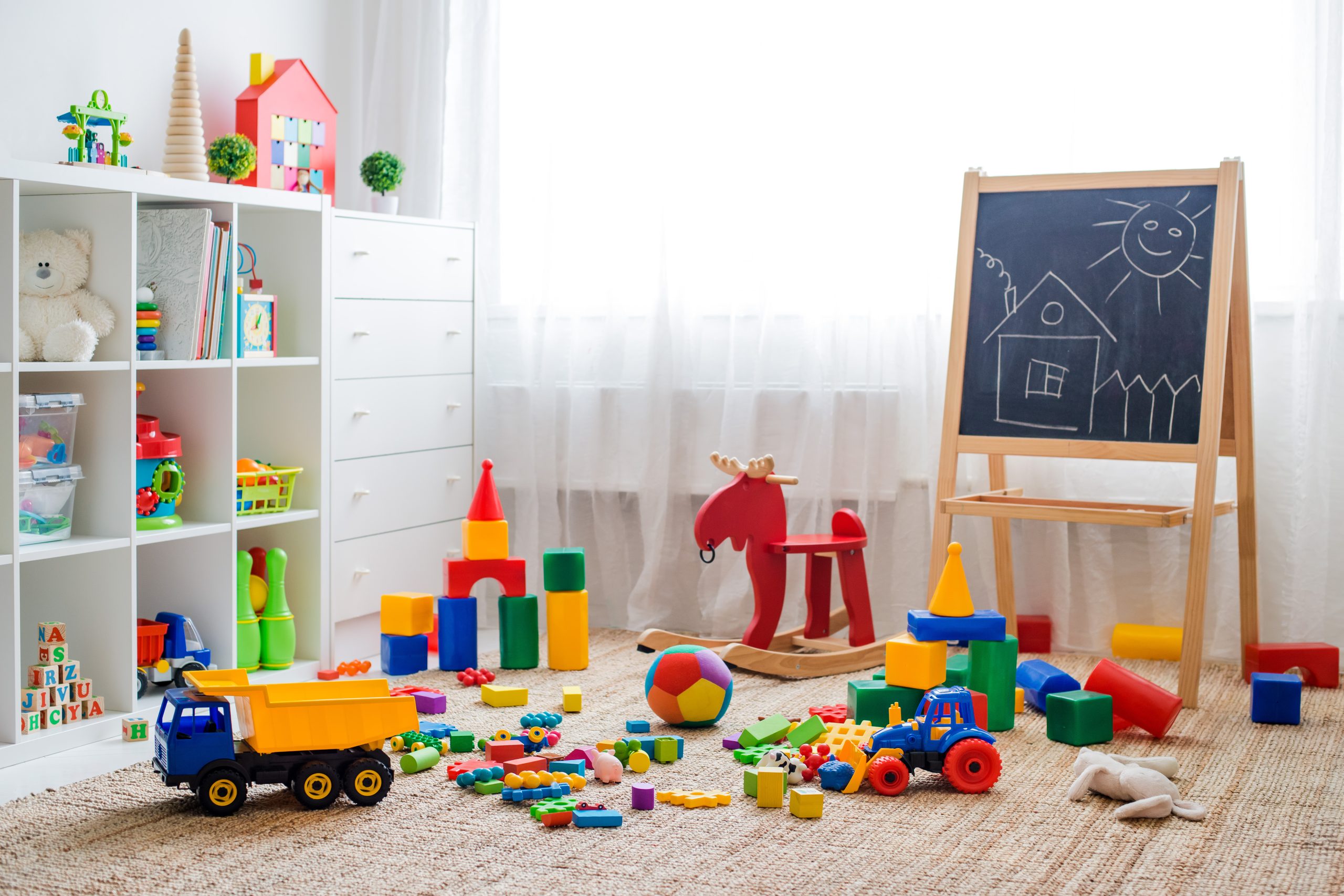
2. Conquer Clutter Zone by Zone: Kids Room Storage Ideas for Every Space
Now that you’ve decluttered and assessed your needs, it’s time to get strategic! Different areas of a kids room storage benefit from different storage solutions. Let’s break down some ideas zone by zone:
A. Under-Bed Storage:
Taming the vast expanse beneath the bed is a classic strategy for discreet kids room storage. It’s especially helpful for items that aren’t used every day, like seasonal clothing, extra bedding, or larger toys.
-
Types of Under-Bed Storage:
-
Rolling Drawers: Pre-made drawers on wheels slide easily in and out, perfect for frequently accessed items like toys or blankets.
-
Shallow Bins with Lids: Ideal for storing folded clothes, shoes, or smaller toys. Look for clear bins for easy visibility.
-
Vacuum-Sealed Bags: Best for storing off-season clothing or bulky bedding to maximize space and protect against dust and pests.
-
DIY Options: Repurpose sturdy cardboard boxes, adding wheels and a decorative cover for a budget-friendly solution.
-
Considerations: Pay attention to the height of your bed and the clearance underneath. Measure carefully before purchasing any under-bed storage. Also, consider the floor type (carpet vs. hardwood) as it may affect the ease of sliding the storage containers. Regularly check under-bed storage for dust.
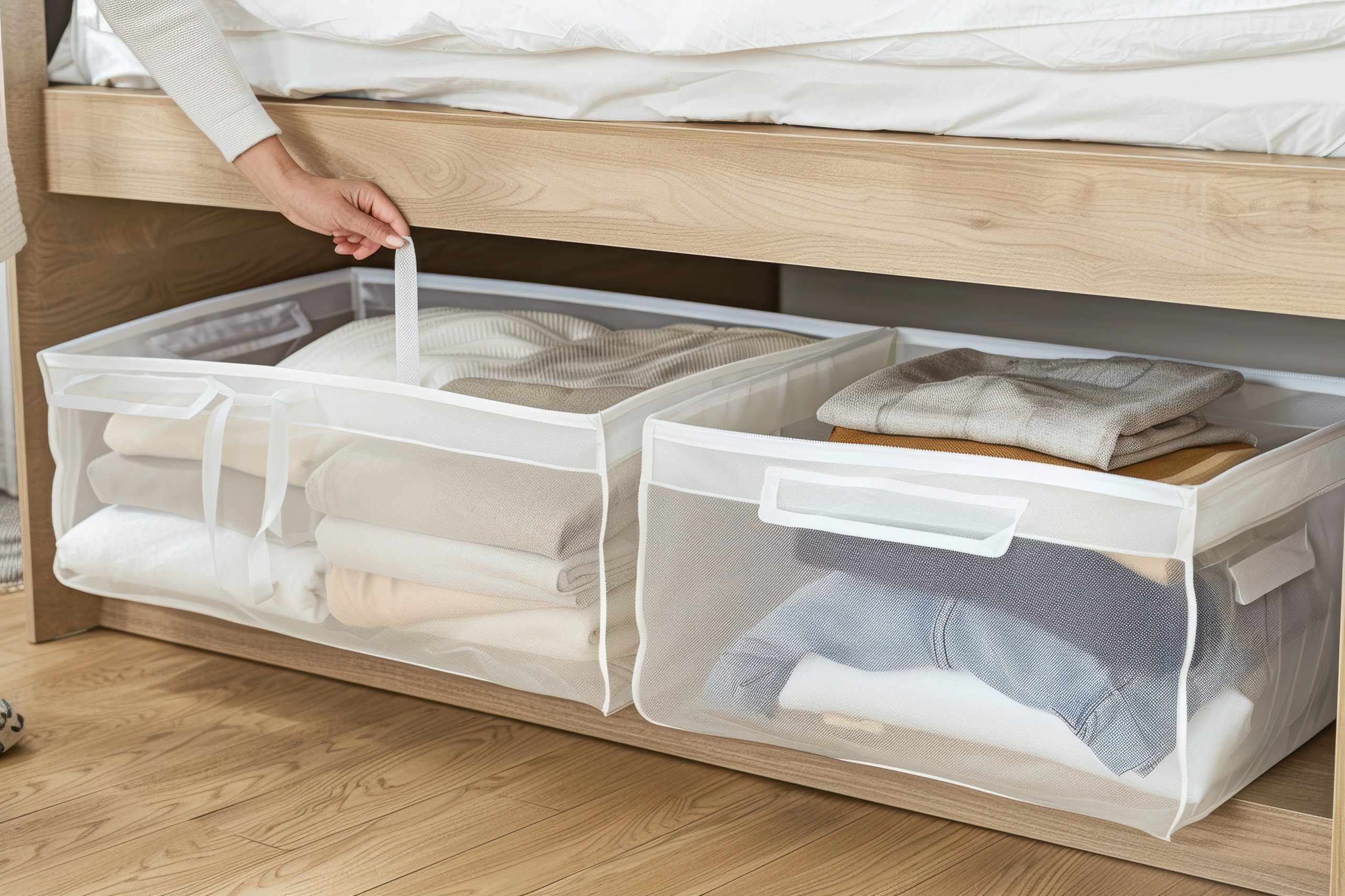
B. Closet Organization:
The closet can quickly become a black hole if left unorganized. Effective kids room storage in the closet is key to managing clothing, shoes, and other essentials.
-
Maximize Vertical Space:
-
Adjustable Shelving and Rods: Invest in a closet system with adjustable shelves and rods to accommodate clothing of different lengths and sizes. As your child grows, you can adjust the shelves accordingly.
-
Hanging Organizers: Utilize hanging shoe organizers for storing small toys, craft supplies, or accessories. Sweater organizers can hold folded clothes or out-of-season items.
-
Baskets and Bins: Use baskets and bins on shelves to keep smaller items contained and organized. Label the bins clearly for easy identification.
-
Make it Kid-Friendly:
-
Lower Rods & Shelves: Lower the hanging rod (if possible) or add a second rod at a lower height so your child can reach their own clothes.
-
Small Step Stool: Keep a small, sturdy step stool nearby to help your child reach upper shelves or hanging items safely.
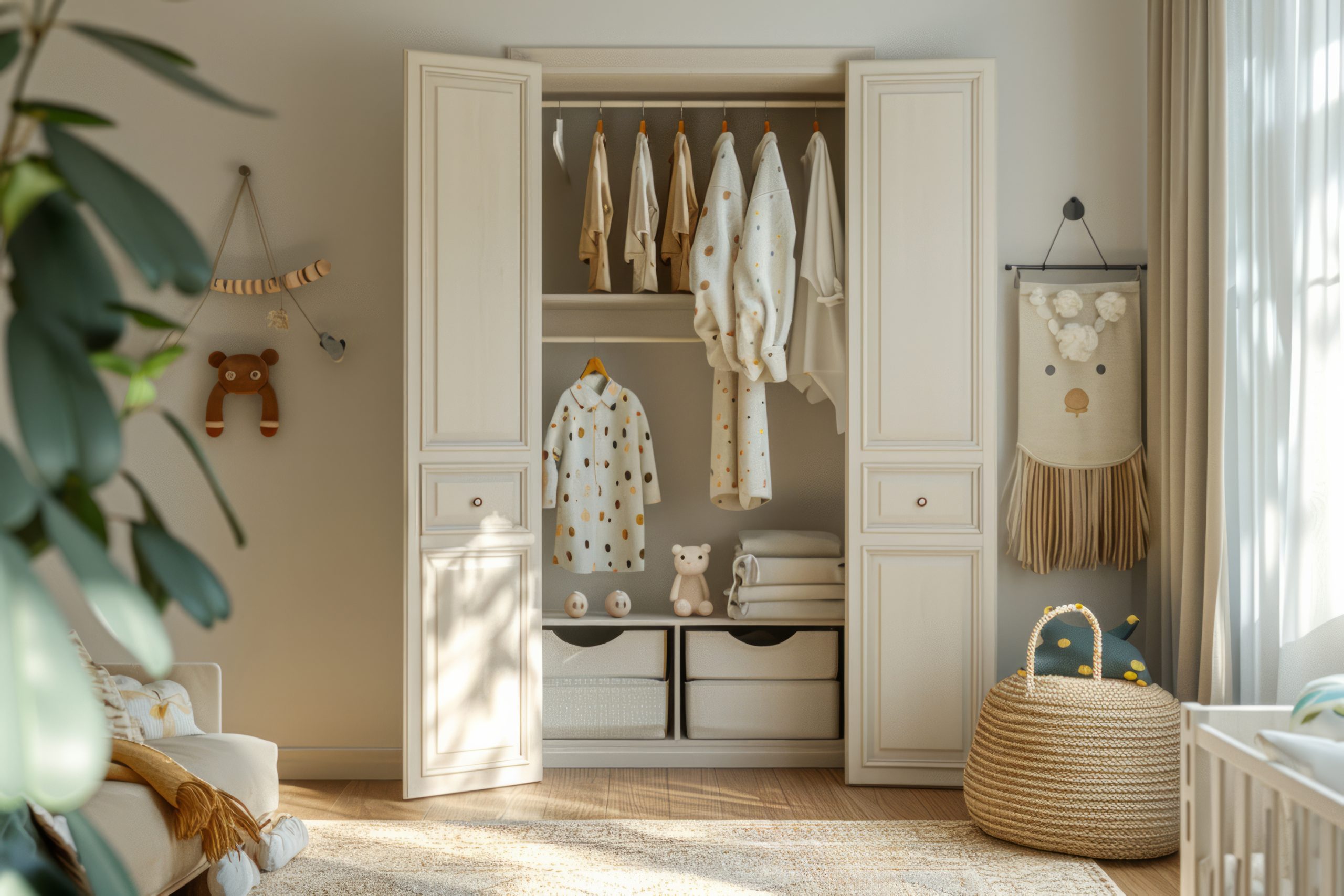
C. Wall Storage:
Don’t underestimate the power of vertical space! Utilizing walls for kids room storage can free up valuable floor space and keep items off the ground, reducing clutter and creating a more visually appealing room.
-
Shelf Strategies:
-
Floating Shelves: Provide a clean, modern look and are perfect for displaying books, toys, or decorative items. Be sure to mount them securely, especially if storing heavier items.
-
Bookshelves: Choose a bookshelf that is the appropriate size for your child’s room. Consider one with adjustable shelves for maximum flexibility.
-
Baskets and Hooks:
-
Wall-Mounted Baskets: Great for storing art supplies, small toys, or even stuffed animals.
-
Pegboards with Hooks: Highly customizable and versatile, pegboards allow you to create a storage system tailored to your specific needs. Use hooks to hang everything from art supplies to backpacks.
- Keep things accessible:
º Mount storage shelves within reach, and keep items your child may need within immediate access while setting anything else out of reach to encourage self-dependency.
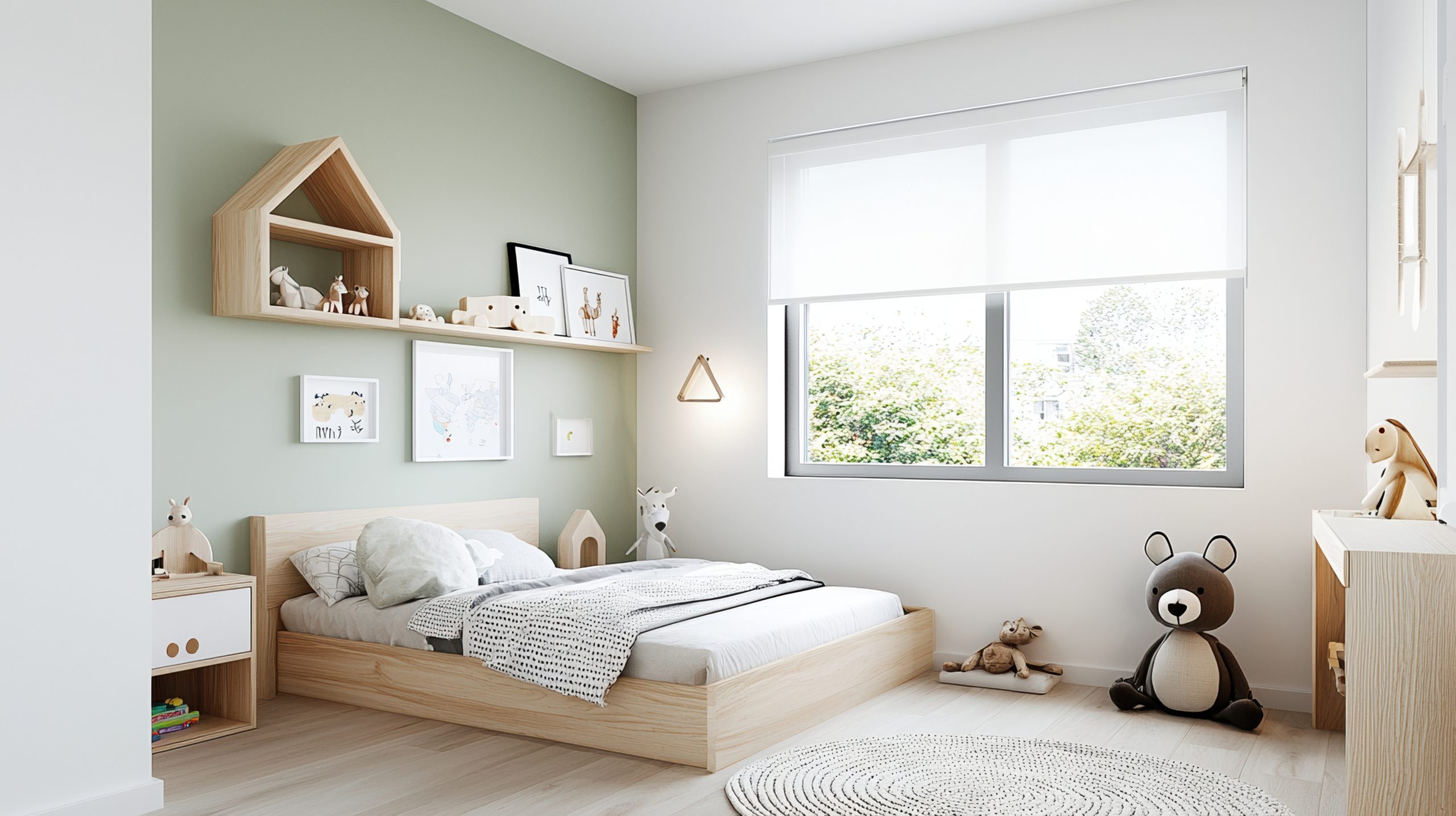
3. Thinking Outside the Box: Unique and Multifunctional Kids Room Storage
Sometimes the most effective kids room storage solutions are the ones that are a bit unexpected! Embracing multifunctionality and thinking creatively can unlock hidden potential and make your space work even harder.
-
Furniture with Built-in Storage: Investing in furniture pieces that double as storage is a game-changer, particularly in smaller spaces.
-
Beds with Drawers Underneath: A practical solution for storing clothing, toys, or extra bedding. Beds with built-in drawers often come in platform and Captains’ designs, maximizing every inch of space beneath the mattress.
-
Ottomans with Storage Inside: Stylish and functional, storage ottomans provide a hidden space for toys, blankets, or board games while adding seating to the room.
-
Benches with Storage: Ideal for entryways or playrooms, storage benches provide a comfortable place to sit while concealing toys, shoes, or other items. A storage bench can also act as a window seat adding comfort while decluttering.
-
Desks with Storage: Desks with drawers, shelves, or built-in cubbies help keep school supplies and art materials organized and within easy reach.
-
Repurposed Items: Get creative by transforming ordinary items into unique and charming storage solutions!
-
Old Suitcases as Toy Storage: Vintage suitcases stacked on a shelf or the floor add a whimsical touch while providing storage for dolls, action figures, or other small toys.
-
Ladder as a Blanket Rack: Lean an old wooden ladder against the wall to create a rustic and decorative blanket rack.
-
Dressers as Toy Stations: An old dresser can be repurposed as a toy station. Give the dresser a fresh coat of paint or keep the original to display items and keep your child’s items away to declutter more.
-
DIY Storage Solutions: Don’t be afraid to roll up your sleeves and tackle some DIY storage projects!
-
Easy-to-Build Shelves: Simple wooden shelves can be easily constructed using basic materials and tools. Customize the shelves to fit your specific needs and decorate them with paint, wallpaper, or stencils.
-
Decorating Plain Bins: Add personality to plain plastic bins with paint, fabric scraps, or stickers. Label each bin clearly to ensure everyone knows what goes where.
-
Storage That Doubles as Décor: Functional storage doesn’t have to be boring! Choose storage solutions that are also visually appealing and contribute to the overall aesthetic of the room.
-
Baskets as Decorative Elements: Woven baskets in various shapes, sizes, and textures can add warmth and character to a room while providing stylish storage.
-
Color-Coded Storage: Use color-coded bins, baskets, or shelves to create a visually appealing and easy-to-understand storage system. Assign a specific color to each type of item (e.g., blue for toys, green for books, red for art supplies).
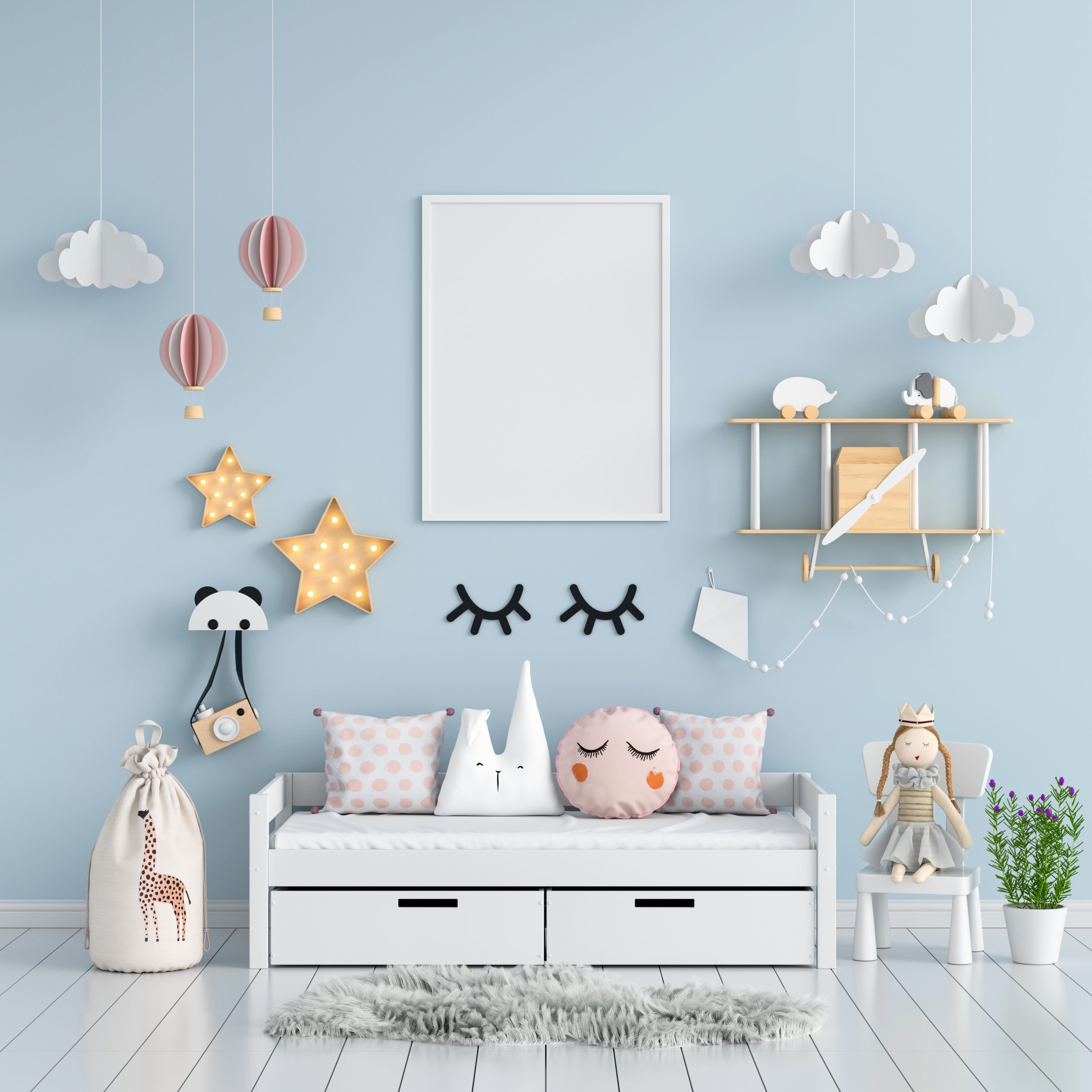
4. Keeping it Clean: Tips for Maintaining Your Organized Kids Room Storage System
Creating an organized kids room storage setup is just the first step! The real challenge is maintaining that organization over time. Without consistent effort, the clutter monster will inevitably creep back in.
-
Establish a Routine: Making clean-up a regular habit is crucial for long-term success. Designate a specific time each day (e.g., before dinner or bedtime) for tidying up the room. Involve your child in the routine, making it a shared responsibility. This also teaches the benefits of organization while becoming routine with time.
-
Label Everything: Clear and consistent labels on bins, baskets, shelves, and drawers are essential. Labels help everyone (including kids!) know where things belong and encourage them to put items back in their designated spots.
-
Use Pictures for Younger Children: For children who cannot yet read, use picture labels alongside words to help them identify the contents of each storage container. Print or draw pictures of toys, clothes, or other items and attach them to the bins.
-
Teach Your Child to Sort and Put Away: Age-appropriate tasks that children can help with include toys or clothes! Encourage them to get involved to make cleaning a more routine process for themselves.
º Teach children what to put away in different areas to ensure children’s comprehension with cleanup
-
Regular Decluttering: Schedule regular decluttering sessions to purge unwanted or unused items. Set aside time every few months to go through the room and get rid of anything that is no longer needed or used. Involve your child in the decluttering process to teach them about giving back to the community.
-
Designate a “Home” for Everything: Ensure that every item in the room has a designated “home” – a specific spot where it belongs. This prevents items from ending up in random piles and makes it easier to find them when needed. Explain that every item goes back to its designated area, once that is understood by your child, everything goes smoothly after the fact.
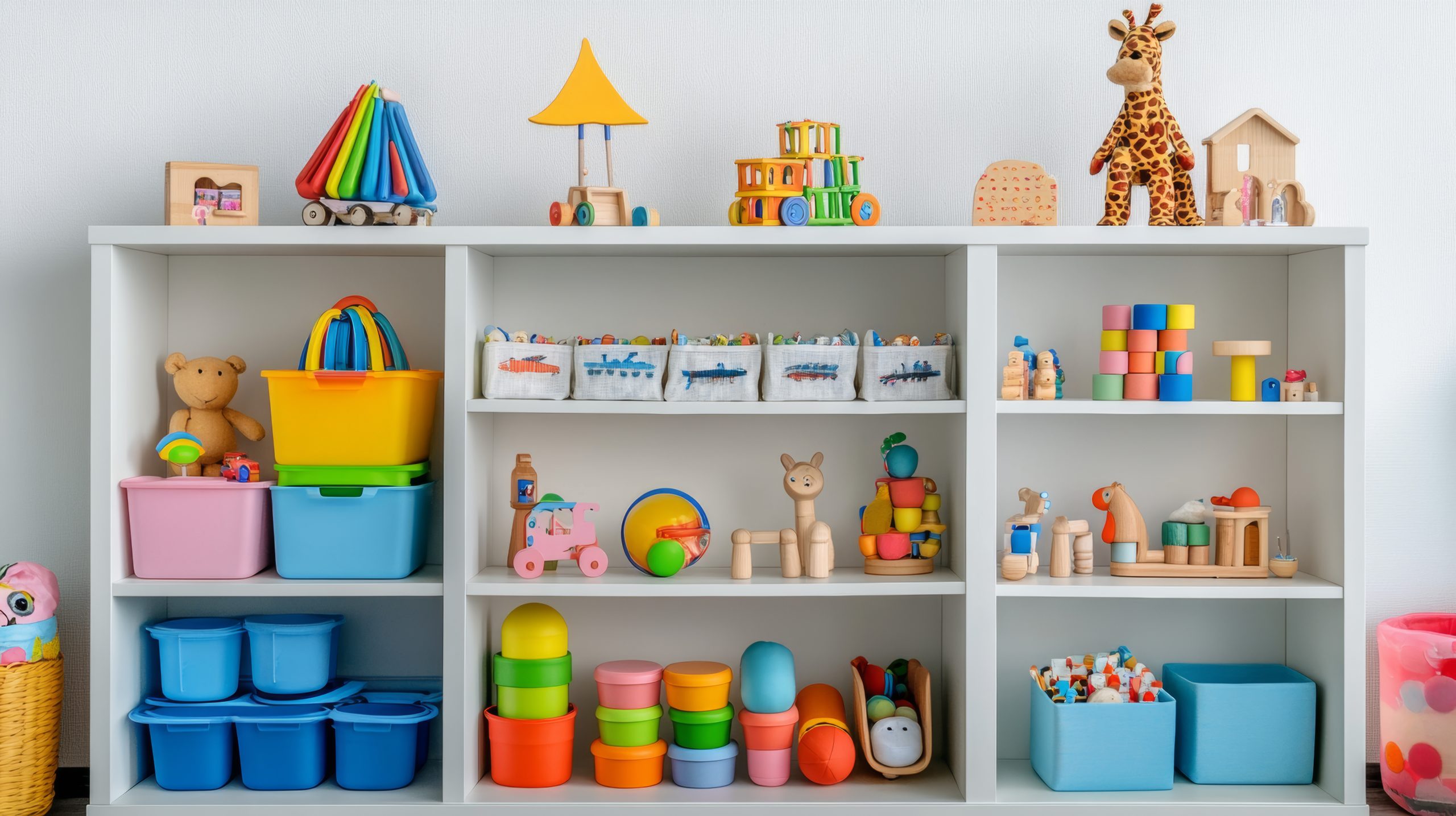
Transforming a chaotic kids’ room into an organized and functional space may seem daunting, but by embracing a strategic approach and implementing clever kids room storage solutions, you can create a room that both you and your child will love. Remember the key principles: declutter first, understand your specific storage needs, choose solutions that maximize every area of the room, get creative with repurposed items, and establish consistent habits to maintain order.
By tackling this step-by-step, you’ll significantly reduce your stress, make finding items far easier, and even foster greater independence in your child.
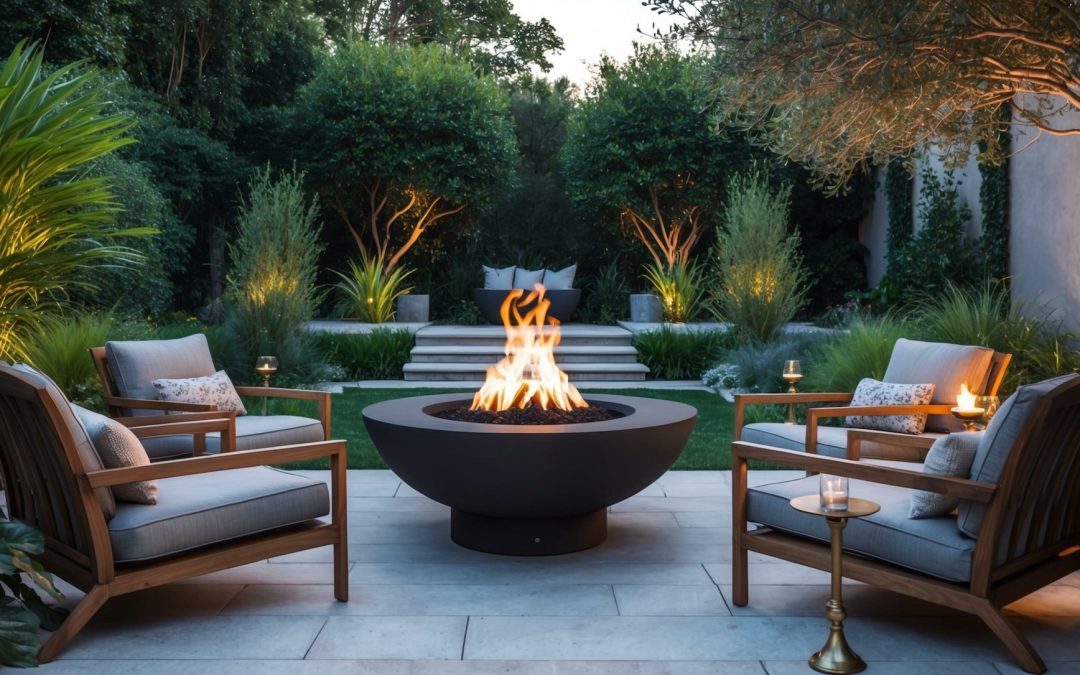
by Kesaa Interiors | DESIGN GUIDES, Outdoor Spaces, ROOMS
This post is all about Winter Patio Ideas.

Think patios are just for summer? Think again! They can be magical winter retreats, too. The idea of enjoying the outdoors doesn’t have to fade with the summer sun; in fact, your patio holds untapped potential to become a cozy, inviting sanctuary even during the coldest months.
This blog post will guide you through transforming your outdoor space into a warm, comfortable, and stylish haven that you can enjoy all year round. From selecting the right heating options to adding stylish decor and ensuring weather protection, we’ll explore a wealth of practical and creative winter patio ideas to create a unique extension of your home.
Best Winter Patio Ideas
Why Extend Your Patio Season? The Benefits of a Winter Outdoor Space
The perception of patios as purely summer spaces often leads to them being neglected once the temperatures drop. However, embracing your patio all year round unlocks a wealth of benefits for both your home and your well-being. Imagine the crisp, clean air filling your lungs as you enjoy a starlit dinner on your own heated patio or sipping a warm cup of coffee on a cold winter’s morning, without having to leave the comfort of your home. A winter patio provides a unique way to experience the outdoors, offering a refreshing change of scenery and a much-needed connection to nature, even on chilly days.
Beyond the aesthetic appeal, extending your patio season allows for increased functional space. Instead of being confined indoors, you have an added area for entertaining, relaxing, or even working from home. The flexibility this provides can be a welcome change for those with a busy schedule, allowing a refreshing escape without the need to leave the house. Plus, it creates a distinct atmosphere for hosting guests during the holiday season or a cozy spot to spend time with family after a long day.
Beyond the functional, the benefits of outdoor time during winter significantly impact your mental and emotional well-being. Sunlight, even on colder days, helps boost your mood and reduces the effects of seasonal changes. Creating a cozy winter patio can provide an invaluable opportunity to recharge and alleviate stress. Instead of spending time and money travelling to expensive resorts, you can make your home an even more enjoyable place to be all year. The ability to connect with nature in a comfortable setting will ultimately have a positive effect on your overall well-being. By transforming your patio into a functional and enjoyable outdoor winter space, you’re not just adding square footage to your home; but investing in a lifestyle that promotes relaxation, entertainment, and connection to the outdoors, regardless of the season.
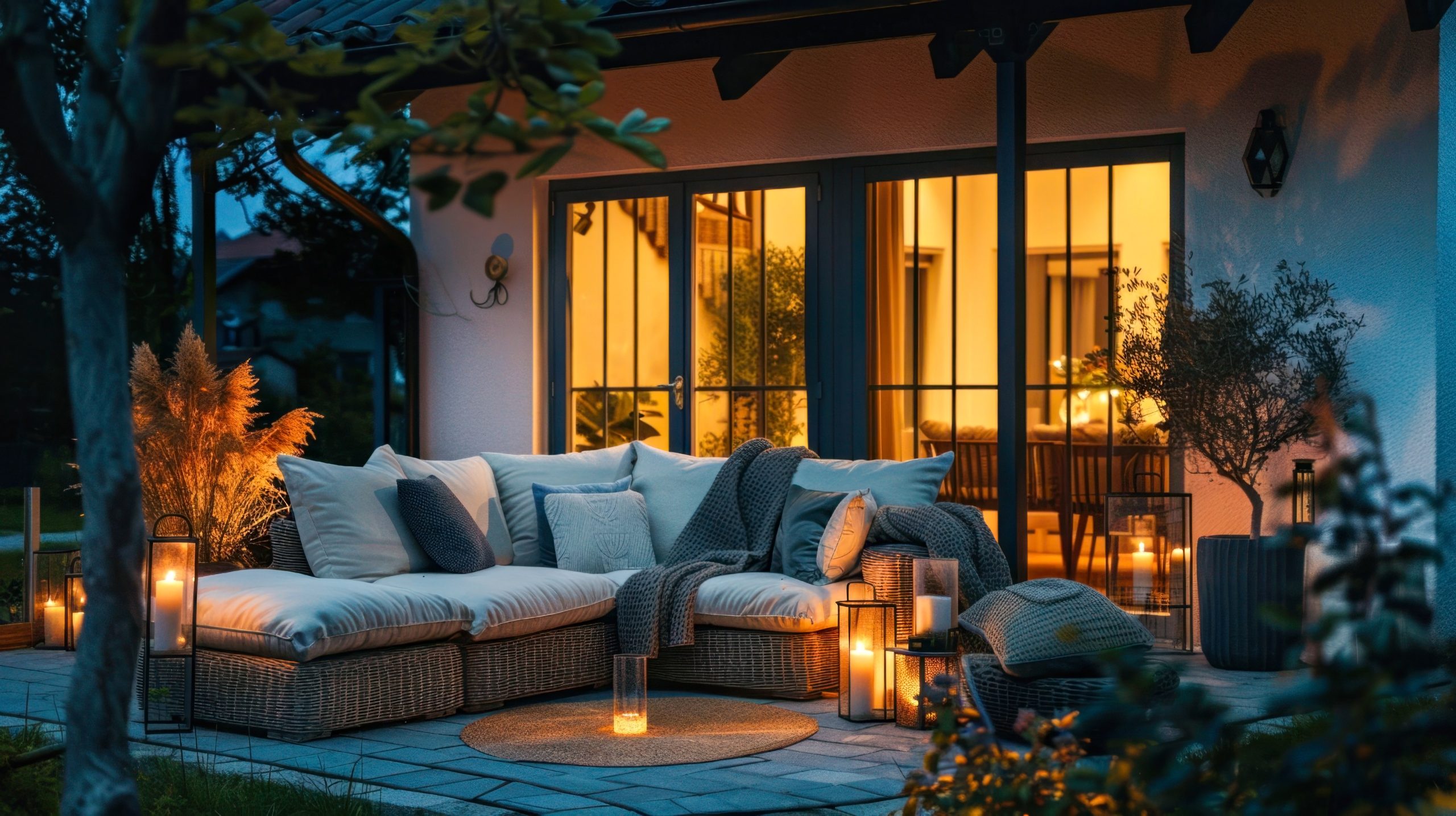
Essential Heating Solutions for Your Winter Patio Ideas
Creating a comfortable winter patio hinges on having adequate heating solutions. Without effective warmth, your outdoor space will be less inviting, no matter how stylishly it’s decorated. There are a variety of options to choose from, each with their own pros and cons. The right choice for you will depend on your budget, patio size, and personal preferences. Let’s explore some of the most popular and effective heating solutions:
Fire Pits & Outdoor Fireplaces
The timeless allure of a crackling fire makes fire pits and outdoor fireplaces incredibly appealing for a winter patio. Fire pits come in various styles and sizes, from portable models to built-in structures that create a focal point in your outdoor space. You can choose from wood-burning options that offer the authentic feel of a real fire, gas fire pits that provide more convenience, or propane fire pits that are versatile and mobile. When selecting a fire pit, consider the materials, such as steel, copper, or stone, and be mindful of safety precautions, especially if you have children or pets. Ensure adequate space around the fire pit, especially if you have any flammable materials nearby. The type of fuel used will also determine the cost and maintenance required. Outdoor fireplaces, whether built-in or freestanding, provide an even more substantial source of warmth and add elegance to your winter patio, becoming a central point for warmth and style.
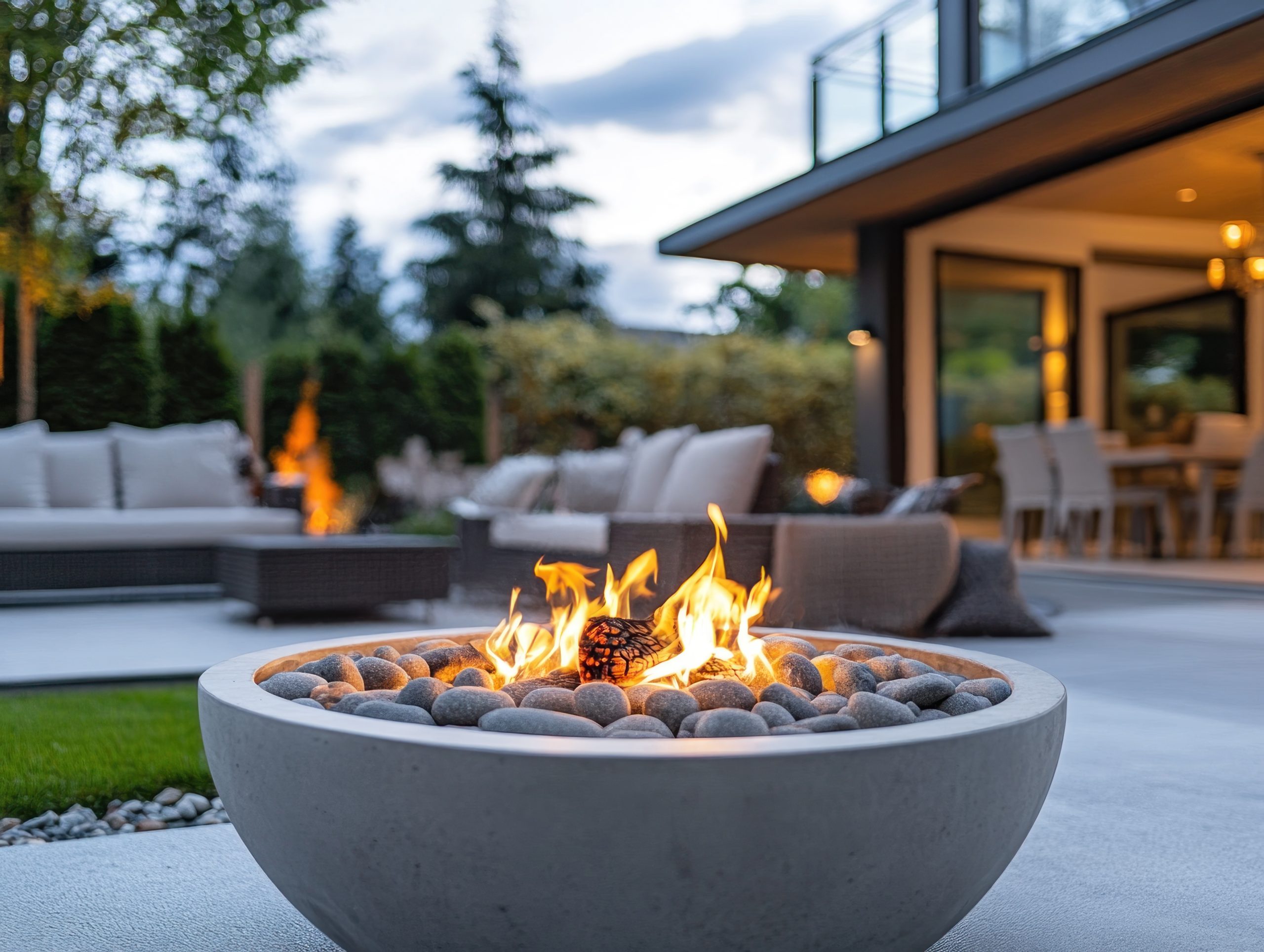
Patio Heaters
Patio heaters offer a practical and convenient way to warm up your winter patio. These devices come in different types, including electric, propane, and natural gas models. Electric heaters are often infrared or radiant and are easy to operate but may require a nearby power source. Propane heaters are popular for their portability, allowing you to move them around your patio as needed. Natural gas heaters offer a reliable and consistent source of heat and are better for those with natural gas lines. When selecting a patio heater, consider the heat output, usually measured in BTUs (British Thermal Units), and the coverage area it can effectively heat. Choose a heater that’s appropriate for the size of your space and be sure to consider safety guidelines for proper use. A heater that can be controlled with a remote is a bonus for convenience.
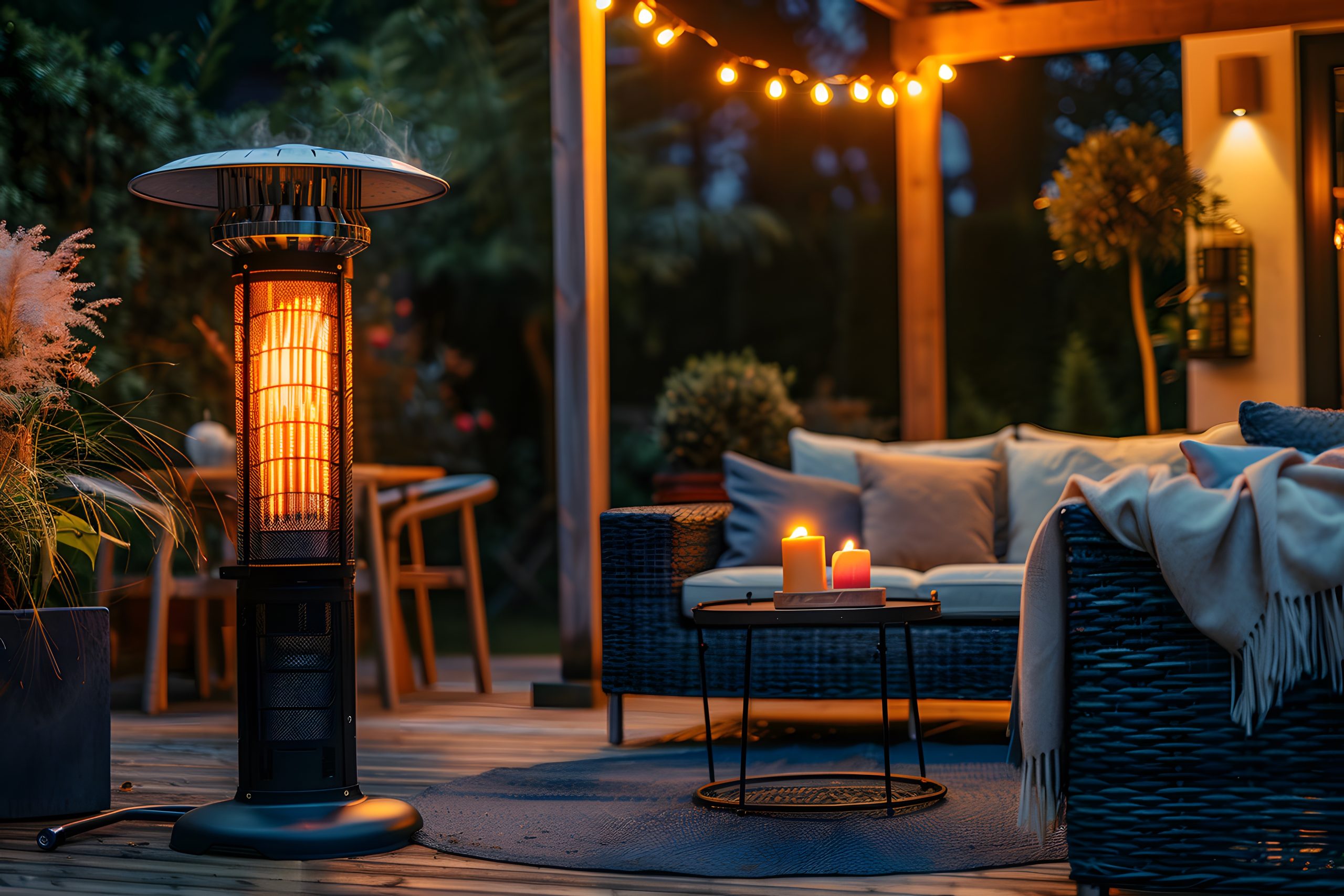
Radiant Heat Options
For those undertaking major patio renovations, underfloor radiant heating is a luxurious option. These systems involve installing heating elements beneath the patio surface, providing consistent warmth that rises from the ground. Though more costly and complex to install, radiant heat is highly efficient, provides an even distribution of heat, and eliminates the need for bulky heating equipment on your patio. This method also doesn’t rely on fans or blowers, eliminating any noise associated with heat sources.
Outdoor Rugs & Textiles as Insulation
Beyond heat sources, the use of durable outdoor rugs and textiles can significantly enhance the warmth and comfort of your winter patio. Select outdoor rugs made from weather-resistant materials like polypropylene or sisal-look synthetics. These materials not only add style but also provide insulation underfoot, making it more comfortable to walk on the patio. Choose rugs with a higher pile for added warmth and texture to enhance the cozy feel. Layering blankets and throws on your patio furniture adds an extra layer of warmth and visual appeal. Choose materials like wool and cotton for natural warmth, or synthetic options like fleece or faux fur for water resistance and easy care. Using durable, easy-to-clean textiles is crucial for the outdoors, and it allows you to add your own style.
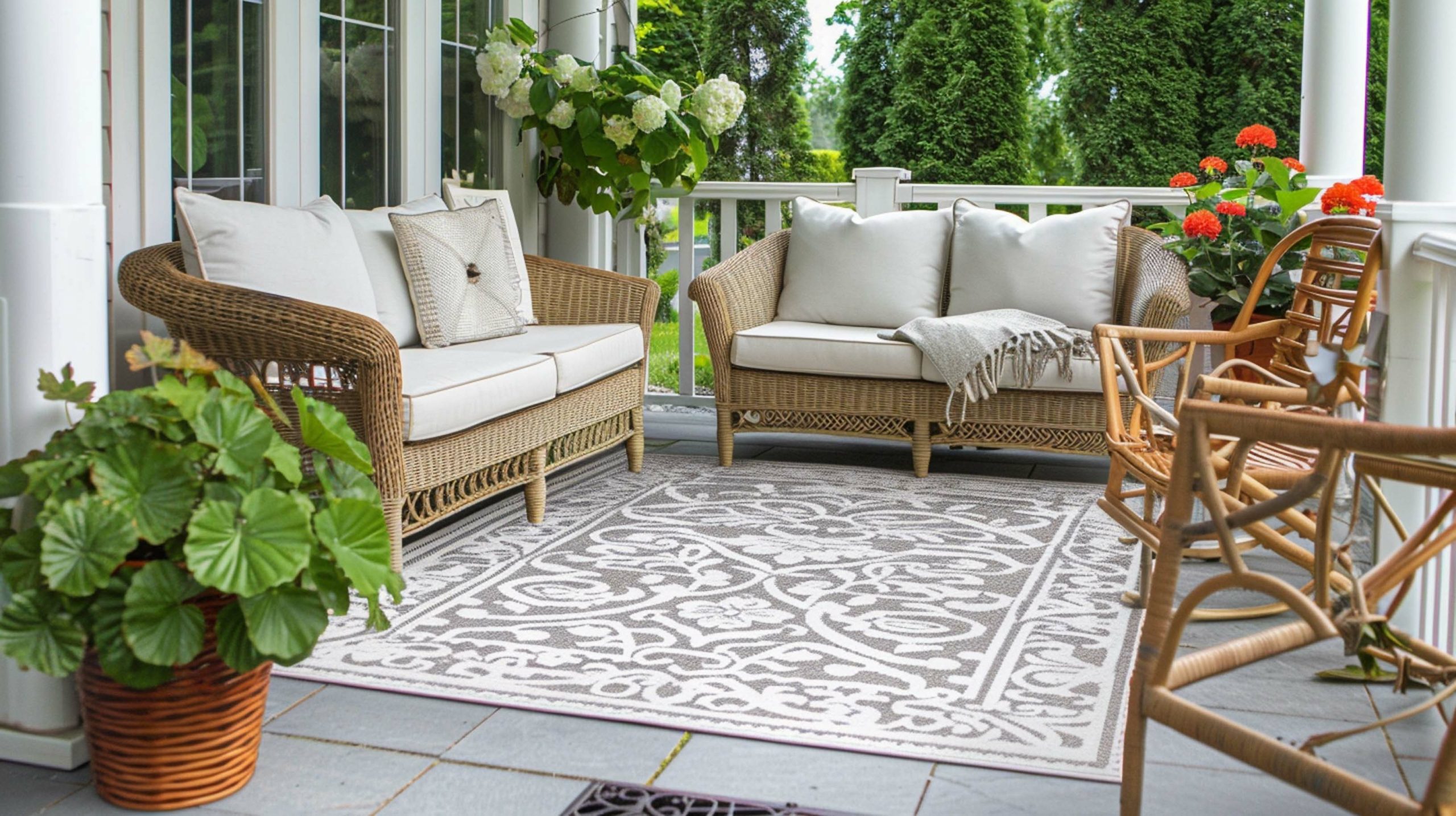
Setting the Mood: Elevating Your Winter Patio’s Style
The right decor is just as important as heating when creating a cozy winter patio. The decorations you choose will help shape the overall atmosphere and make it inviting and comfortable. Let’s take a look at lighting, seasonal decor, and seating arrangements:
The Magic of Layered Lighting
Lighting plays a crucial role in creating a warm and inviting ambiance on your winter patio. Avoid using harsh, single-source lighting, and instead layer multiple light sources for an inviting glow. String lights with warm white bulbs are a popular choice for adding a touch of whimsy and sparkle. Lanterns with flameless candles or real candles (when safely used) can add a soft, flickering light that’s reminiscent of cozy evenings. Directional spotlights strategically placed on plants or art pieces can highlight special features in your outdoor space. Consider using decorative lamps to create focal points of light, adding more texture and design. By combining different lighting sources and styles, you can transform your patio into a magical space. The type and tone of lighting will greatly affect the overall feel.
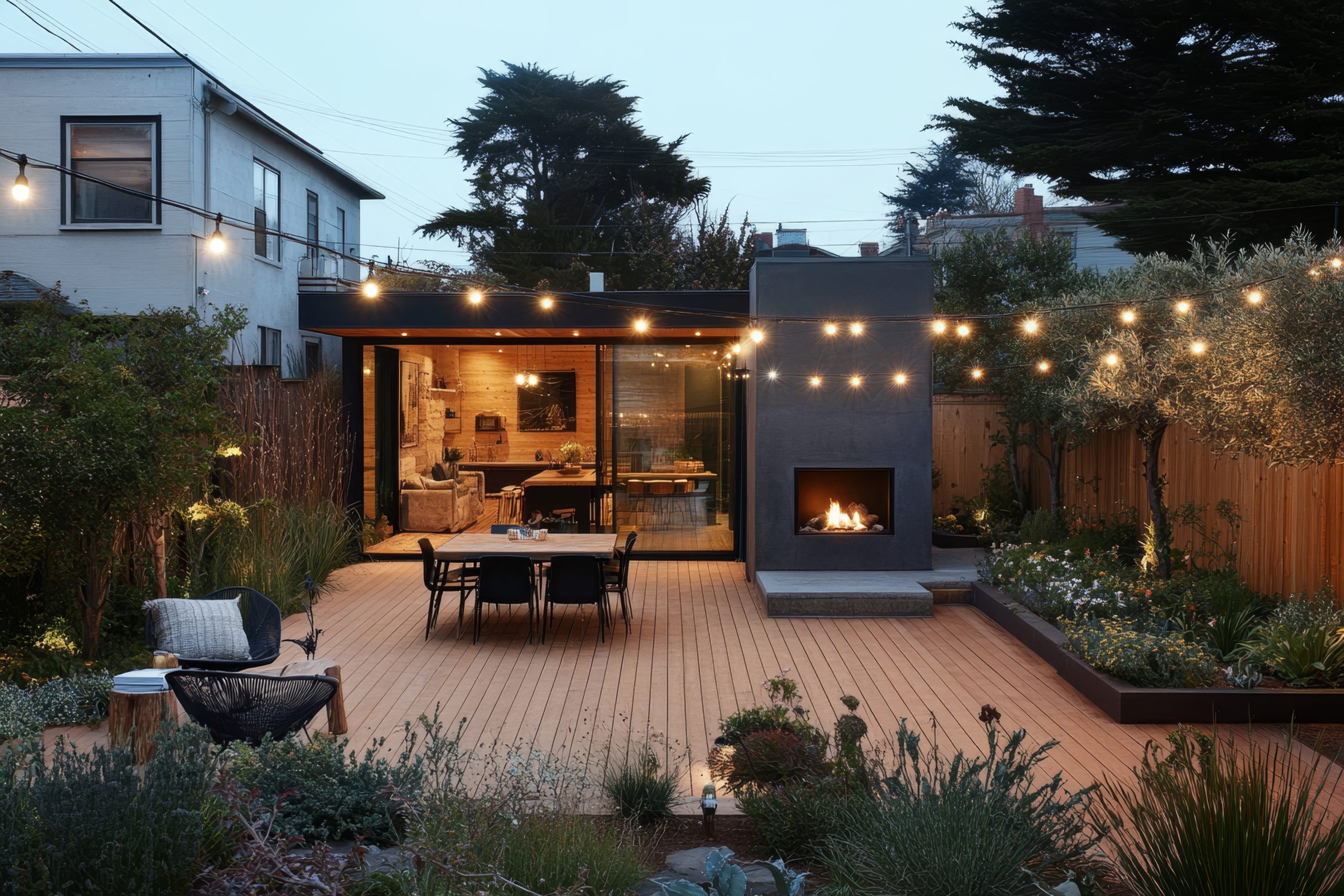
Embracing Seasonal Decor
Adding seasonal decor is a wonderful way to infuse your winter patio with festive charm. Incorporate natural elements like evergreen garlands, pinecones, and berries for a beautiful and rustic look. Use gourds and branches to add a subtle fall or winter design. Don’t be afraid to add a touch of sparkle with metallic accents or shimmering fabrics. For the holidays, you can add festive decorations like lights, ornaments, and wreaths, but ensure that they are made for outdoor use. When using seasonal decorations, aim to create a welcoming ambiance, but don’t feel pressured to go overboard unless you want to.

The Importance of Comfortable Seating
Comfortable seating is essential for creating an inviting winter patio. Choose furniture made from weather-resistant materials like rattan, metal, or treated wood that can withstand cold and moisture. Opt for deep cushions and throw pillows with removable, washable covers to make it easy to keep your seating areas clean and inviting. Consider cushions made with quick-dry fabrics to minimize water absorption. Providing adequate seating for your needs is important, especially if you are entertaining.
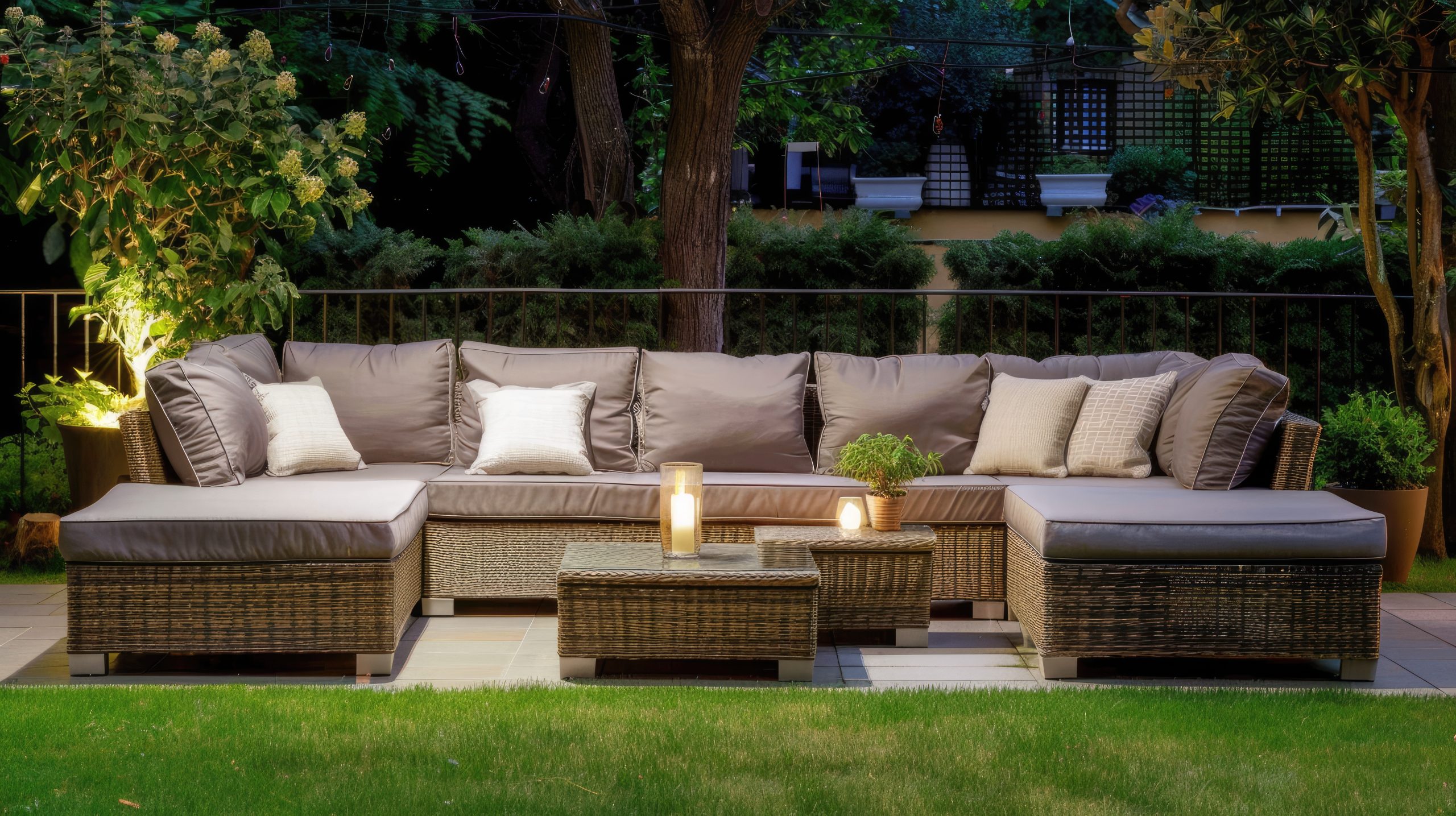
Image Suggestion: An image featuring a luxurious outdoor seating area with ample cushions and throws, showcasing comfort and style.
Preparing Your Patio for Winter’s Challenges
Protecting your winter patio from the harsh weather is crucial for its longevity and your enjoyment. Taking some simple steps now will save you time, money, and hassle later. Let’s take a look at some key areas:
1: Invest in high-quality furniture covers made from waterproof and UV-resistant materials. These covers will shield your furniture from rain, snow, ice, and the damaging effects of the sun. Apply waterproof treatments to wood surfaces and other susceptible materials, following the manufacturer’s instructions. Clear your patio of any items that could be damaged by winter weather, including electronics, delicate decor, or potted plants that aren’t cold-hardy. In preparation for storms or heavy snowfall, make sure to secure any loose items on your patio.
2: Sweeping or blowing leaves and debris regularly will prevent buildup and staining. Clean your patio surface with appropriate cleaners (consider pressure washing for a deep clean). Protect wooden surfaces with sealant or stain. Keep a close eye out for ice build-up and address any slippery spots immediately. Make sure to routinely store any cushions, pillows, or other sensitive items that cannot withstand the harsh winter weather.
3: If your budget allows, consider a covered patio or awning to provide additional protection from the elements. The added layer of protection not only prolongs the life of your patio furniture and accessories, but it also increases the use of your space in any weather.

Image Suggestion: A picture of patio furniture with protective covers on, or someone preparing the patio for a winter storm using a sealant. This should show the practical preparation for winter weather.
Creating a Cozy Winter Patio on a Budget
You don’t need to spend a fortune to create a cozy winter patio. There are numerous ways to transform your outdoor space without breaking the bank. Let’s explore a few ideas:
Repurposing and Recycling
Look around your home and garden for items that you can repurpose. Old pallets can be turned into unique seating or coffee tables. Glass jars can be transformed into charming lanterns by adding tealights or battery-operated lights. Thrift stores often have gently used furniture that can be refinished for your winter patio. Look for creative ways to reuse items you already have, adding both personality and reducing expenses. A little creativity goes a long way in making your space unique and wallet-friendly.
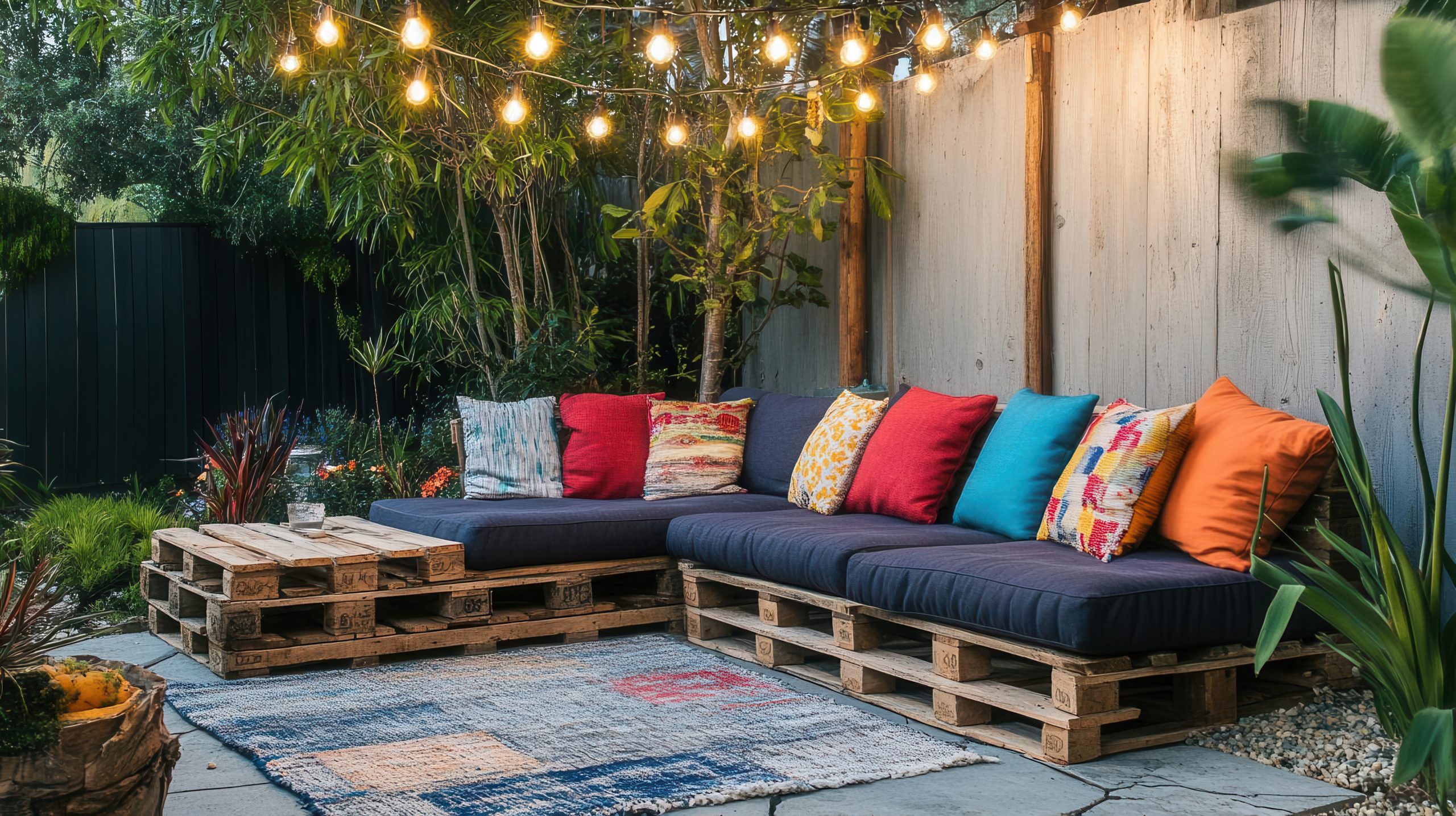
Image Suggestion: A before-and-after photo showing the transformation of repurposed materials, such as pallets turned into seating, on a winter patio.
Simple DIY Projects
There are many simple DIY projects that can add character and coziness to your winter patio. Try painting existing flower pots in bright and seasonal colors. Make your own simple string lights with inexpensive string and lights, or even repurpose Christmas lights. Create DIY outdoor pillows by sewing together fabric scraps, or adding a new cover to an existing pillow. These projects are simple and fun, allowing you to add personal touches while also keeping to your budget.
Smart Shopping Strategies
Look for deals and discounts on seasonal items during the off-season. End-of-year clearance sales are a great way to find discounted furniture, heaters, and other accessories. Second-hand marketplaces can also be an invaluable resource for finding budget-friendly outdoor items. With patience and smart shopping techniques, you can create a stunning winter patio without breaking your budget.
Adding Special Touches to Your Winter Patio
To fully enjoy your cozy winter patio, consider incorporating these additional elements that elevate the ambiance and comfort:
Music and Sound
Adding soft, calming music can greatly enhance the relaxed vibe of your winter patio. Consider investing in an outdoor speaker that blends well with your existing outdoor aesthetic and is also weatherproof. Listen to your favorite tunes or the relaxing sounds of nature to add to the serene atmosphere you have created.
The Scent of the Season
The sense of smell can greatly impact the ambiance of your space. Using scented candles, essential oil diffusers, or outdoor incense to fill your winter patio with warm and inviting seasonal scents will add an extra layer of comfort. Consider scents like pine, cinnamon, or vanilla for a cozy and festive touch. Be sure to practice all safety tips when using candles, and diffusers.
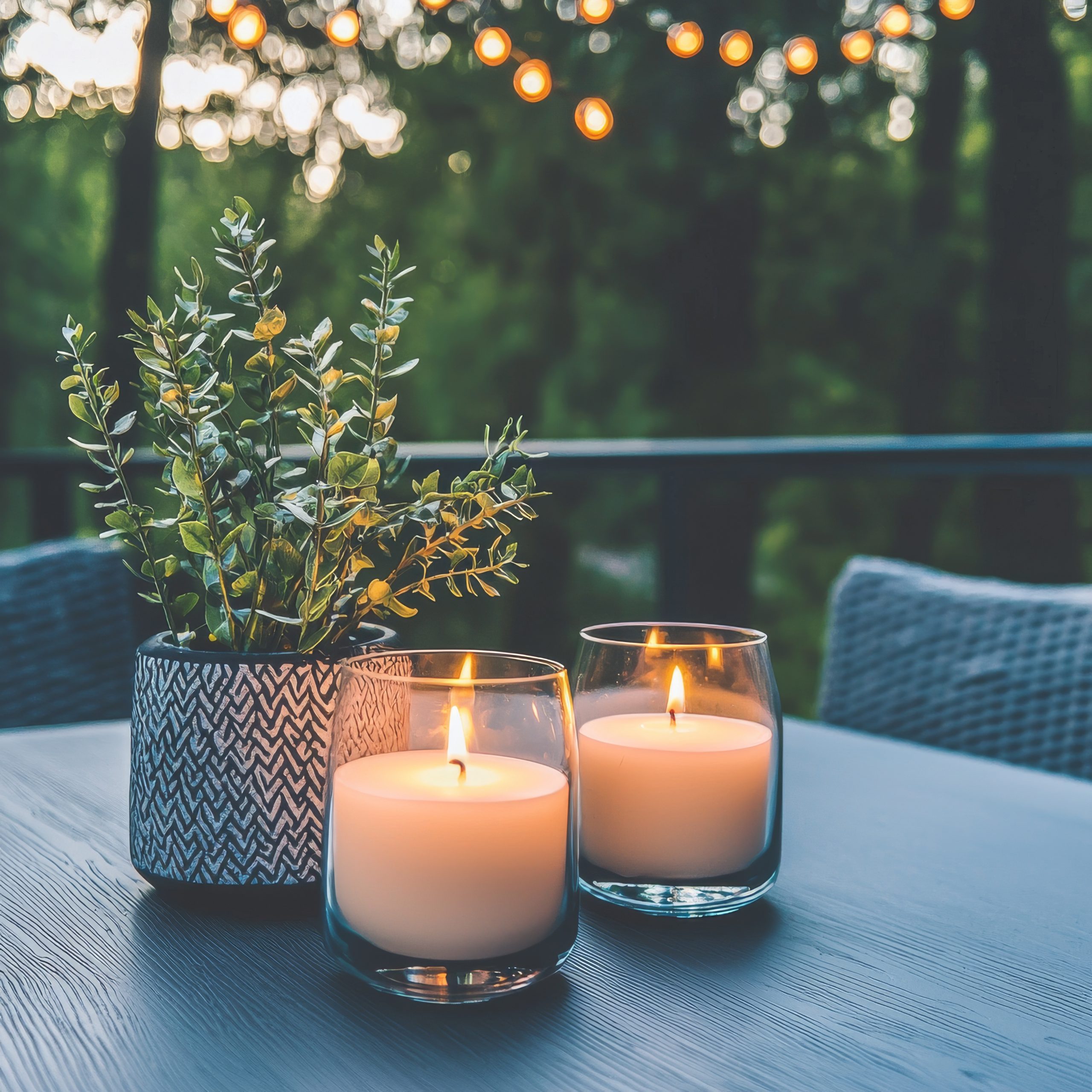
Outdoor Games
If you are interested in incorporating some activity into your space, try setting up an outdoor game area. Even on colder days, some fun and friendly competition can add to your winter patio. Consider setting up an outdoor game like a large chess set, cornhole, or even a simple board game that can be played on your outdoor table.

Creating a cozy winter patio is not just about extending your outdoor season; it’s about creating a space that promotes relaxation, enjoyment, and connection with nature throughout the year. The possibilities are endless, from selecting the right heating solutions to incorporating stylish decor, weatherproofing your space, and finding budget-friendly ways to create a cozy haven. Embrace the cooler months and unlock the full potential of your patio by experimenting with the ideas discussed in this guide.
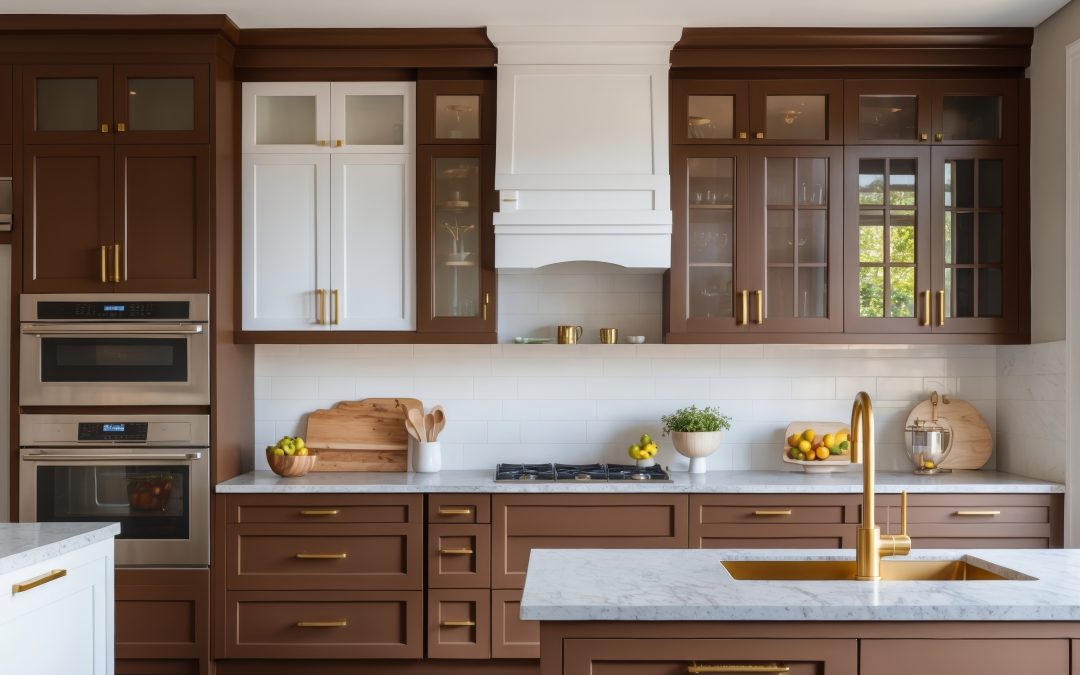
by Kesaa Interiors | Kitchen, ROOMS, Storage & Organization
This post is all about Kitchen Organization Ideas.
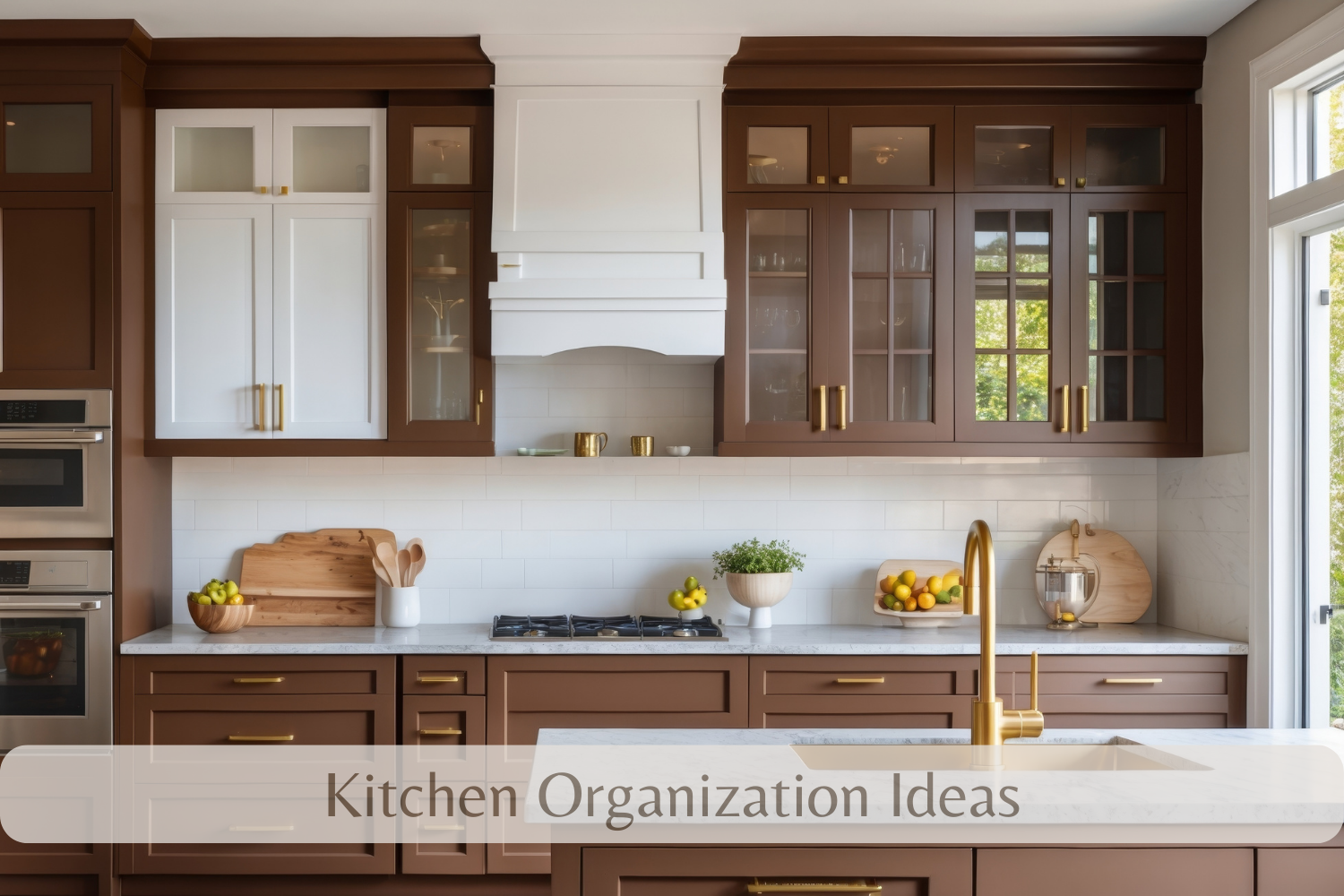
Is your kitchen more chaos than cooking? We get it! The heart of the home often becomes a battleground of overflowing drawers, mismatched containers, and countertops buried under clutter. It’s frustrating and time-consuming, and frankly, cooking and meal prep can feel more like a chore than a joy. Dreaming of a kitchen where everything has its place, where you can easily find that spice jar or the right-sized lid without a scavenger hunt?
By the time you’re done reading this, you’ll have a toolbox of ideas and inspiration, ready to transform your kitchen into a well-organized space that will save you time, reduce frustration, and, ultimately, make your life a little bit easier. Ready to reclaim your kitchen? Let’s dive in!
Smart Kitchen Organization Ideas
Ready to reclaim your kitchen? Let’s dive into 15 kitchen organization ideas you can implement today to create a more functional and enjoyable space.
Drawer Dividers for Utensil Harmony
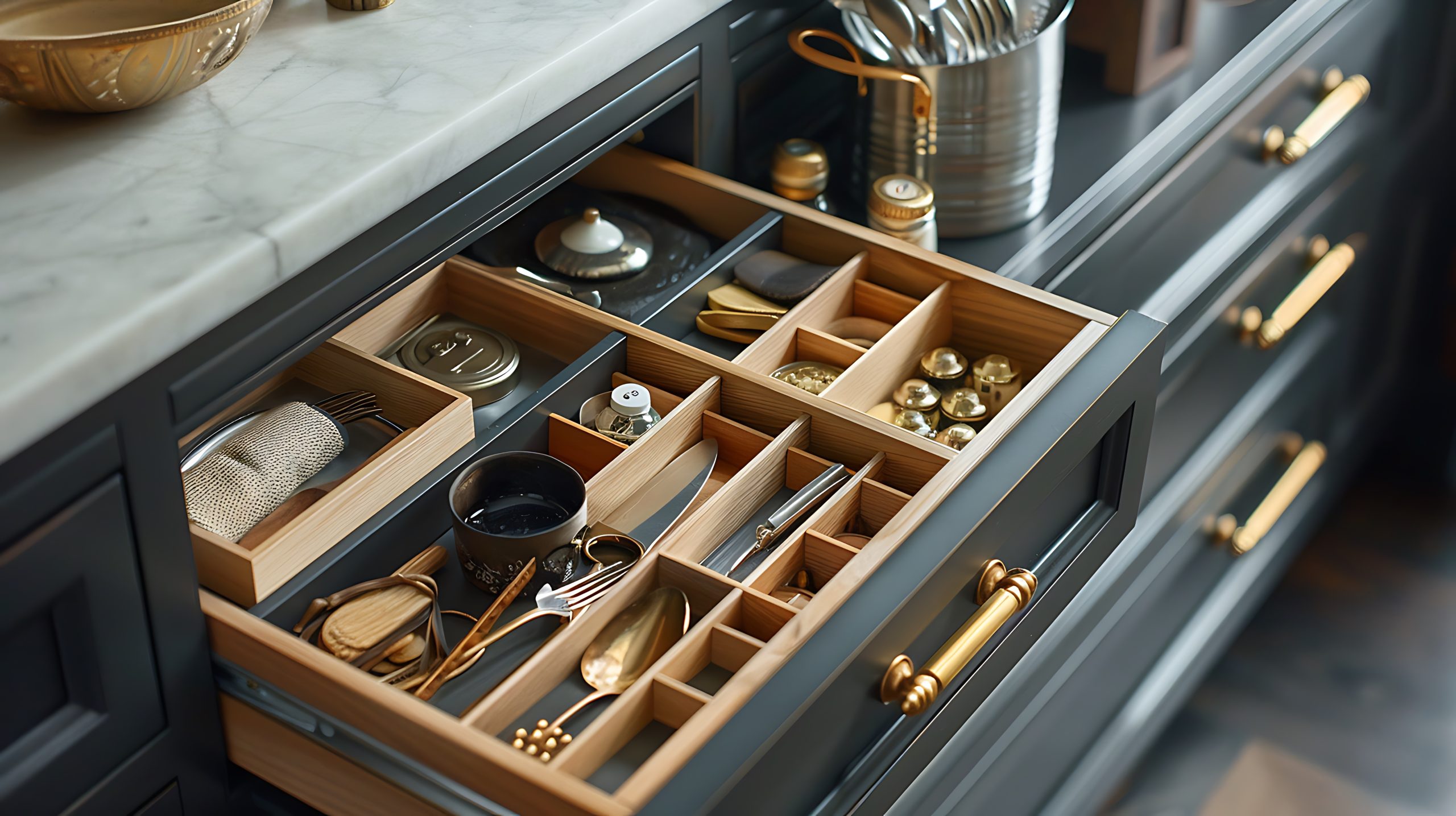
We’ve all been there – the utensil drawer that’s a chaotic jumble of spoons, spatulas, and that one whisk you can never seem to find. The simple solution? Drawer dividers! These handy tools are absolute game-changers when it comes to keeping things separate and easy to find. Not only does this help you locate what you need quickly and reduce clutter, but it also prevents your utensils from scratching and clanging against each other. Plus, when each item has a designated space, you’ll save time not having to dig around in messy drawers, keeping the kitchen cleaner and your stress levels lower! Think of it as giving each utensil its own tiny, perfectly-sized home.
For versatility and style, look for expandable dividers, preferably made from natural materials like bamboo, that can easily adjust to fit your drawers. The adjustability ensures a good fit, and bamboo will add an element of elegance, or if you’d rather a modern option, consider clear acrylic dividers to give it a clean feel.
Vertical Storage: Tiered Shelves and Risers
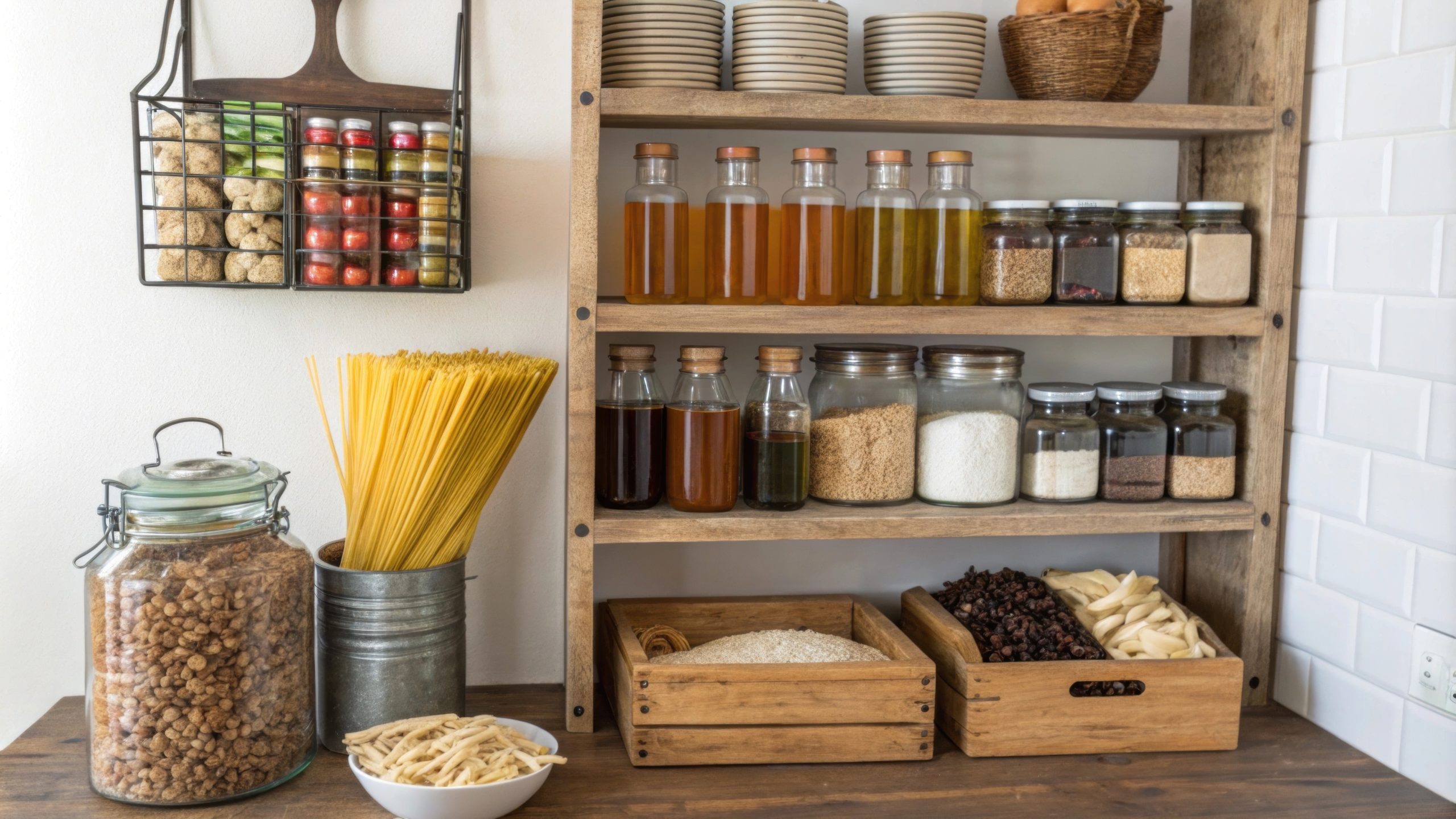
When it comes to kitchens, you might often find yourself limited on space, but using vertical space wisely is essential for maximizing space and getting items up and out of the way. Tiered shelves and risers are your secret weapon for cabinets and countertops! They work by elevating items, allowing you to easily see and reach those things that get pushed to the back. These aren’t just for your pantry; try using them to organize spice jars on your countertop, or to make stacks of plates or cups more visible and easy to reach in your cabinets. This method makes use of that often-overlooked height, prevents items from becoming lost in the shuffle, and makes everything so much easier to grab. No more stacking and toppling – everything has its place.
Look for a tiered shelf or riser that will maximize the vertical space in your cabinets, with shelves spaced in ways that can store more items in them. Or choose ones made with durable materials that can help showcase some of your most used kitchen tools and essentials on your counter.
Pull-Out Shelves in Cabinets
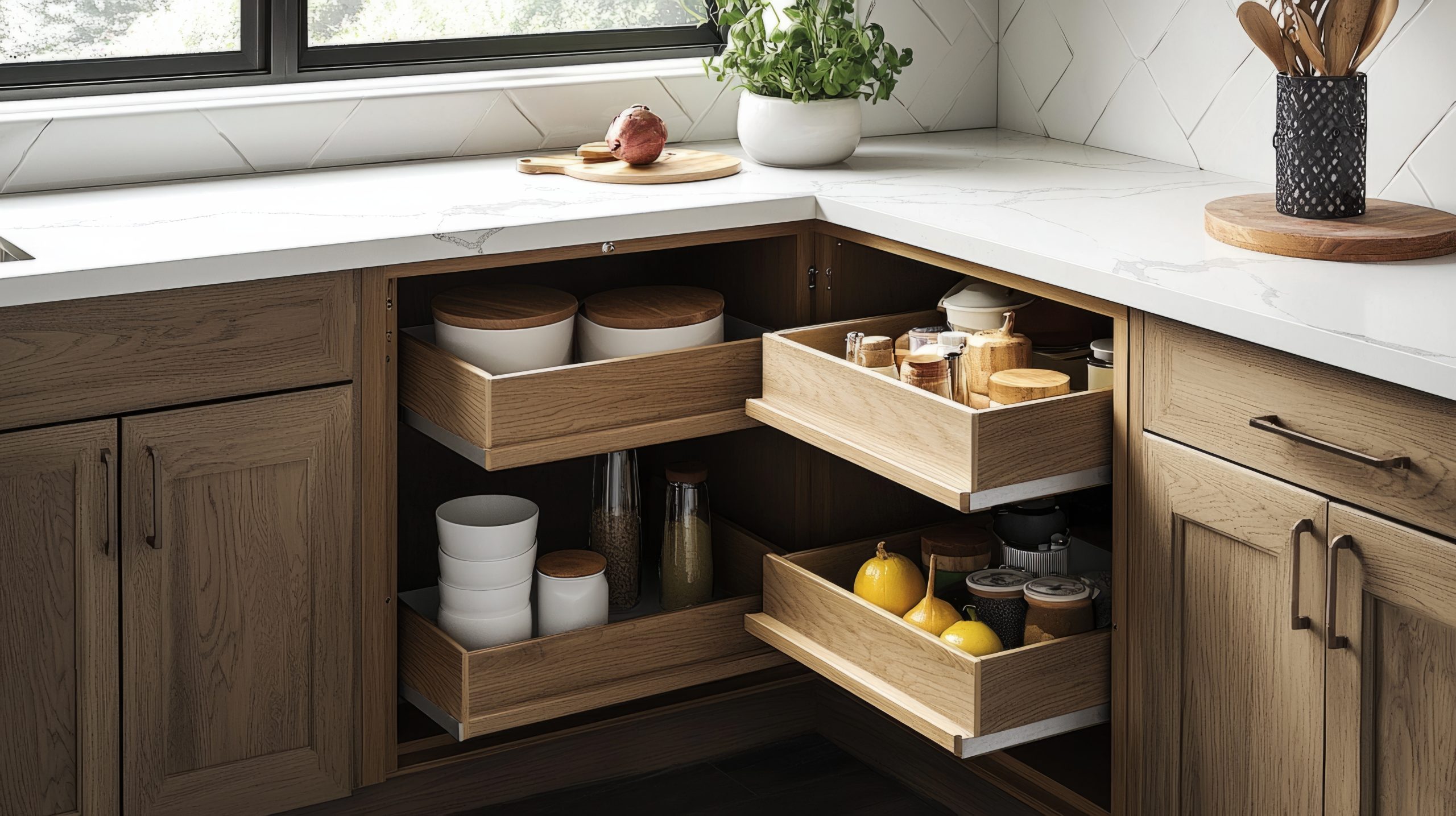
Reaching the items at the back of deep cabinets can often feel like a daunting task. But with pull-out shelves, those awkward spots suddenly become functional and easy to access. These shelves slide out smoothly, bringing everything right to you, saving you from the hassle of rummaging blindly. They’re particularly great for storing heavier pots, pans, or bulky items, preventing them from getting lost in the far corners.
By maximizing storage space from the front to the back, it can help avoid double storing the same things. Pull-out shelves will transform those frustrating areas into a more efficient and accessible storage solution. They are easy to install on any cabinet, and make sure your storage is not in vain and nothing will ever be lost in the back of those hard-to-reach cabinets. While you don’t buy pull out cabinets off the shelf, consider implementing a solution to easily slide them out to reach even those hard to reach back of your kitchen cabinets.
Cabinet Door Organizers
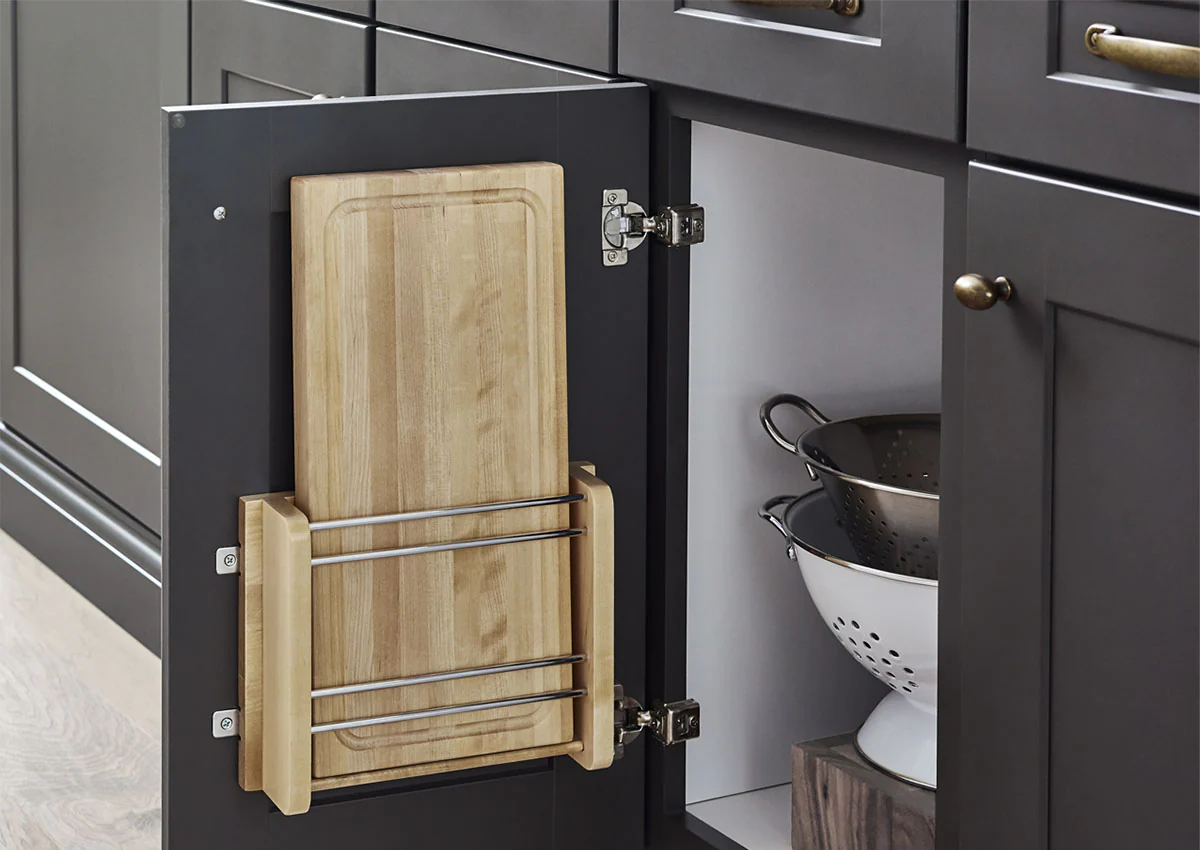
Don’t let that valuable real estate inside your cabinet doors go to waste! Cabinet door organizers are incredibly versatile, providing a place to store a variety of kitchen essentials you’d otherwise leave on the counter or stuffed into a drawer. They’re especially great for awkward, thin items like cutting boards, foil, wraps, or even cleaning supplies. By mounting organizers to your cabinet doors, you’re utilizing unused space, keeping your items accessible but hidden away from the counter, which is helpful when keeping the kitchen more neat and tidy. Consider it as doubling your storage without taking up any more space!
For an all-around, versatile solution, We suggest an over-the-door organizer with multiple tiers and compartments. Look for a sturdy design with secure hooks to ensure it can hold its weight, as well as varied compartments to fit foil, wraps, and even cleaning supplies to ensure they stay in place while closed.
Utilize Clear Containers for Pantries and Fridges
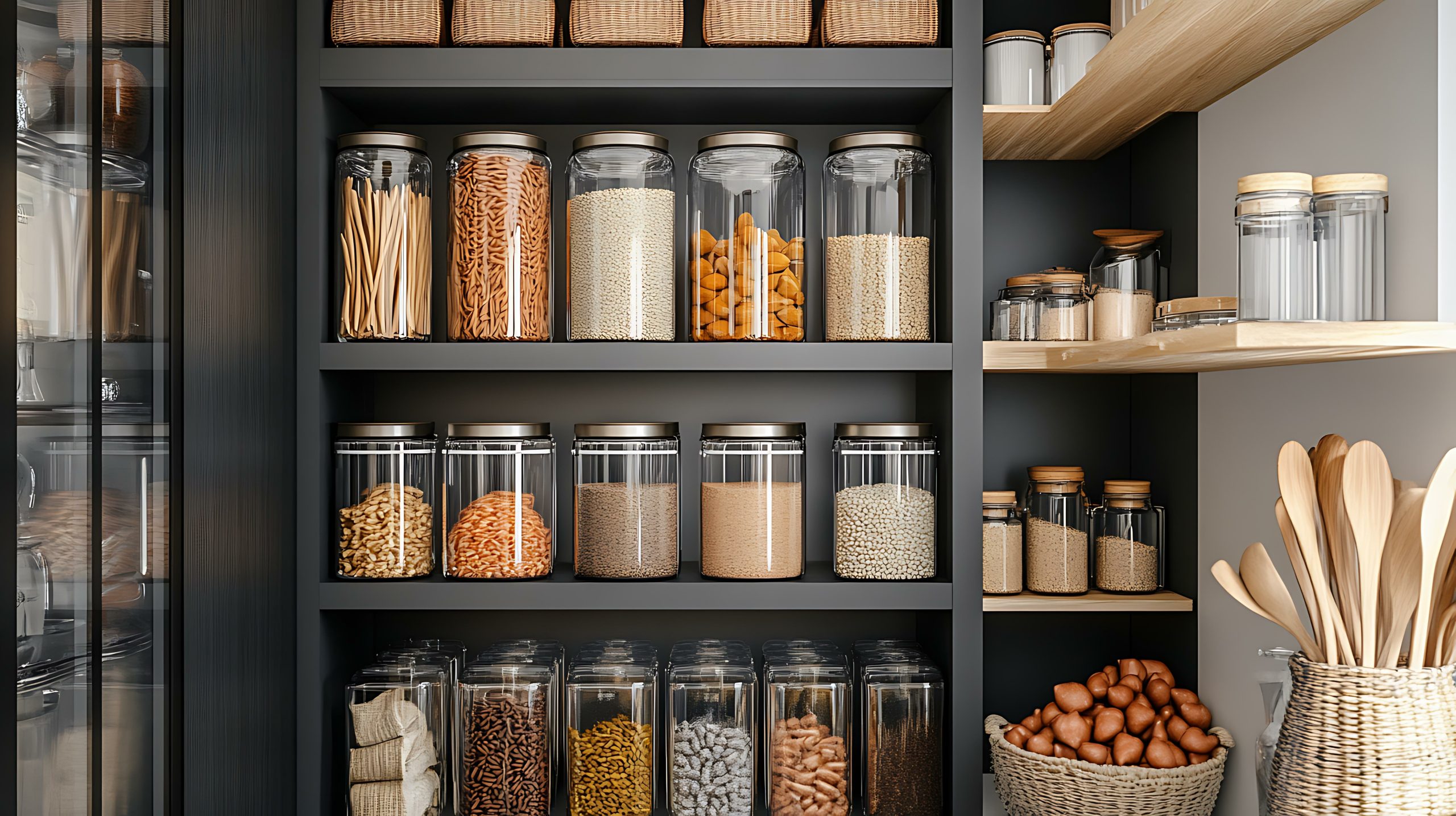
Transparency is key when it comes to effective kitchen organization. Using clear containers for both your pantry and refrigerator allows you to instantly see what you have, preventing you from overbuying and letting food go to waste. Ditch the opaque packaging and swap to jars for your dry goods to maximize freshness and the visual of seeing the product, or consider organizing produce using see-through bins for the refrigerator to better see what’s in there and group them by type. These clear containers not only help you see what needs to be used, but they also create a more uniform and visually appealing space. They bring a sense of calm to chaos and encourage you to eat what you have, ultimately reducing waste and saving you money. It’s about taking the guesswork out of the storage and having a visually organized look of your pantry.
For dry goods, we recommend using classic, well-sealing glass jars for dry goods; they are beautiful and functional for storage, and if you choose a matching set of see-through bins in various shapes and sizes for your refrigerator and pantry, this will help maintain a clean and sophisticated look.
Label Everything Clearly
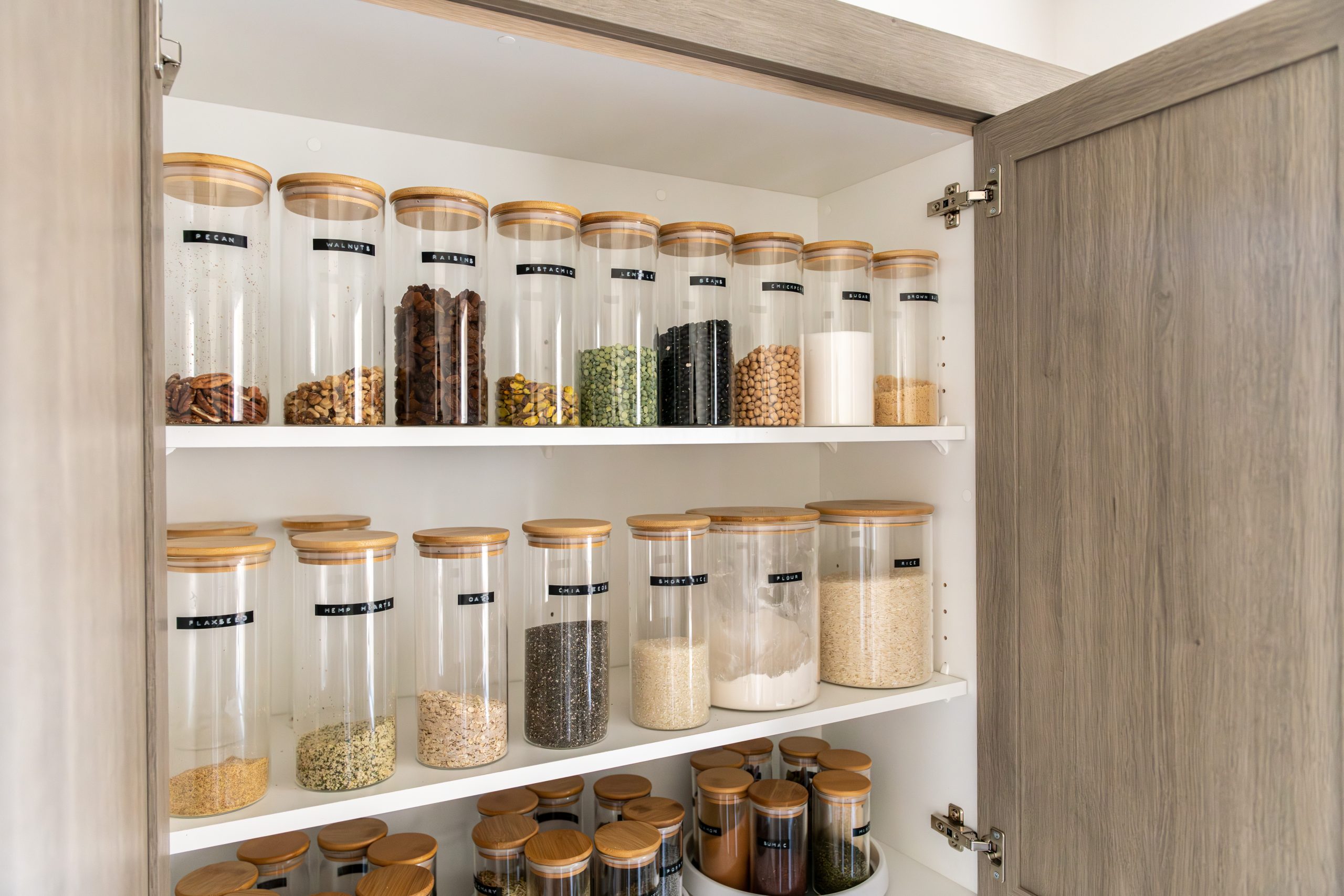
Even with the best intentions for clear containers and visible storage, it’s easy to lose track of what’s what in your kitchen, so labeling is absolutely vital for lasting organization. Clearly labeling all of your containers, drawers and bins ensures that the system doesn’t break down over time, and especially helps any additional help in the home to also participate in keeping the space tidy.
Whether it’s a simple waterproof label for identifying the spices, or a handwritten label on storage jars with the date the item was purchased, having your storage organized is half the battle, but making sure the labeling is consistent can be the key to keeping a well-organized kitchen.
Utilize Wall Space: Hooks & Hanging Racks
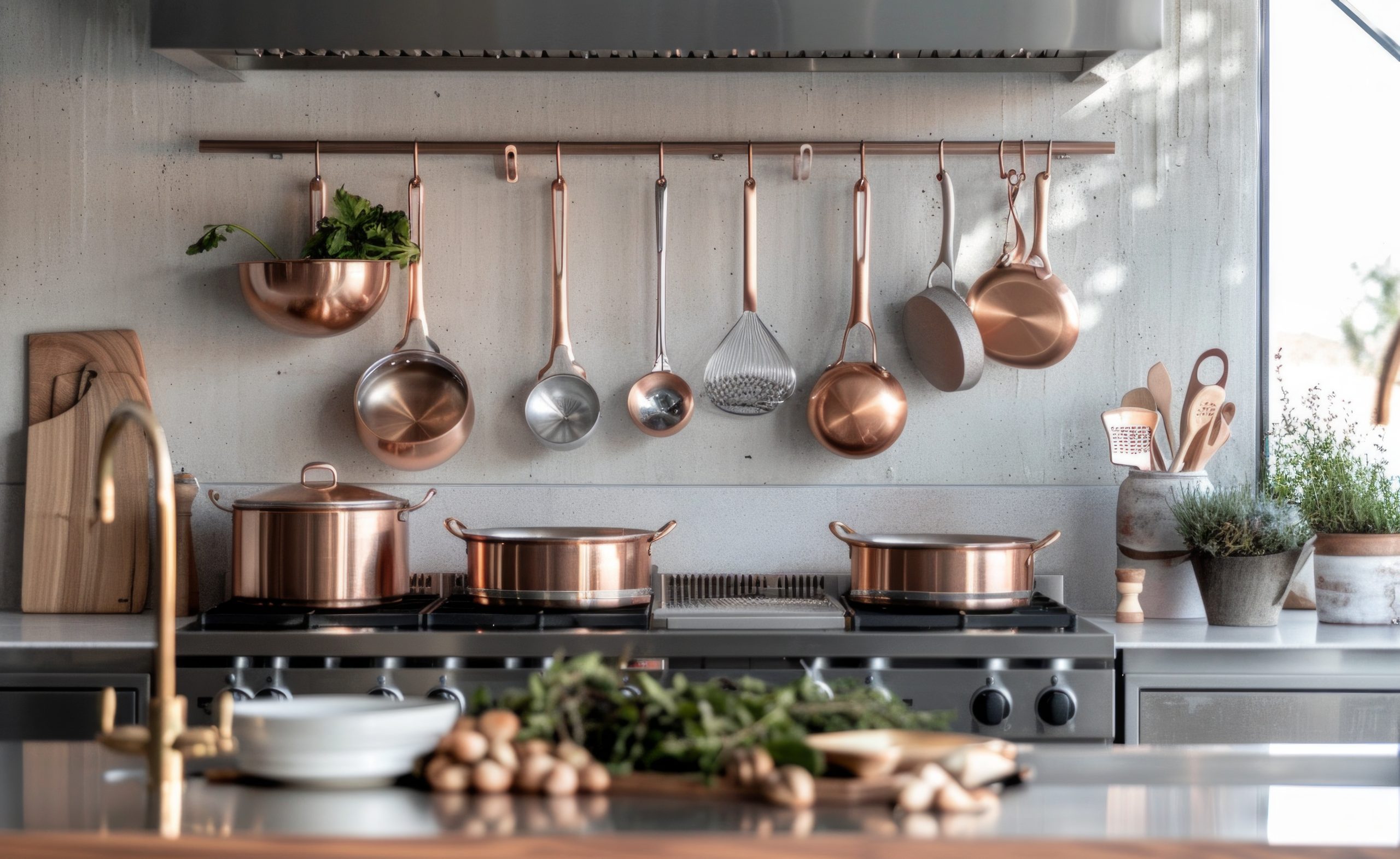
In many kitchens, wall space is often an underutilized resource. Why let your walls be blank when they can be the perfect place to keep utensils, pots, or even cutting boards within easy reach? Hooks and hanging racks can free up drawer and countertop space, providing you with convenient storage that’s not only functional but adds character to your kitchen.
From sleek metallic racks for hanging your pots and pans to stylish hooks for your most-used utensils, utilizing wall space allows you to see what you have and prevents items from being buried in drawers and cabinets. This also adds an element of charm and display into the functional kitchen space, so that your kitchen essentials are not only convenient but beautiful.
Rolling Cart Kitchen Storage
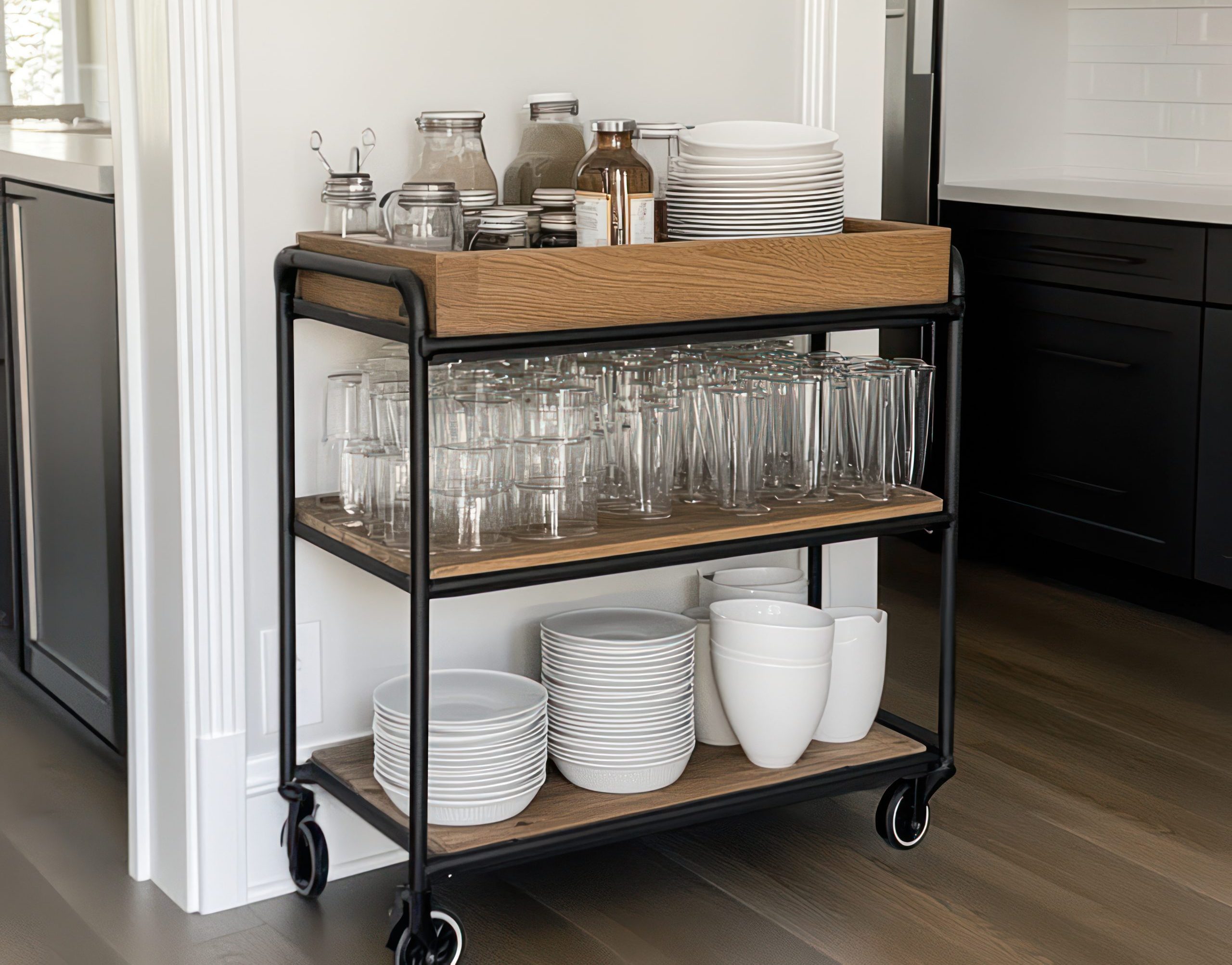
Need a little extra storage, but don’t want to commit to a permanent addition? Consider a rolling cart! This versatile piece is your flexible friend in the kitchen, providing extra storage wherever you need it, whenever you need it. Whether you need a temporary kitchen island for prep space, extra storage during gatherings, or just a handy place to keep your frequently-used items, a rolling cart provides an all-around movable and convenient solution. They’re perfect for small kitchens where space is limited, or can serve as a secondary prep area in larger kitchens. They’re also incredibly easy to customize with baskets and containers. It’s a convenient and effective option for a kitchen in a small space, or can serve as the perfect addition in a larger one, to provide even more storage to meet all your needs.
Look for a well-built cart that rolls easily and is suited to the aesthetic of your kitchen with sturdy shelves to handle your varying kitchen tools, for a sleek, modern aesthetic, metal rolling carts work wonderfully, Choose one based on its durability and what storage needs you may have for the kitchen space.
The Power of a Lazy Susan
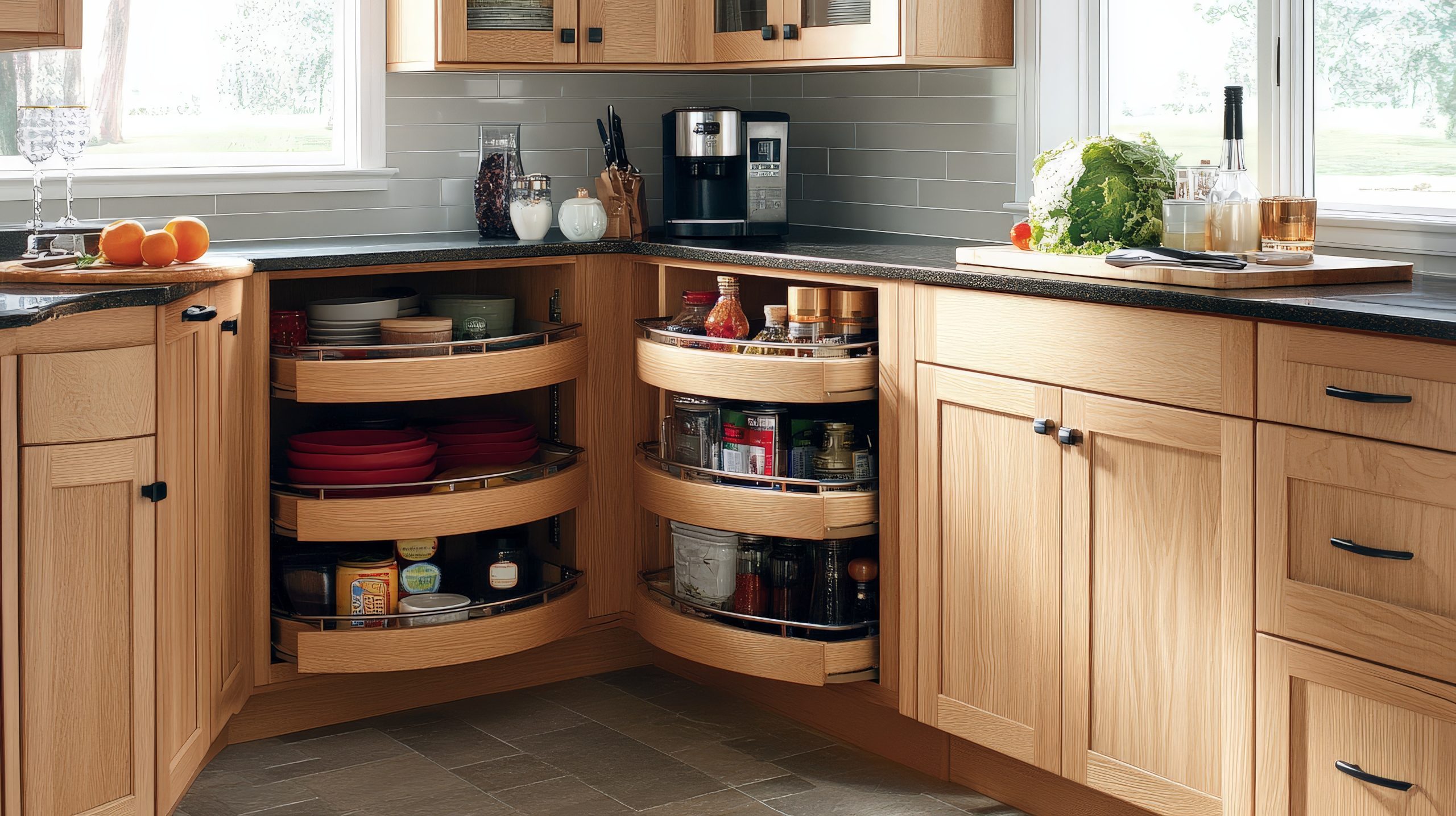
Corner cabinets – the bane of many kitchen organizers! The items you put in the corners end up being forgotten, since they are harder to see and difficult to reach, but fear no more! The simple solution to corner storage is to bring in the Lazy Susan. This rotating turntable makes reaching anything that might be tucked into the back of your cabinet is suddenly effortless. You can also place them on your countertops and they also work great in the fridge for storing sauces or spices that often get forgotten. They bring everything to the front so you’re no longer blindly searching or losing items in the back of hard-to-reach cabinets or counter space. This will keep your items from being lost and forgotten about and ensures that you are getting the full use of your space.
Opt for a tiered or multi-level lazy susan, or try a variety of them for different use. Bamboo is a stylish and sustainable option, while plastic is a great durable and easy-to-clean pick. Consider your color aesthetic and overall style when choosing a Lazy Susan to use, to be sure it matches with your existing kitchen pieces. You can find a great range at a store like the Container Store or Bed Bath & Beyond. Consider choosing a rotating tray based on where you might plan to store and use this kitchen storage.
Pot and Pan Lid Organizer
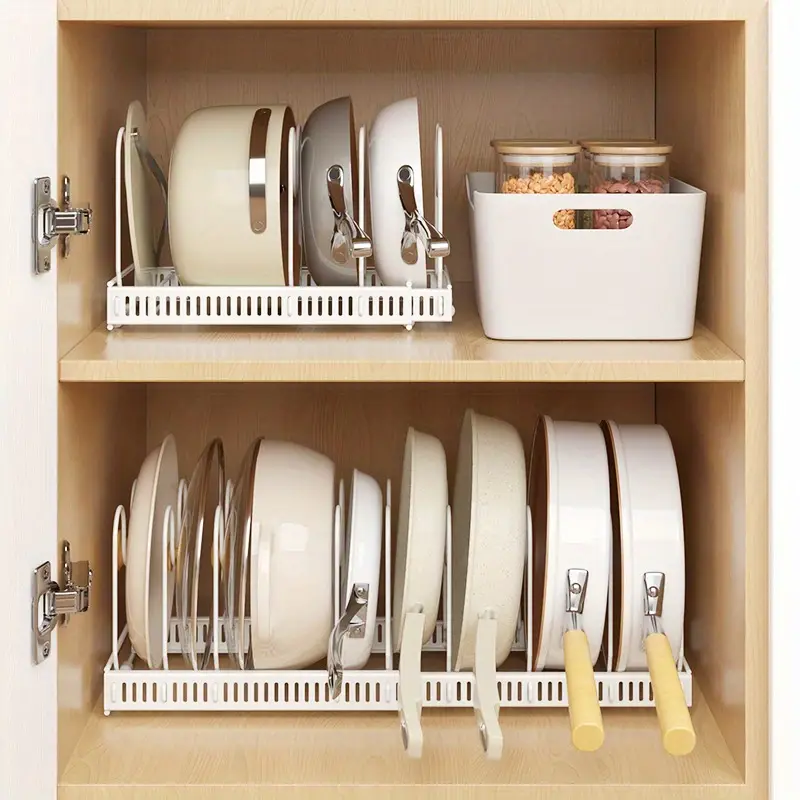
Let’s face it, pot and pan lids are the awkward items in our kitchens. They’re often stored haphazardly, creating a noisy, clanging mess in drawers or cabinets. They seem to pile up and make a disheveled scene if left untamed. A dedicated pot and pan lid organizer can bring order and peace into this chaotic storage situation. These organizers keep your lids separated and neatly arranged, preventing scratches and making it easy to find the right one when you need it.
By having a specific place for these notoriously clumsy kitchen items, you’re optimizing your space and making meal prep a much smoother and organized experience. This not only avoids damage but keeps those items from flying out every time the drawer or cabinet is opened. Look for adjustable organizers that can accommodate different lid sizes and thicknesses, or try using vertical racks to stand the lids up in the cabinet. Consider the spacing between the vertical bars to make sure it will properly hold and keep them in place without falling out
The Magic of the Dish Drying Rack
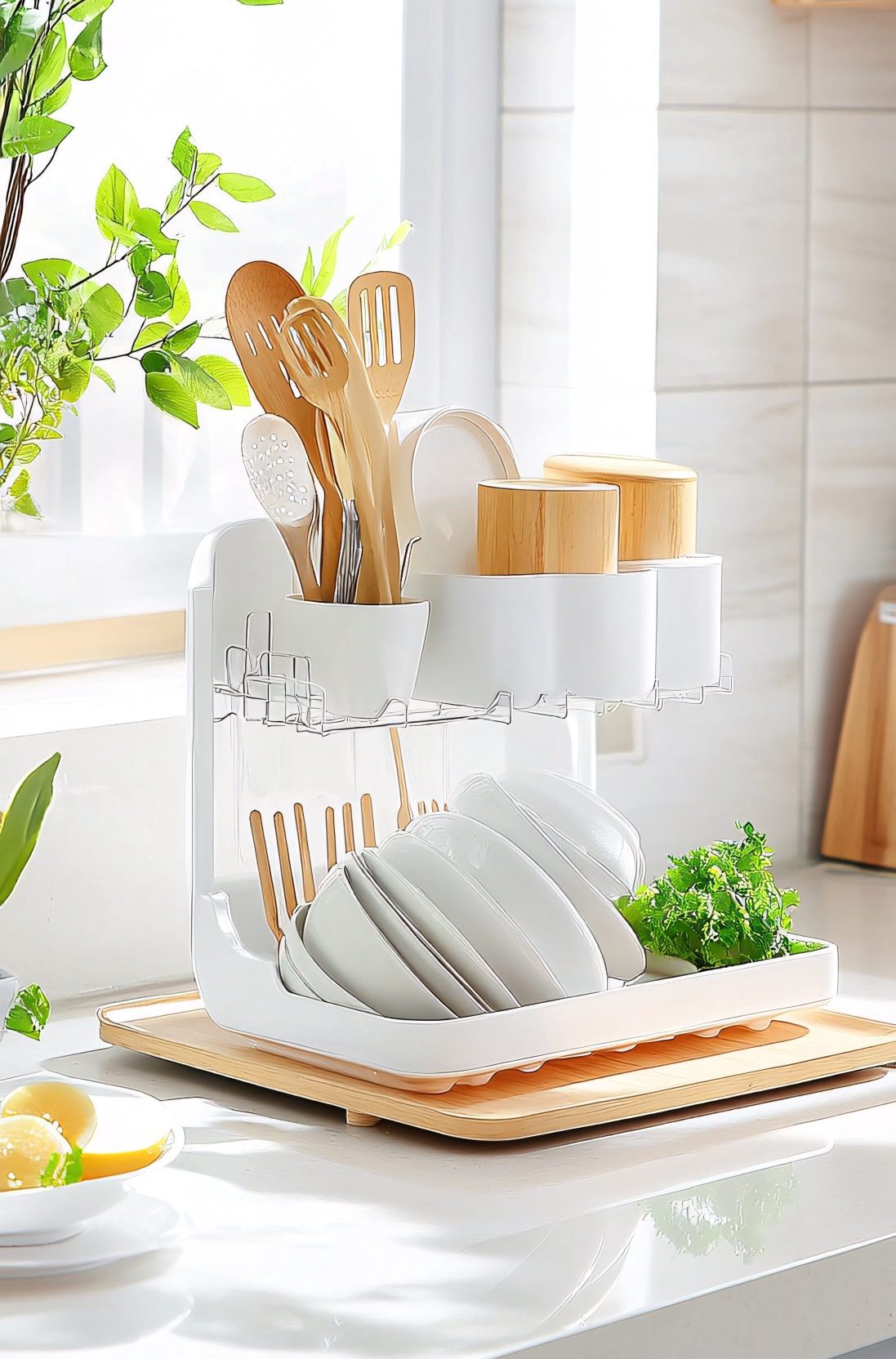
Leaving dishes to dry on the counter can be inconvenient and create a cluttered mess, and no one wants to deal with a wet counter top from soggy drying dishes. The simple solution? A stylish and efficient dish drying rack! This will provide an immediate and convenient solution to dry your dishes properly and efficiently, instead of having a chaotic array of wet dishes left on the counter to dry. This simple piece not only keeps the counter space free and tidy, but makes the post-meal cleanup so much easier. Consider how often dishes are washed and if your drying solution is actually functional for your needs and your space, because the simple solution can help avoid a lot of clutter in the kitchen.
Consider what kind of drying rack fits into your style and space. If you’re limited on counter space, there are a variety of slim and efficient designs, such as foldable or roll-up drying racks that can be stowed away when not in use. For those with a more permanent need, a sleek dish rack with a built in tray can create a contemporary style while efficiently keeping your dishes properly organized.
Under the Sink Organization
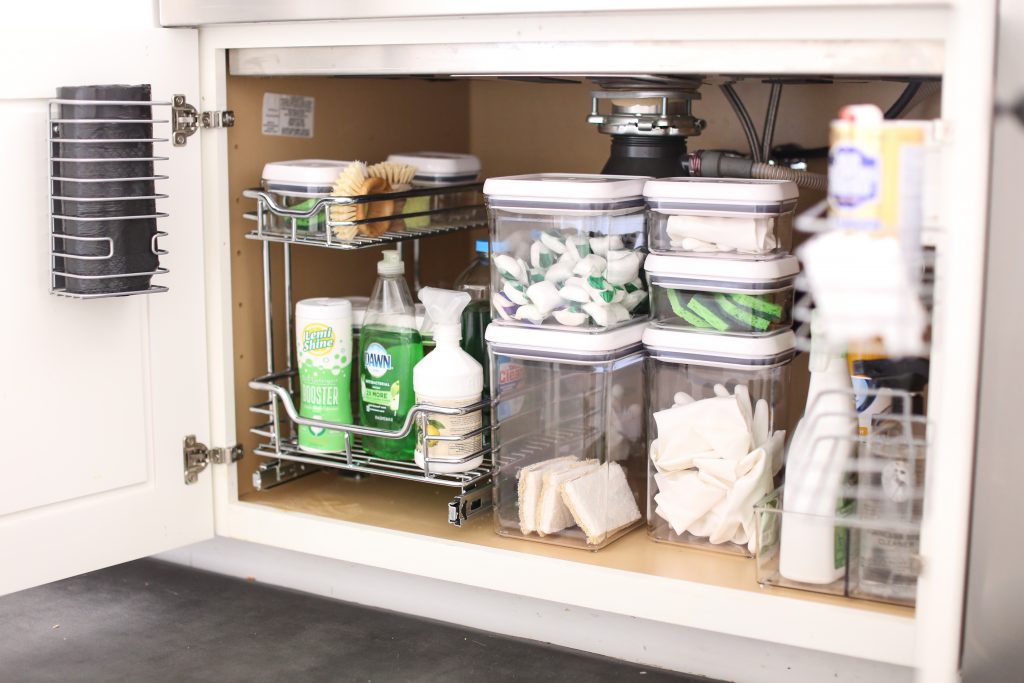
The space under the sink often ends up being a chaotic catch-all, a messy area that’s often neglected, but this area is one of the most crucial parts to get organized. From cleaning supplies, dish soap, and sometimes extra sponges and paper towels get haphazardly shoved under the sink, but it doesn’t have to be. Consider lining the bottom of your under-the-sink cabinet with a waterproof liner or tray to protect the cabinet from spills, and use caddies or organizers to neatly group similar items together, such as cleaning sprays, cloths, and dish soap. Adding a tiered organizer can maximize space by using the vertical height under the sink to bring smaller items forward so they are not lost in the back.
By adding small adjustments and creating organization under your kitchen sink, this creates a smooth, streamlined process of accessing your kitchen supplies to maintain a tidier kitchen. Look for sturdy, waterproof organizers with handles that make it easy to take supplies out of the cabinet, or consider a tiered organizer to make the most out of your vertical space. You can often find great caddy sets or drawers from the Container Store.
First in, First Out Pantry Rotation
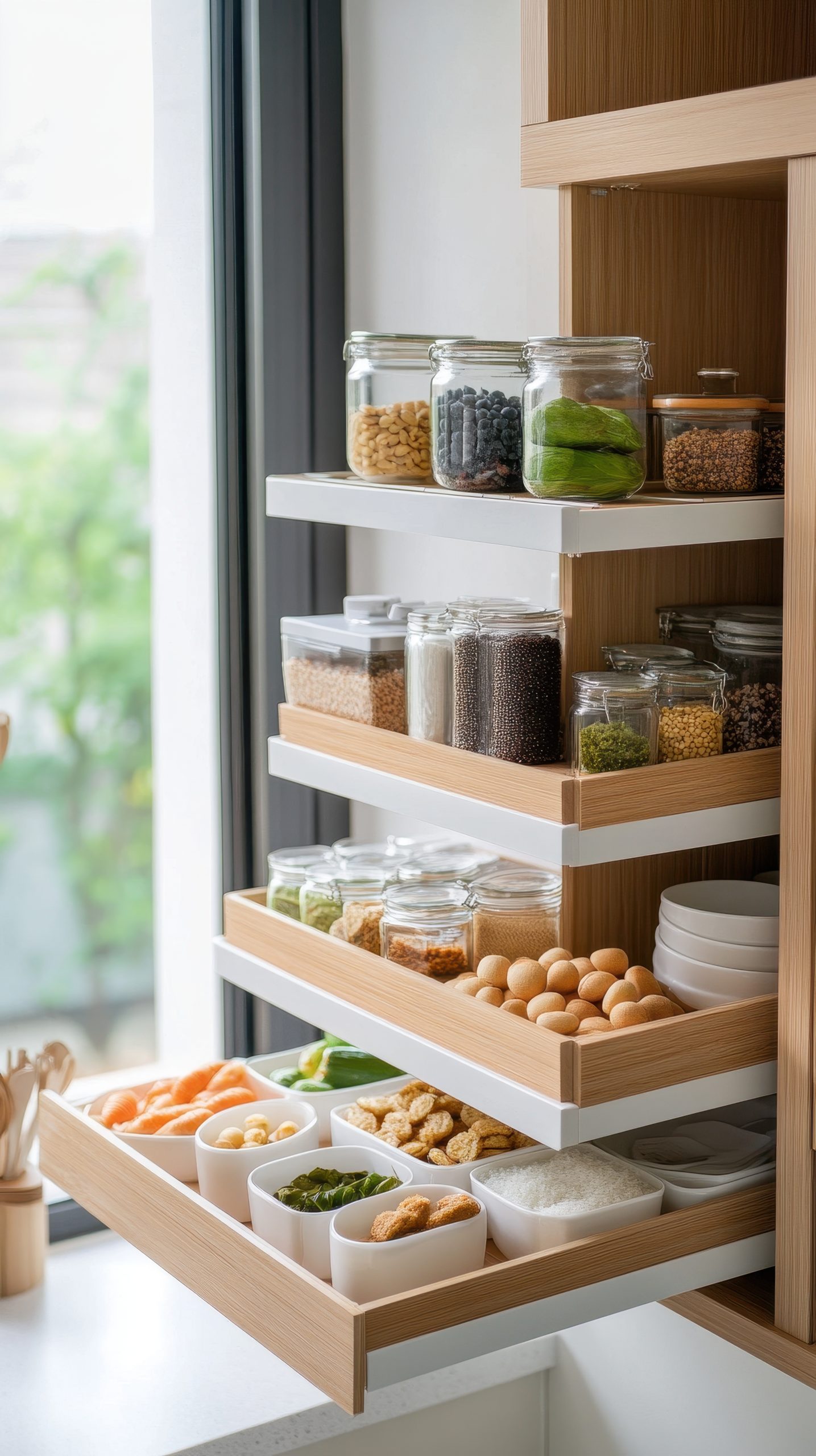
How often do you reach into the back of your pantry and find something expired? It’s a common issue when you just pile new items in front of the old ones, but the “First In, First Out” method (FIFO) can help to prevent that! This involves making a habit of using the oldest items first before reaching for the new ones. When you come back from the grocery store, always move your older products forward and put the newer purchases behind them. This can help to reduce food waste and save money by making sure food items don’t get lost and forgotten about in the back of the pantry. Implementing FIFO doesn’t have to be complicated; it’s just a matter of shifting your habits and adding new food purchases to the back, so that older items get used first and avoid expiry dates.
Create Zones
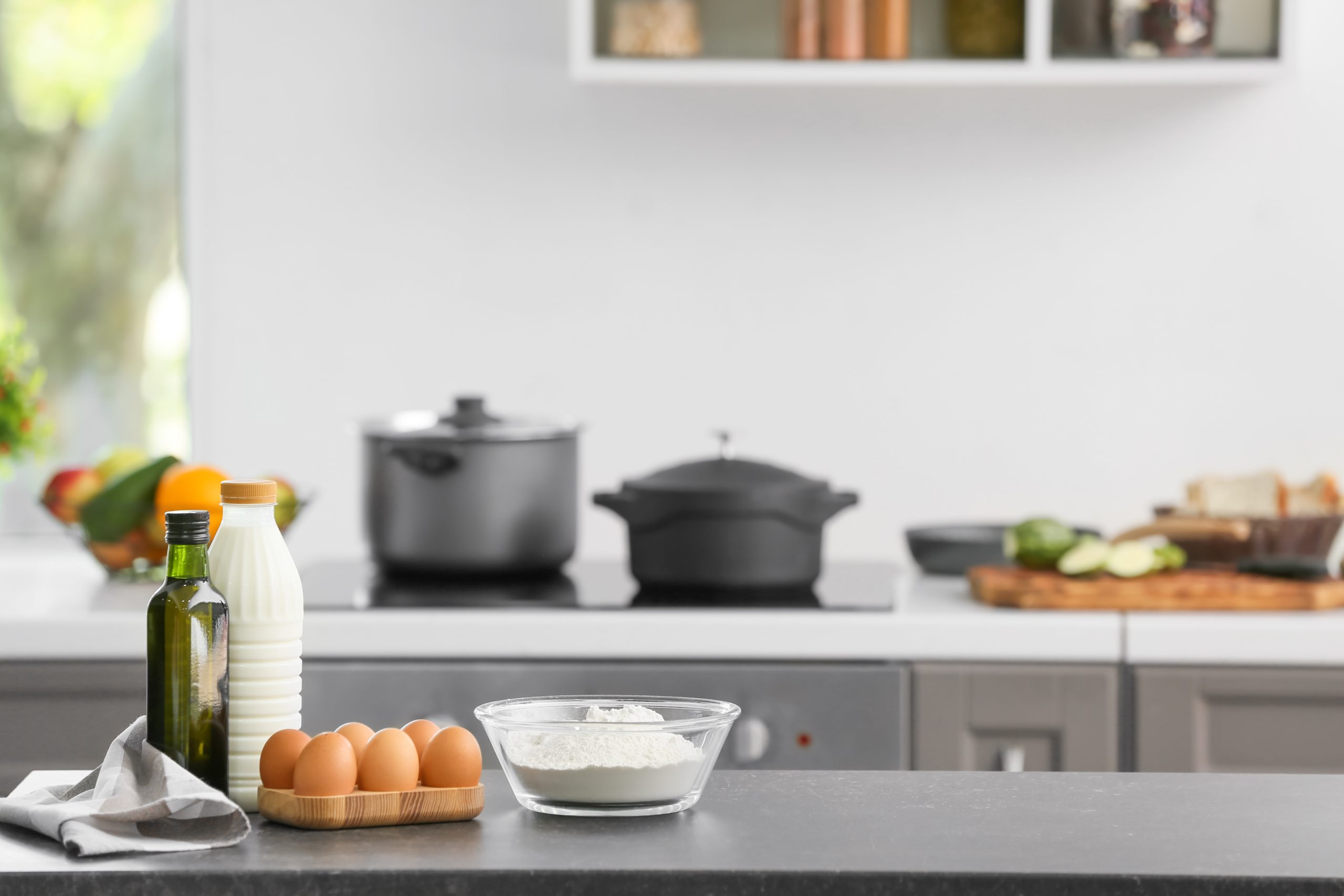
Thinking of your kitchen as a series of functional zones can be a game changer for efficiency. Instead of scattered chaos, think of designating different parts of your kitchen to specific tasks: a baking zone, a coffee station, a prep zone, etc. Having these clearly defined zones can streamline how you navigate and use your kitchen for each specific need. Keep all your baking supplies in one area – measuring cups, flour, sugar – so they’re ready for any baking adventure you decide to embark on. Designating a specific spot for a particular need can help to prevent things from being misplaced, makes meal prep easier, and keeps everything organized since it always returns to the same spot. You’ll notice a huge difference when each zone is established and maintained.
Regularly Declutter
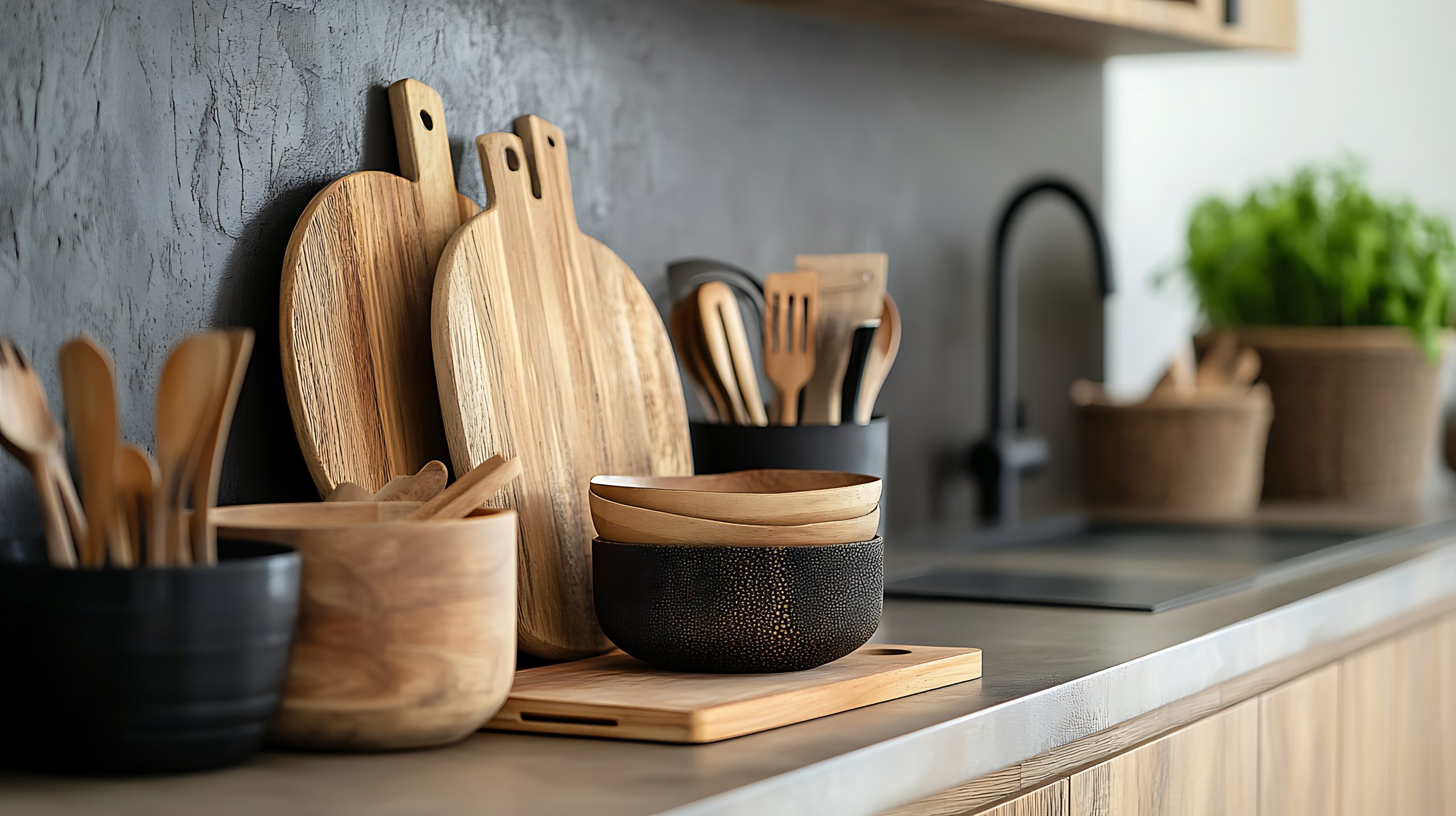
Finally, even the most organized kitchens need regular decluttering. It’s easy to accumulate items that you simply don’t use or need and to slowly forget about old items that start to take up valuable space. Take a few minutes regularly to purge out items that no longer have a purpose in your kitchen, whether that is a random utensil you never use, a mismatched container you forgot you owned, or old food that expired.
By doing this routinely, you prevent the build-up of clutter that can inevitably lead to a kitchen that’s no longer organized. Incorporate decluttering into a simple routine by using the FIFO system, or spend 10 minutes each week to quickly see if there’s anything you can let go from the pantry, fridge, or your cabinets. A consistently decluttered space is key to a consistently organized kitchen and home.
By implementing these 15 kitchen organization ideas, you can transform your space into a more functional and enjoyable environment. Remember, a well-organized kitchen is not just about aesthetics, but about making daily life easier and more efficient.

by Kesaa Interiors | Bedrooms, DESIGN GUIDES, ROOMS
This post is all about master bedroom inspiration. 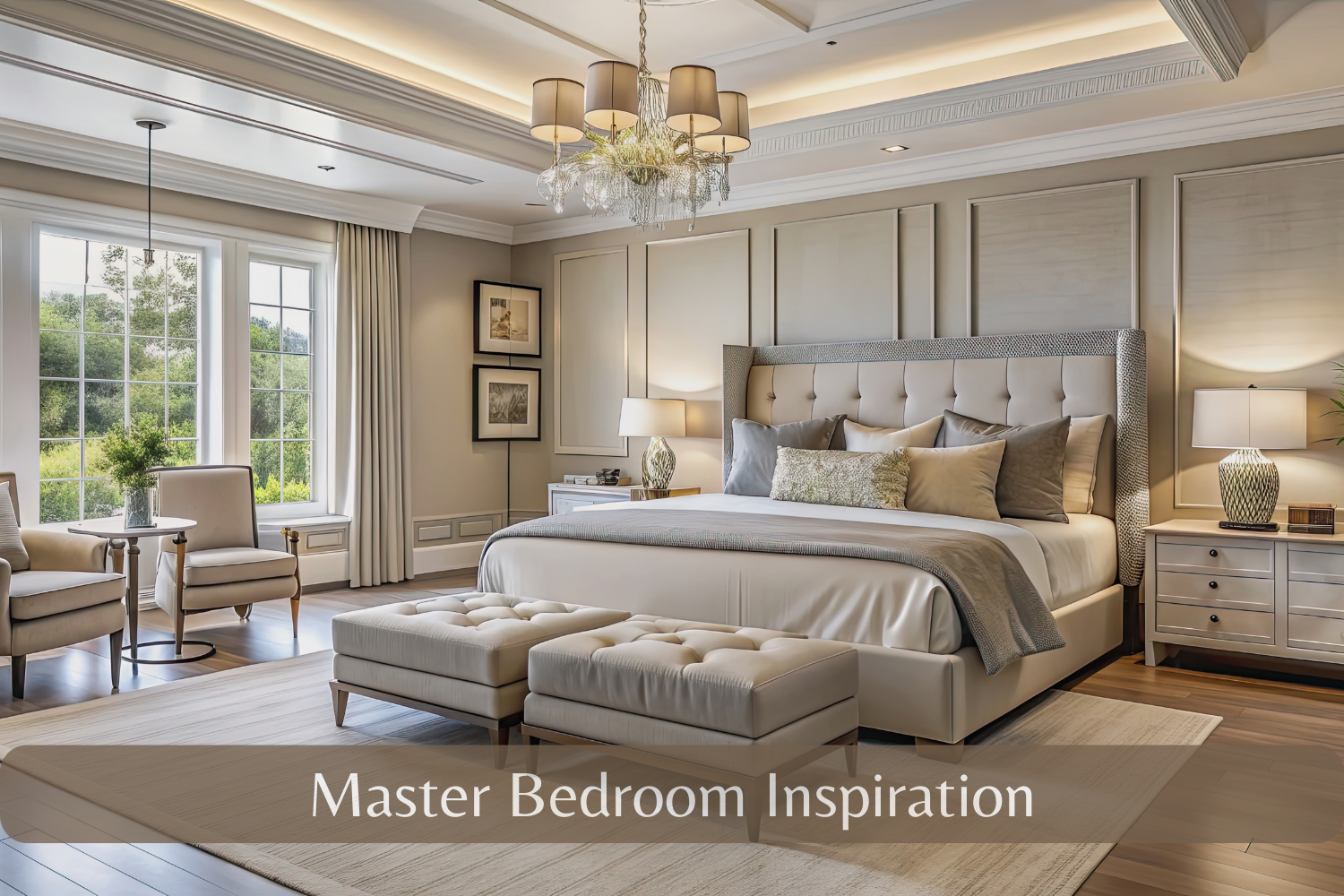
Creating a master bedroom that reflects your style while offering comfort and functionality can be challenging yet rewarding. From colour palettes to furniture choices, every detail plays a crucial role in the room’s overall ambience.
Whether your taste leans towards modern minimalism or classic elegance, these tips and design ideas will spark your creativity and set you on the path to the perfect bedroom sanctuary.
This post is all about master bedroom inspiration.
Best Master Bedroom Inspiration
The Right Colour Choice
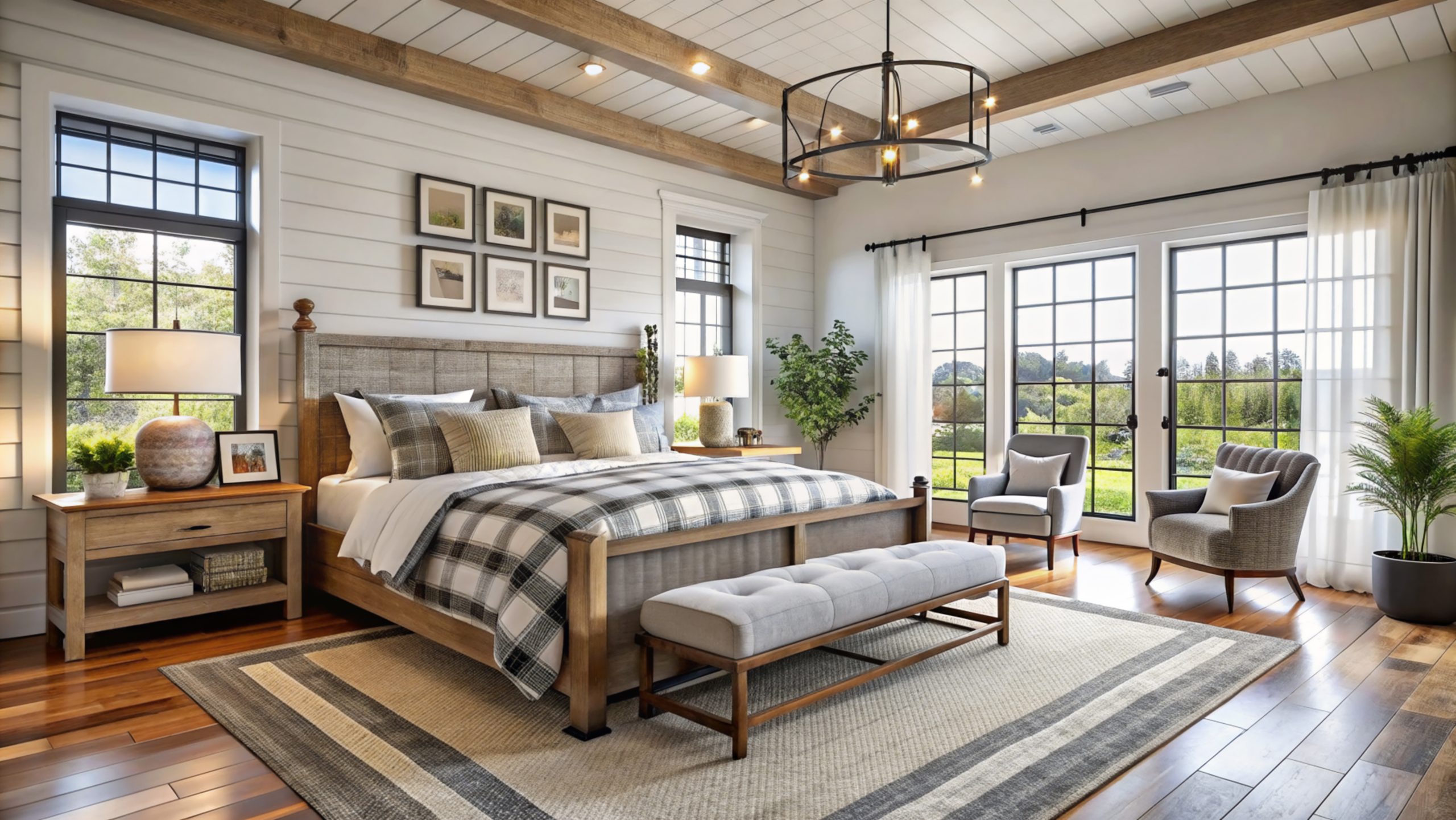
Choosing the colour palette for your master bedroom is a crucial design decision that will set the overall tone of the space. Neutral shades like beige, ivory, grey, and soft pastels create a calming and peaceful atmosphere, making them popular choices for those seeking relaxation after a long day. These subtle tones are effective in reflecting natural light, which in turn makes the room feel more open and airy. However, don’t hesitate to play with colour! You can always add pops of vibrant hues through throw pillows, wall art, or bedding. Having a neutral base allows you the freedom to change accessories as trends evolve or your tastes shift, all while maintaining a cohesive and tranquil ambience in the room.
On the other hand, bolder colour schemes can add drama and richness to your master bedroom. Deep shades like navy blue, forest green, or charcoal grey can make the room feel cozy and intimate, while jewel tones such as emerald or ruby create a luxurious feel. These darker tones can be used on feature walls or through textiles and furniture, balanced by lighter accents to avoid overwhelming the space. For a more eclectic or personalized touch, consider incorporating a combination of complementary hues that suit your personality. Whatever colour scheme you choose, ensure it reflects your desired mood for the room, whether that’s calming, luxurious, or energizing.
Luxurious Textiles

In order to establish a luxurious atmosphere in your master bedroom, it’s essential to carefully select the textiles. The fabrics used in your bedroom play a vital role in enhancing the overall ambience of the space. Start by giving priority to high-quality bedding made from natural materials like cotton, linen, or bamboo for their breathability and comfort. Incorporating soft, plush rugs on the floor can have a significant impact, particularly when getting out of bed in the morning. Experiment with layering different textures to create a cozy and inviting setting. For example, mixing a smooth cotton duvet with a chunky knit throw or velvet pillows can add depth and visual interest to the room. Don’t forget to also consider the curtains—choose floor-length drapes crafted from heavier fabrics to effectively block out light while enhancing the room’s sophistication.
Incorporating textiles into the overall decor of your master bedroom, beyond basic bedding and curtains, can completely transform the space into a true haven. By adding upholstered headboards, fabric-covered benches, and even throw pillows in different patterns and textures, you can enhance the room’s aesthetic. Velvet, silk, and faux fur are excellent choices for creating a sense of opulence and comfort. These tactile elements not only help to establish a warm and cozy atmosphere but also contribute to balancing out harder surfaces, such as wooden floors or metal furniture, by adding softness and warmth to the design. By carefully selecting luxurious textiles, you can create a bedroom that is as comfortable as it is visually stunning, ensuring that it serves as a restful retreat at the end of each day.
Statement Lighting
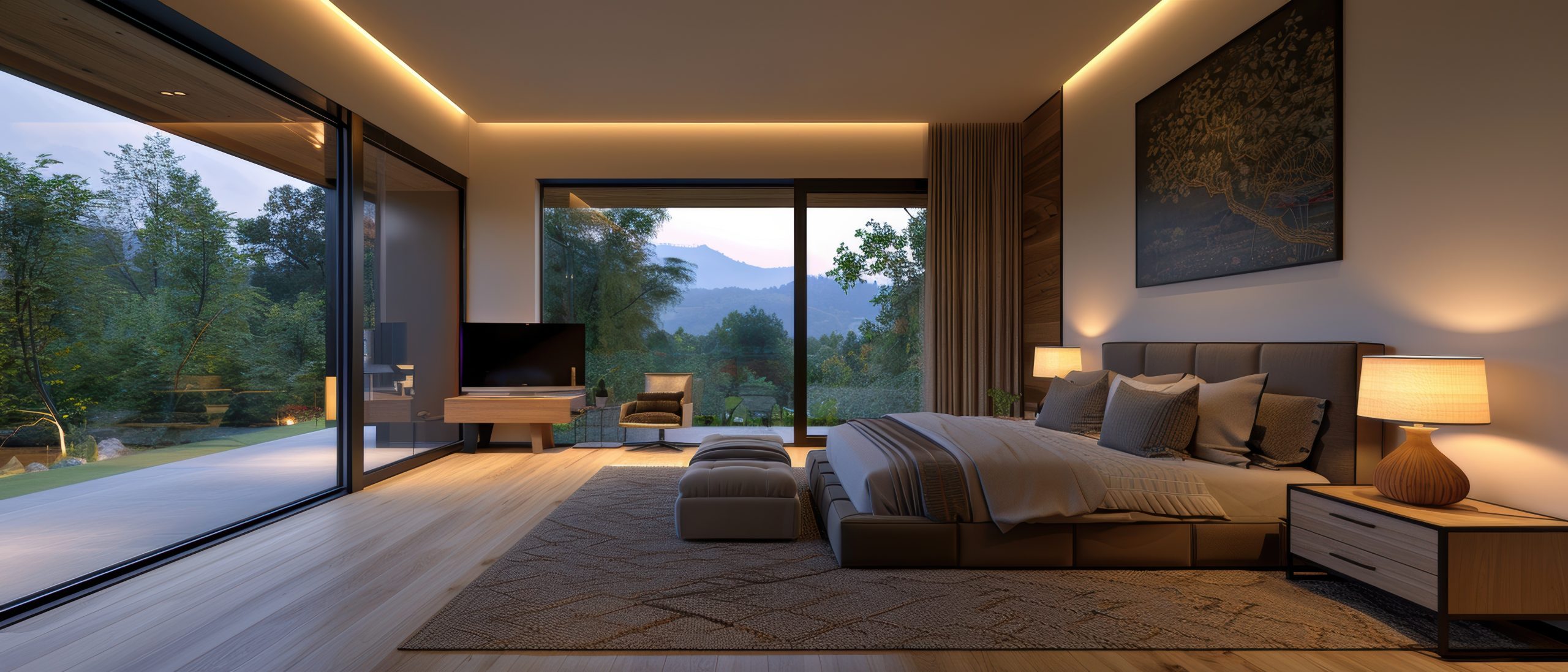 Lighting is key in creating the right mood in your master bedroom. A statement chandelier or pendant light can serve as both a functional light source and a striking visual centrepiece. Whether you prefer a modern geometric fixture or a more classic, ornate chandelier, the right lighting can set the tone for the entire space. Consider selecting a fixture that complements your bedroom’s overall aesthetic. For example, a minimalist space might call for sleek, understated lighting, while a vintage-inspired bedroom could benefit from a chandelier with intricate details and soft, diffused light. The key is to ensure that your choice of overhead lighting not only enhances the design but also provides enough brightness for the room’s general needs.
Lighting is key in creating the right mood in your master bedroom. A statement chandelier or pendant light can serve as both a functional light source and a striking visual centrepiece. Whether you prefer a modern geometric fixture or a more classic, ornate chandelier, the right lighting can set the tone for the entire space. Consider selecting a fixture that complements your bedroom’s overall aesthetic. For example, a minimalist space might call for sleek, understated lighting, while a vintage-inspired bedroom could benefit from a chandelier with intricate details and soft, diffused light. The key is to ensure that your choice of overhead lighting not only enhances the design but also provides enough brightness for the room’s general needs.
For your bedroom lighting to have depth and complexity, you can use a mix of light sources. Use bedside lamps for focused light when reading or unwinding, and they can also bring balance and symmetry to your bedside tables. Wall sconces offer another choice for localized lighting, giving off a gentle, ambient glow that can help create a more intimate and cozy atmosphere. Floor lamps can also be both functional and decorative, brightening up darker corners and adding vertical interest to the room. Remember to put in dimmer switches, which enable you to adjust the brightness and easily switch from bright task lighting to a softer, more relaxing ambience at night.
Maximising Natural Light
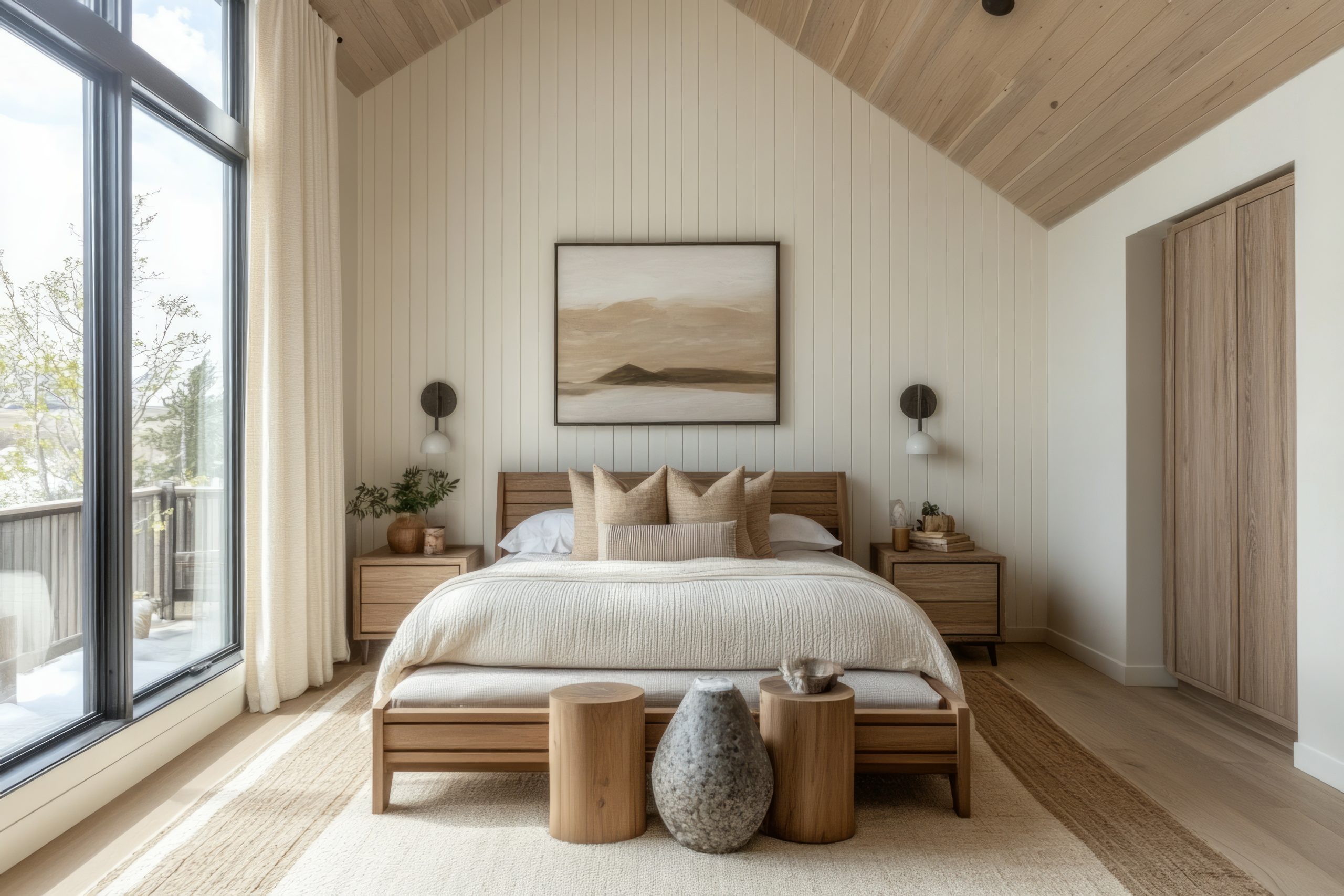
Maximizing the natural light in your master bedroom can completely change the feel of the space, creating a more open, airy, and welcoming atmosphere. To achieve this, consider incorporating large windows or glass doors to allow as much sunlight as possible into the room. If your bedroom has small or limited windows, you can still enhance the existing light by choosing lighter, more reflective paint colours for the walls and ceiling. Additionally, consider using sheer curtains or light-filtering blinds to let sunlight in while maintaining privacy, as these lightweight window treatments are perfect for creating a bright and comfortable environment.
Mirrors can be used to enhance natural light by strategically positioning them across from windows to reflect daylight and make the space appear larger and brighter. Furniture with glossy finishes or metallic accents can also help to scatter light throughout the room. If traditional windows are limited by privacy or architectural constraints, skylights are an excellent alternative for allowing light to enter from above, brightening the room and adding a visually appealing design element that draws the eye upward.
Functional Storage
 A clutter-free master bedroom is essential for maintaining a peaceful and relaxing environment. Without proper storage solutions, it’s easy for clothes, shoes, and other personal items to accumulate and detract from the room’s tranquillity. Built-in wardrobes are a great solution for maximizing storage without taking up too much floor space. These can be customized to fit your exact needs, offering designated areas for clothing, accessories, and even shoes. If space is limited, under-bed storage is a practical alternative. Using stylish storage bins or drawers that slide easily under the bed can help you make the most of every inch of the room without sacrificing aesthetics. Floating shelves or wall-mounted storage units are another space-saving option, providing a place to display books, decor items, or extra linens while keeping the floor free of clutter.
A clutter-free master bedroom is essential for maintaining a peaceful and relaxing environment. Without proper storage solutions, it’s easy for clothes, shoes, and other personal items to accumulate and detract from the room’s tranquillity. Built-in wardrobes are a great solution for maximizing storage without taking up too much floor space. These can be customized to fit your exact needs, offering designated areas for clothing, accessories, and even shoes. If space is limited, under-bed storage is a practical alternative. Using stylish storage bins or drawers that slide easily under the bed can help you make the most of every inch of the room without sacrificing aesthetics. Floating shelves or wall-mounted storage units are another space-saving option, providing a place to display books, decor items, or extra linens while keeping the floor free of clutter.
If you’re fortunate enough to have more space, a walk-in closet can be a luxurious and functional addition to your master bedroom. It not only provides ample storage for clothing and accessories but also offers a designated space for getting ready, keeping your main bedroom free of distractions. Opt for adjustable shelving, hanging racks, and dedicated shoe storage to keep everything organized and easily accessible. For smaller bedrooms, multifunctional furniture like ottomans with hidden storage or bedside tables with drawers can also help maximize space while adding style to the room. By investing in functional storage solutions, you’ll create a more organized, serene environment where you can fully relax.
Cosy Seating Area
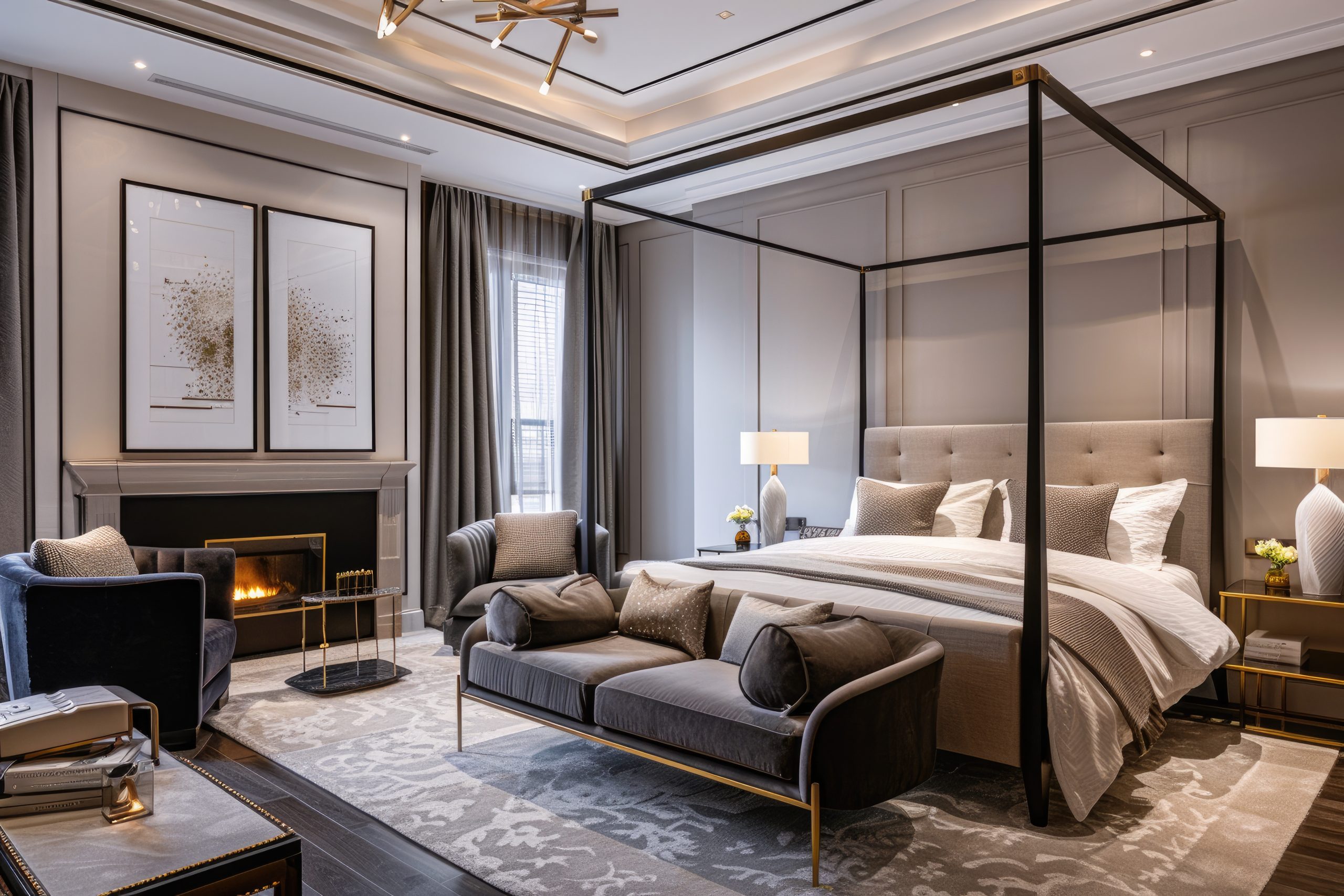
If you have the space, incorporating a seating area into your master bedroom can elevate the room from just a place to sleep. A cozy seating nook gives you a specific area to unwind and relax without having to leave the comfort of your bedroom. Placing a comfortable armchair, a small loveseat, or a chaise lounge near a window can provide a tranquil space for reading, meditating, or enjoying your morning coffee. To enhance the seating area, think about adding a soft throw blanket and a plush pillow for added comfort. By creating this peaceful corner, you can utilize your bedroom as a versatile space for both rest and relaxation.
Consider integrating furniture and decor that complements the overall aesthetic of your bedroom. A decorative lamp on a stylish side table or a minimalist floor lamp can offer the perfect ambient lighting for your seating area. Placing a small bookshelf or magazine rack nearby will keep your favourite reading materials easily accessible. If you have the space, a seating area can create a luxurious retreat-like environment within your master bedroom, functioning as a mini-living room. This thoughtful design not only enhances the room’s functionality but also adds a cozy and inviting touch, making your bedroom feel like a true sanctuary.
Personal Touches
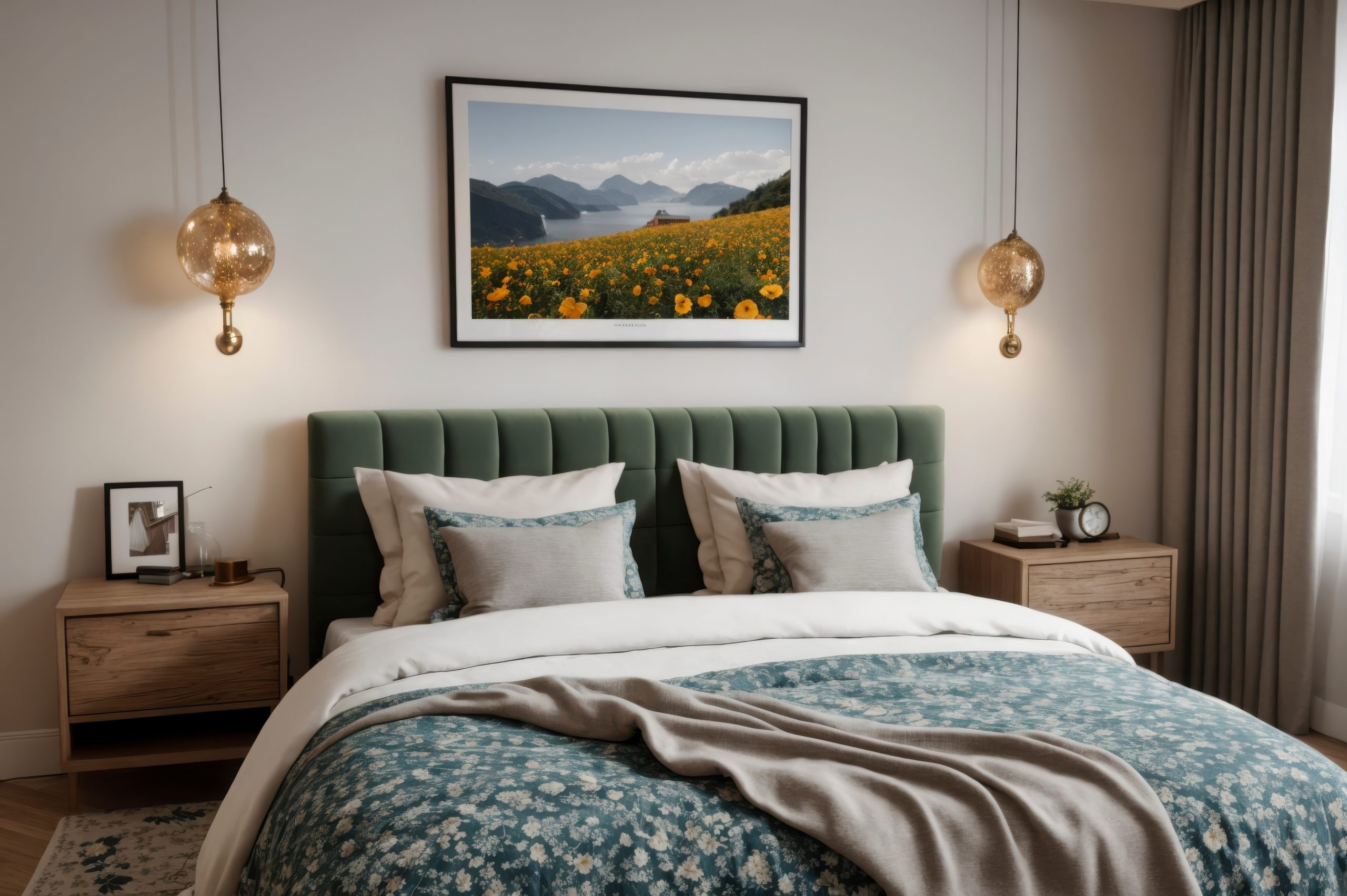 Your master bedroom should be a reflection of your personality, a space that feels uniquely yours. Incorporating personal touches such as family photos, cherished mementos, or travel souvenirs can give the room a sentimental and intimate atmosphere. These elements add warmth and individuality to the space, turning it into a true personal sanctuary. Consider creating a gallery wall with a mix of family portraits, art prints, or framed memorabilia to showcase your story. Personalized items, such as monogrammed pillows or blankets, can also be subtle ways to infuse your space with character.
Your master bedroom should be a reflection of your personality, a space that feels uniquely yours. Incorporating personal touches such as family photos, cherished mementos, or travel souvenirs can give the room a sentimental and intimate atmosphere. These elements add warmth and individuality to the space, turning it into a true personal sanctuary. Consider creating a gallery wall with a mix of family portraits, art prints, or framed memorabilia to showcase your story. Personalized items, such as monogrammed pillows or blankets, can also be subtle ways to infuse your space with character.
Artwork is another powerful way to elevate the design of your master bedroom. Select pieces that complement your chosen colour palette and the mood you want to create in the room. For example, calming, abstract artwork or landscapes can evoke a peaceful and serene vibe, while bold, statement pieces can add energy and drama. If you’re feeling adventurous, consider commissioning a custom piece that aligns with your vision for the space. Whether it’s a large canvas above the bed or smaller pieces scattered throughout the room, art helps tie the design together and adds a creative dimension to your bedroom.
Statement Pieces
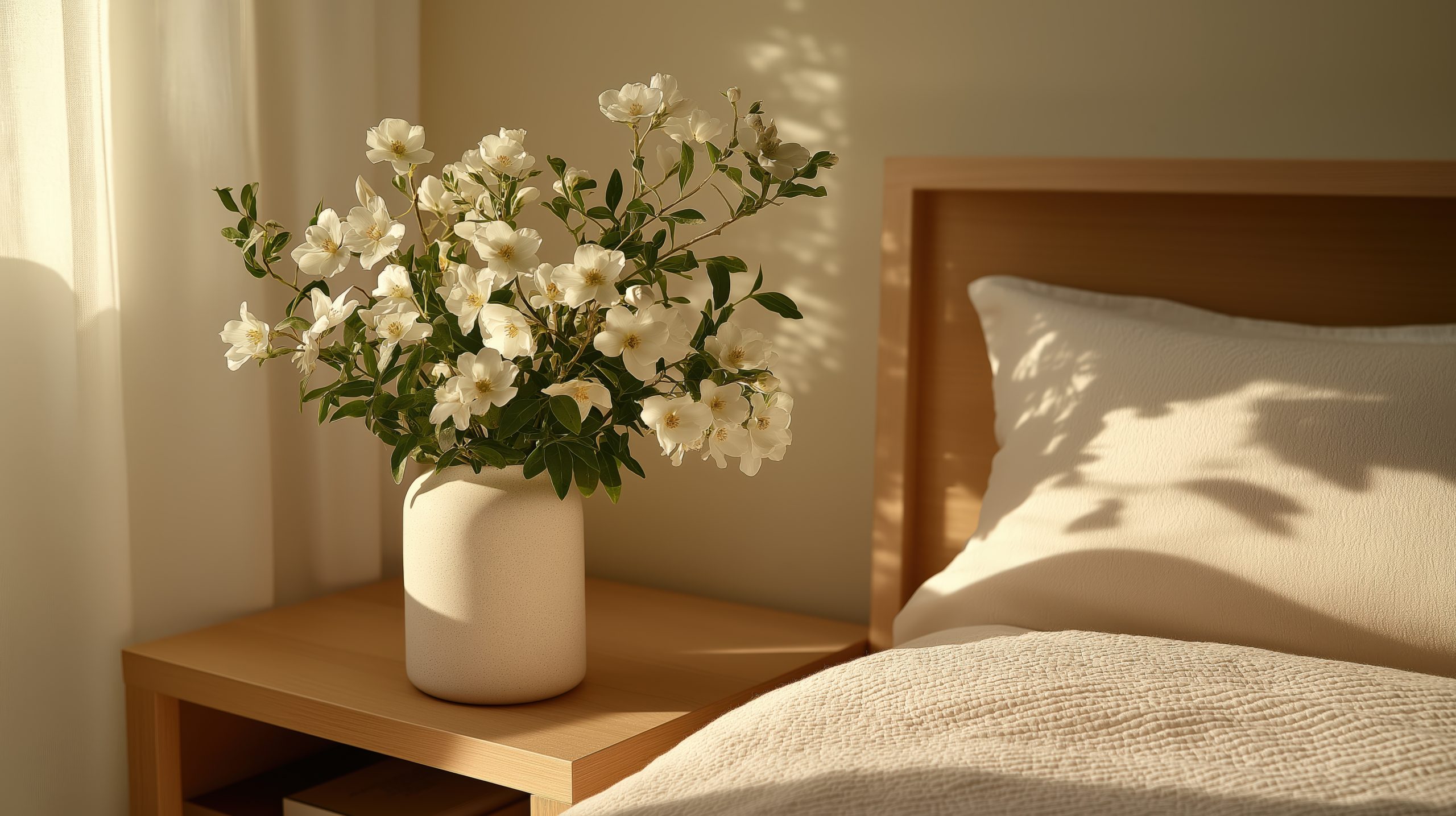 While the bed is often the main focal point of a master bedroom, incorporating other statement furniture pieces can enhance the room’s character and function. Adding a well-crafted dresser, a graceful chaise lounge, or a distinctive nightstand can enhance the visual appeal and elevate the room’s ambience. For instance, a vintage dresser can introduce a sense of enduring charm, while a sleek, modern headboard can establish a contemporary atmosphere. When choosing standout furniture, it’s important to maintain balance. Make sure that the selected pieces complement each other and the room’s overall style. Mixing materials such as wood, metal, and fabric can also produce a complex and refined appearance. In addition to aesthetics, functionality should be a primary consideration when choosing statement furniture. A bench at the foot of the bed not only adds a stylish touch but also provides practical storage or seating. Similarly, a bold nightstand can be both a design element and a functional piece for storing essentials. The right furniture choices can transform your master bedroom into a space that is not only visually appealing but also perfectly suited to your lifestyle. Remember, each piece should contribute to the overall comfort and utility of the room, ensuring that it remains a peaceful retreat.
While the bed is often the main focal point of a master bedroom, incorporating other statement furniture pieces can enhance the room’s character and function. Adding a well-crafted dresser, a graceful chaise lounge, or a distinctive nightstand can enhance the visual appeal and elevate the room’s ambience. For instance, a vintage dresser can introduce a sense of enduring charm, while a sleek, modern headboard can establish a contemporary atmosphere. When choosing standout furniture, it’s important to maintain balance. Make sure that the selected pieces complement each other and the room’s overall style. Mixing materials such as wood, metal, and fabric can also produce a complex and refined appearance. In addition to aesthetics, functionality should be a primary consideration when choosing statement furniture. A bench at the foot of the bed not only adds a stylish touch but also provides practical storage or seating. Similarly, a bold nightstand can be both a design element and a functional piece for storing essentials. The right furniture choices can transform your master bedroom into a space that is not only visually appealing but also perfectly suited to your lifestyle. Remember, each piece should contribute to the overall comfort and utility of the room, ensuring that it remains a peaceful retreat.
Patterns & Prints
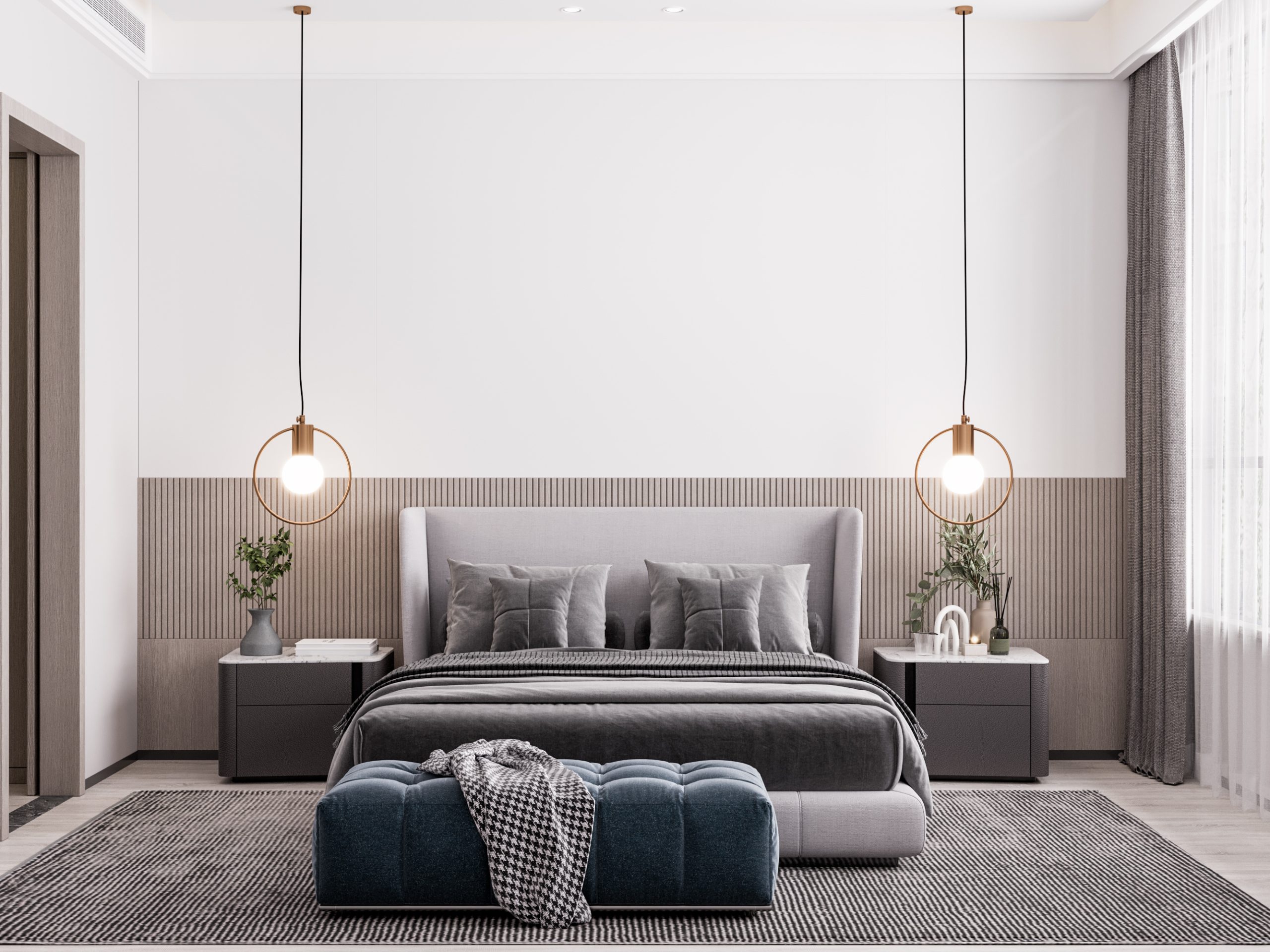
Integrating patterns and prints into your main bedroom is an excellent way to add personality and visual interest to the room. From vibrant geometric shapes to delicate floral designs, patterns can turn a plain space into something more lively and captivating. Begin by thinking about where you’d like to incorporate these features. Intricately designed wallpaper can create a bold statement on an accent wall, serving as a focal point that captures attention. If wallpaper seems too permanent or overpowering, consider using patterned curtains, bed linens, or area rugs to introduce texture without committing to a large-scale pattern on your walls. The key is achieving a balance—combine bold prints with more subdued tones and simple textures to avoid the room feeling too chaotic or overwhelming.
For those who prefer a more subtle approach, layering smaller patterns can create a cohesive and sophisticated look. Mixing different patterns—such as stripes with florals or abstract prints with geometrics—can add depth, but the trick is to ensure the patterns share a similar colour palette. Sticking to complementary hues will tie the elements together without clashing. You can also play with scale: larger patterns on bedding or curtains combined with smaller, more intricate designs on cushions or throws can create visual harmony while keeping the space interesting. Ultimately, patterns and prints are an opportunity to express your creativity and make your master bedroom a reflection of your unique style.
Emphasise The Bed
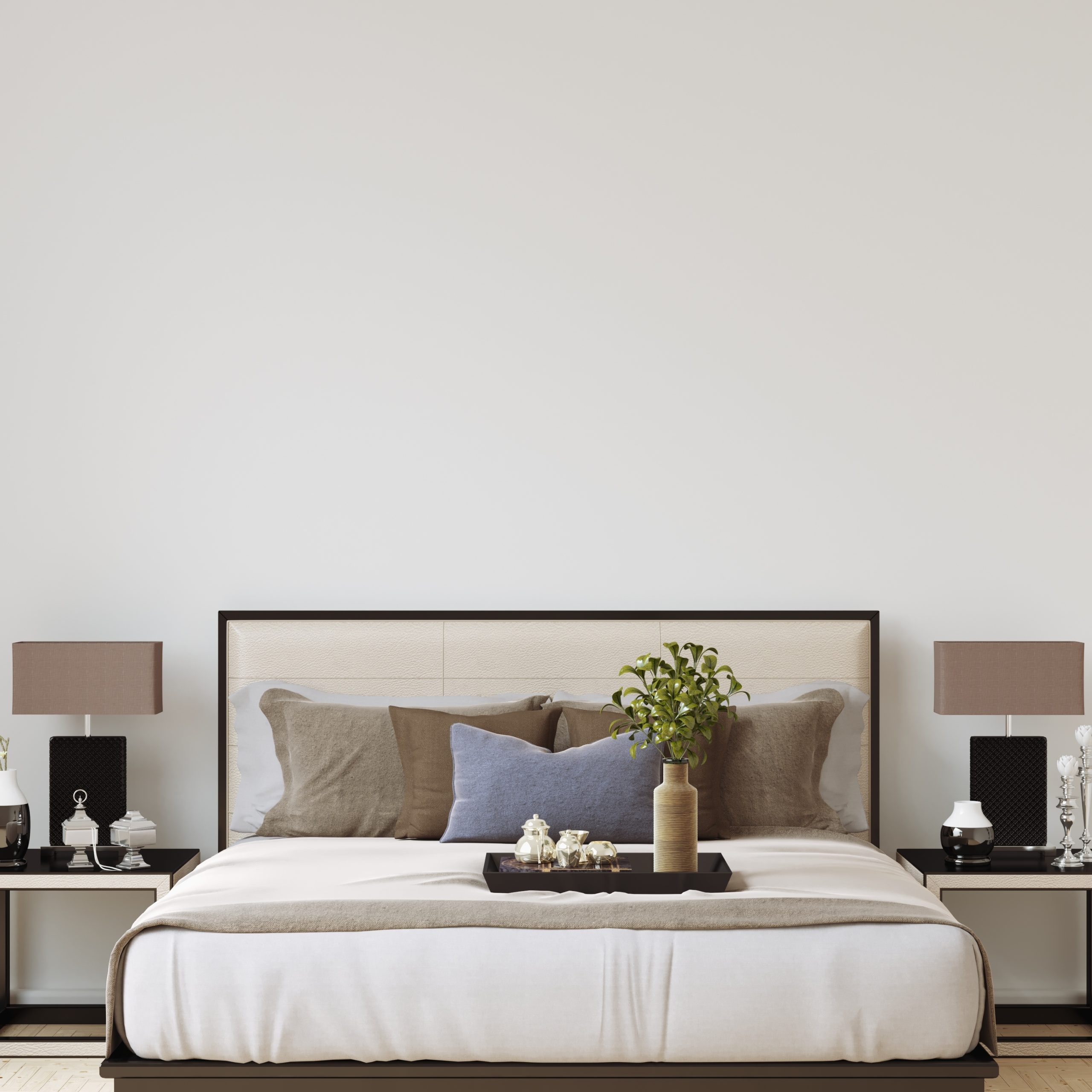
The focal point of any master bedroom is undoubtedly the bed, and it’s important to ensure that it makes a statement reflecting both style and comfort. To begin, consider the bed frame as it establishes the room’s ambience. For a more luxurious feel, consider an upholstered headboard in opulent fabrics such as velvet or linen to introduce elegance and refinement. Alternatively, for those who prefer a more minimalistic approach, a sleek, contemporary wooden frame with clean lines will establish a simple yet stylish look. Remember to consider the bed size – opt for a size that balances comfort with the room’s dimensions. While a king-size bed may be the ultimate indulgence, a queen bed could offer more space for other furniture. Pay attention to how the bed complements the overall room design, ensuring it functions as both a practical and visual focal point.
Beyond the frame, the bedding itself plays a major role in making the bed the centre of attention. Opt for high-quality sheets and duvet covers that feel inviting and luxurious to the touch. The colour and texture of the bedding can either complement the room’s colour palette or stand out as a bold contrast. Consider layering with a mix of textures—think smooth cotton sheets paired with a chunky knit blanket or faux fur throw. Decorative pillows in various sizes, colours, and patterns can also elevate the bed’s aesthetic while offering additional comfort. Remember, your bed should not only look beautiful but also be a haven of comfort where you can relax and unwind. Thoughtful styling and attention to detail will ensure that your bed is the standout feature of your master bedroom.
Incorporating Greenery
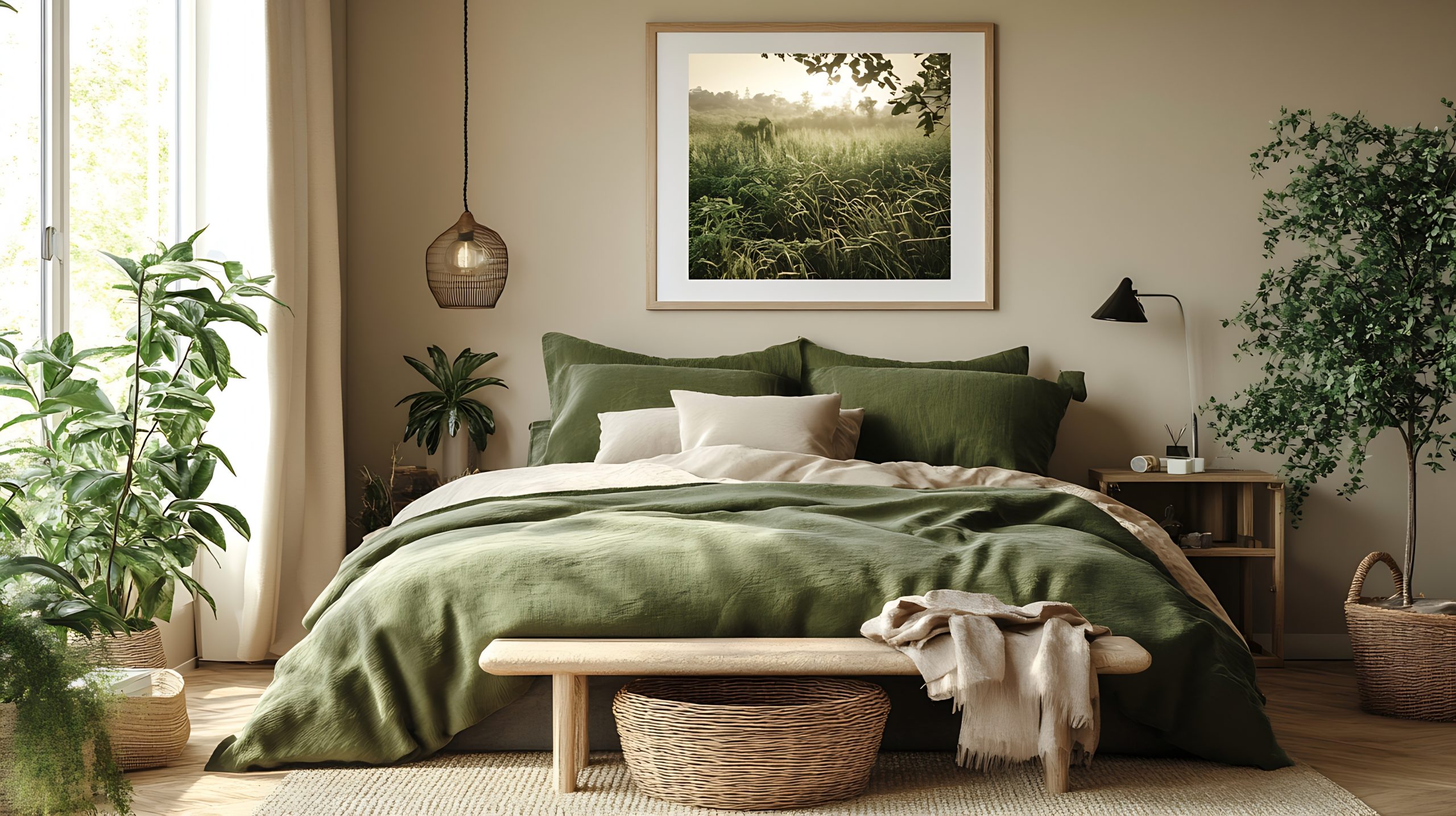 Incorporating plants into your main bedroom is a fantastic way to introduce a natural element and enhance the overall atmosphere. Indoor plants not only function as attractive decor but also provide numerous advantages, such as purifying the air and improving indoor air quality. Specific plants like snake plants, spider plants, and peace lilies are recognized for their air-purifying properties and minimal upkeep needs, making them well-suited for bedrooms. These plants can contribute to establishing a tranquil and relaxing setting, perfect for a space prioritizing relaxation. Even a small plant on a nightstand or a hanging plant in a corner can immediately infuse vitality into the room, imparting a fresh and peaceful ambience. If you’re concerned about plant care, don’t worry! There are plenty of low-maintenance options, and you can even opt for high-quality artificial plants to achieve the same aesthetic effect without the upkeep. Potted plants can be displayed in various ways—on shelves, in stylish planters, or as part of a vertical garden feature for added texture and interest. Pairing plants with natural materials like wood or woven baskets can also enhance the overall organic vibe of the room. Greenery in your bedroom creates a direct connection to nature, which can promote relaxation and improve your overall well-being.
Incorporating plants into your main bedroom is a fantastic way to introduce a natural element and enhance the overall atmosphere. Indoor plants not only function as attractive decor but also provide numerous advantages, such as purifying the air and improving indoor air quality. Specific plants like snake plants, spider plants, and peace lilies are recognized for their air-purifying properties and minimal upkeep needs, making them well-suited for bedrooms. These plants can contribute to establishing a tranquil and relaxing setting, perfect for a space prioritizing relaxation. Even a small plant on a nightstand or a hanging plant in a corner can immediately infuse vitality into the room, imparting a fresh and peaceful ambience. If you’re concerned about plant care, don’t worry! There are plenty of low-maintenance options, and you can even opt for high-quality artificial plants to achieve the same aesthetic effect without the upkeep. Potted plants can be displayed in various ways—on shelves, in stylish planters, or as part of a vertical garden feature for added texture and interest. Pairing plants with natural materials like wood or woven baskets can also enhance the overall organic vibe of the room. Greenery in your bedroom creates a direct connection to nature, which can promote relaxation and improve your overall well-being.
Choose The Right Flooring
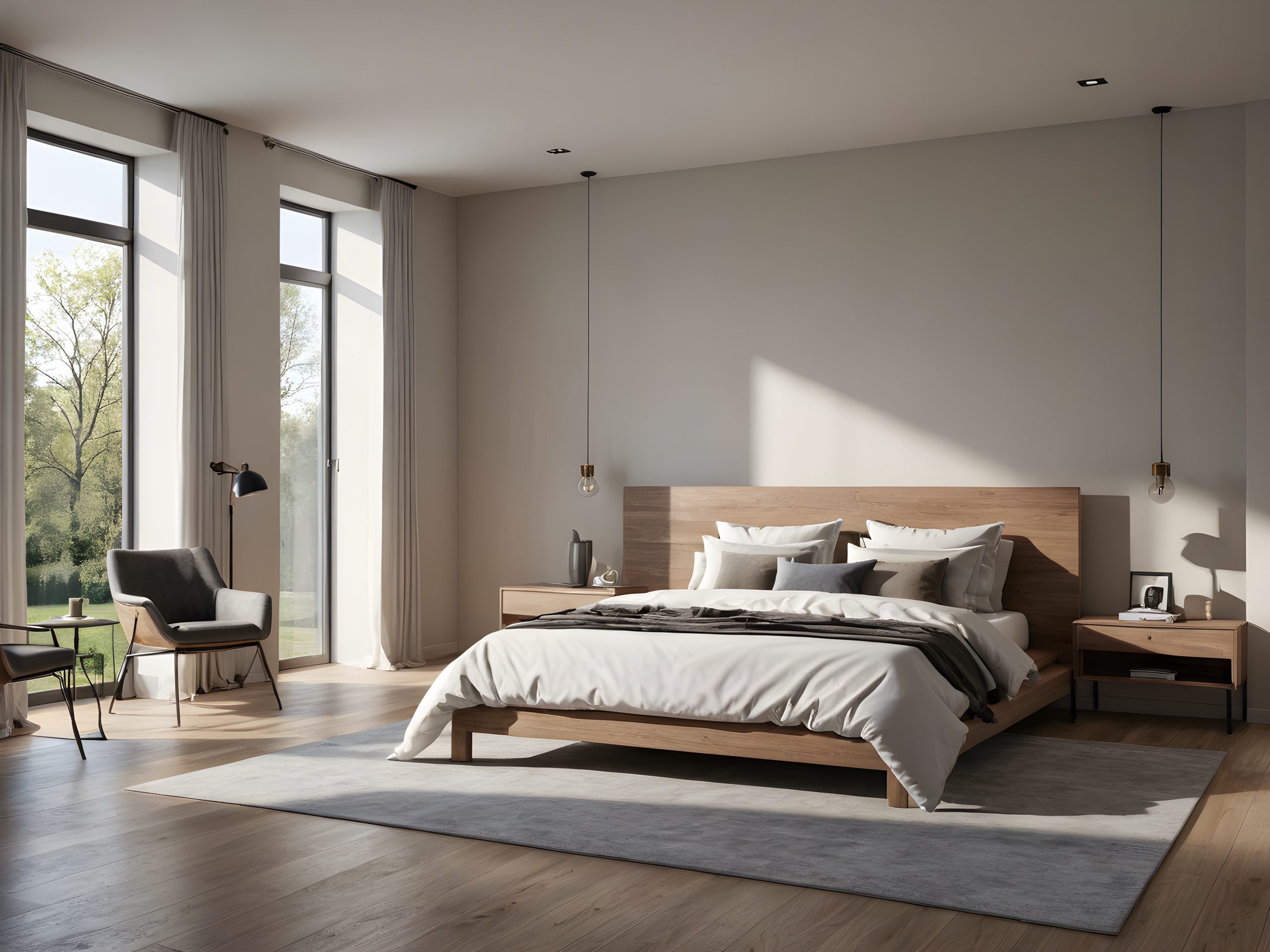 The flooring you choose for your master bedroom can significantly impact both the aesthetics and comfort of the space. Hardwood floors are a popular option due to their timeless appeal, durability, and the warmth they bring to the room. They pair well with various styles, from traditional to modern, and can be enhanced with rugs to add softness underfoot. If you’re looking for an extra touch of luxury, consider adding an area rug or runner in key spaces such as next to the bed or under seating areas. These not only provide visual contrast but also make the room feel cozier and more inviting. For those who prioritize comfort, wall-to-wall carpeting is an excellent option. Carpeting offers a soft, warm surface that feels good underfoot, especially during colder months. It’s available in a variety of colours, patterns, and textures, allowing you to customize the look and feel of the room. Choose neutral tones for a classic and versatile foundation, or opt for more adventurous patterns or textures to add personality. If you prefer easy maintenance, look for high-quality, stain-resistant carpeting that combines comfort with practicality, ensuring that your master bedroom remains both stylish and functional for years to come.
The flooring you choose for your master bedroom can significantly impact both the aesthetics and comfort of the space. Hardwood floors are a popular option due to their timeless appeal, durability, and the warmth they bring to the room. They pair well with various styles, from traditional to modern, and can be enhanced with rugs to add softness underfoot. If you’re looking for an extra touch of luxury, consider adding an area rug or runner in key spaces such as next to the bed or under seating areas. These not only provide visual contrast but also make the room feel cozier and more inviting. For those who prioritize comfort, wall-to-wall carpeting is an excellent option. Carpeting offers a soft, warm surface that feels good underfoot, especially during colder months. It’s available in a variety of colours, patterns, and textures, allowing you to customize the look and feel of the room. Choose neutral tones for a classic and versatile foundation, or opt for more adventurous patterns or textures to add personality. If you prefer easy maintenance, look for high-quality, stain-resistant carpeting that combines comfort with practicality, ensuring that your master bedroom remains both stylish and functional for years to come.
With these creative ideas for master bedroom inspiration, you can transform your space into a personal sanctuary that blends style, comfort, and functionality.
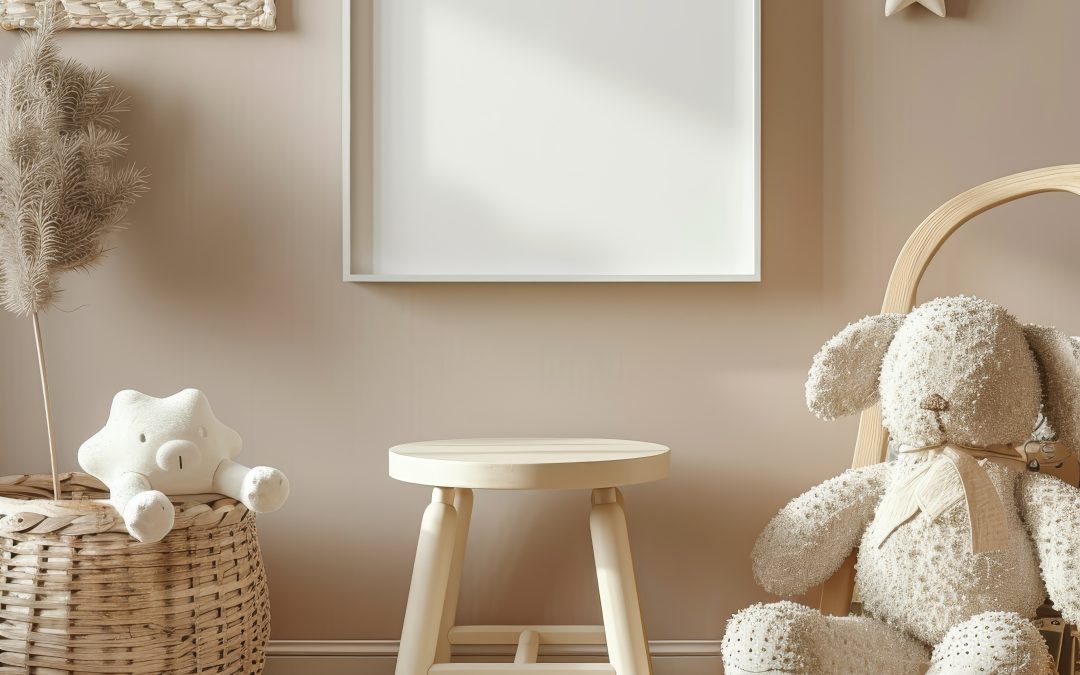
by Kesaa Interiors | Bedrooms, DESIGN GUIDES, ROOMS
This post is all about baby boy nursery theme ideas.
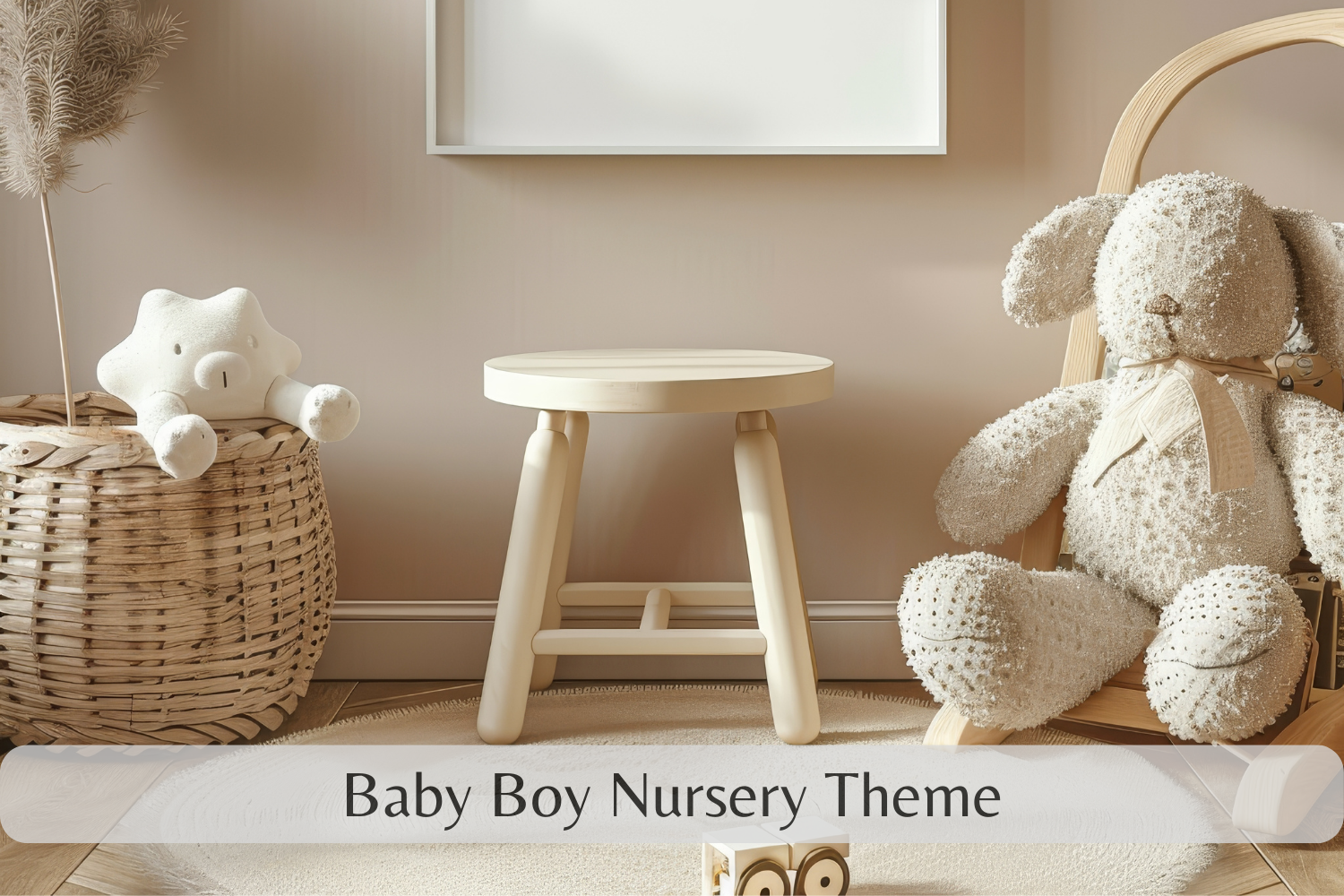
Designing a baby nursery is an exciting project for new parents, and choosing the perfect theme can help you create a space that’s not only functional but also full of character and charm.
Whether you’re going for a bold, adventurous look or something calm and soothing, the right theme sets the stage for your baby boy’s first memories.
In this post, we’ll explore the top 10 adorable baby boy nursery theme ideas, offering a variety of styles that can inspire your dream space.
Top Baby Boy Nursery Theme Ideas
1. Safari Adventure
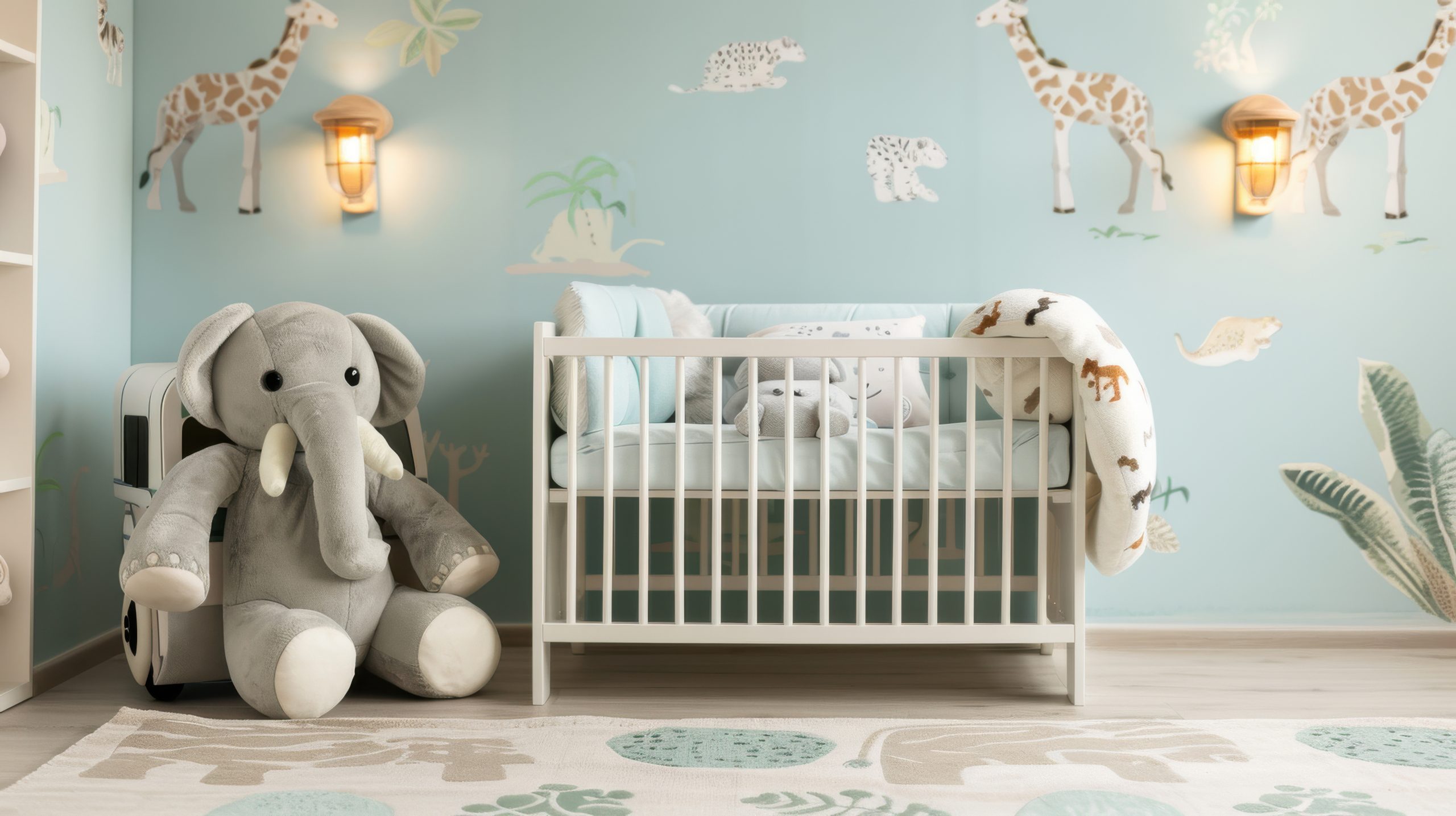
Creating a timeless safari-themed nursery can ignite your child’s imagination with images of wild animals like lions, elephants, zebras, and giraffes. Incorporating natural textures such as wood and rattan can give the room an earthy ambience, while soft animal toys can infuse a sense of playfulness.
Opting for neutral tones like beige, tan, and olive green can contribute to a serene atmosphere. Using wall decals featuring jungle trees and animals can establish a lively backdrop, and animal-shaped cushions and themed mobiles can heighten the adventurous ambience. A safari baby boy nursery theme not only brings nature indoors but also provides your little explorer with a captivating environment to grow in.
2. Under The Sea
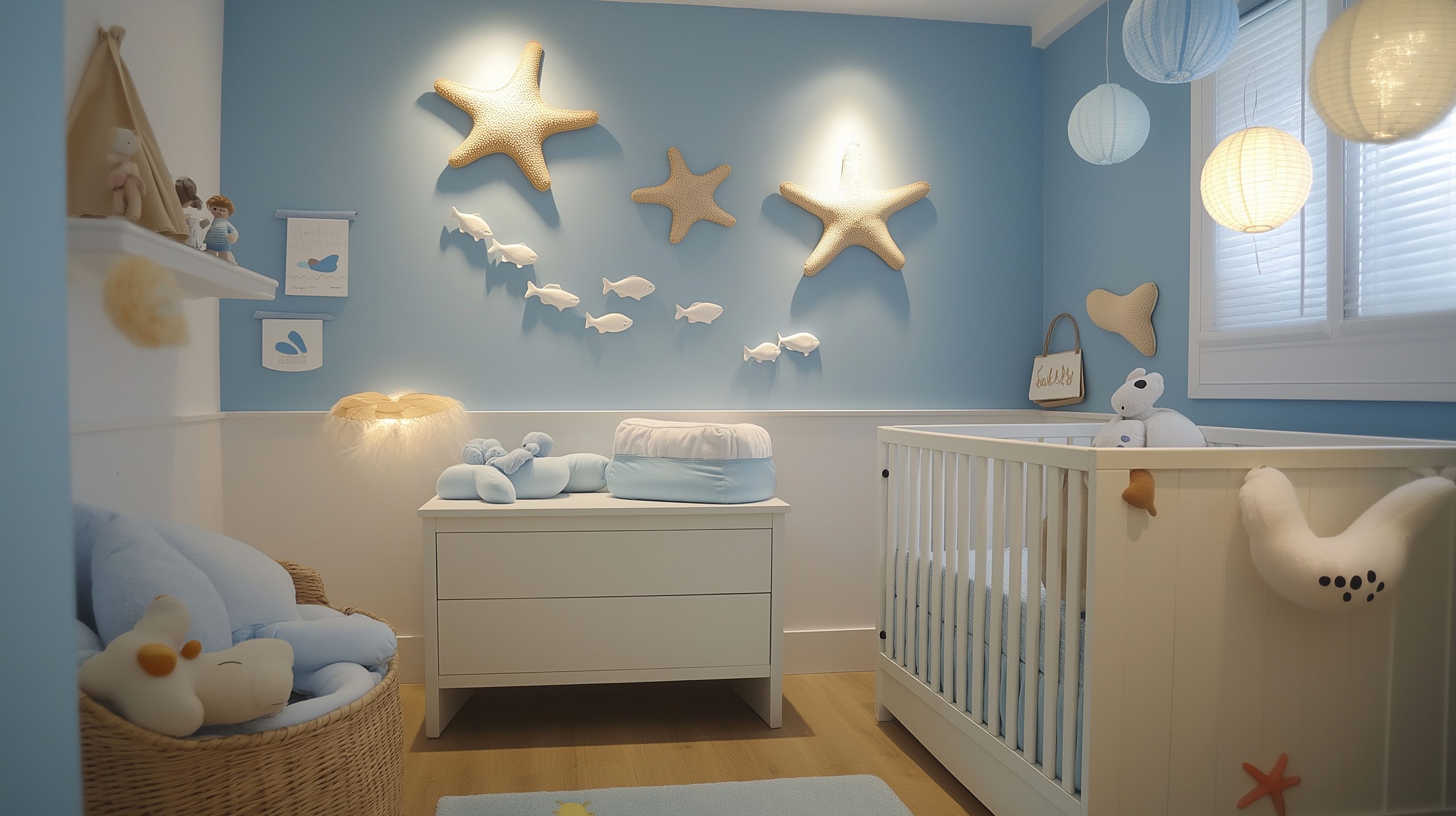
An “Under the Sea” nursery theme creates a serene, dreamy environment with soothing blue hues and playful sea creatures. You can transform the walls into an oceanic paradise by painting a gradient of blues or opt for decals of fish, whales, and starfish.
Complement this theme with ocean-inspired accessories such as a pillow shaped like a whale, mobiles featuring seashells, and a rug with a seaweed design. This nursery not only fosters a peaceful atmosphere for sleep but also introduces a sense of enjoyment and curiosity as your baby develops.
3. Outer Space Explorer

Embark on a galactic journey with a space-themed nursery! The deep blue and grey walls provide an ideal canvas for an interstellar adventure, adorned with decals of planets, astronauts, and shimmering stars to bring the theme to life. A celestial mobile featuring planets and stars above the crib adds a captivating touch.
For the decor, think space rockets, constellation prints, and glow-in-the-dark stickers to inspire wonder and curiosity. The outer space theme is perfect for families who dream of encouraging their little ones to reach for the stars, creating an atmosphere that’s both calming and inspiring.
4. Woodland Forest
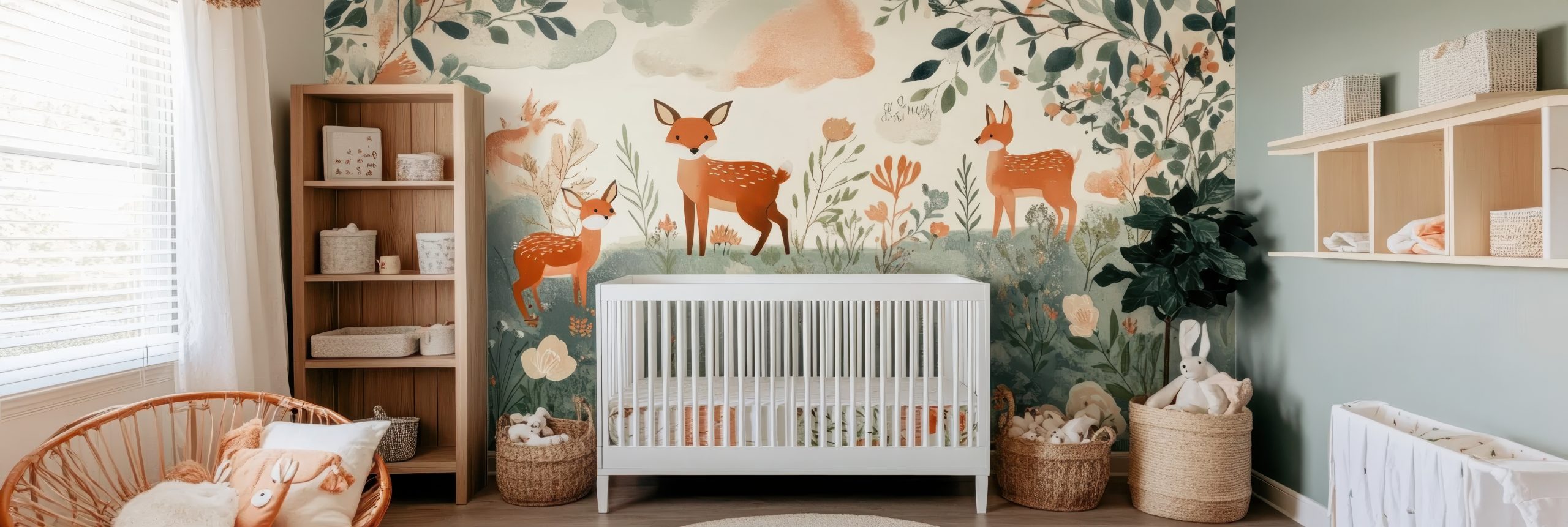
A woodland forest theme will create a cosy and earthy atmosphere in your baby boy’s nursery. This theme often features adorable forest animals like bears, owls, and foxes, as well as natural elements like trees and greenery. Choose soft greens, browns, and neutral tones to evoke the peacefulness of the outdoors.
For a cozy forest feel, think about incorporating woodland-patterned bedding, cute animal stuffed animals, and a tree wall sticker. Wooden furniture goes perfectly with this concept, bringing a sense of warmth and genuineness to the room. This is a great option for families who love nature and want to create a calm and adventurous atmosphere for their little one.
5. Hot Air Ballooning
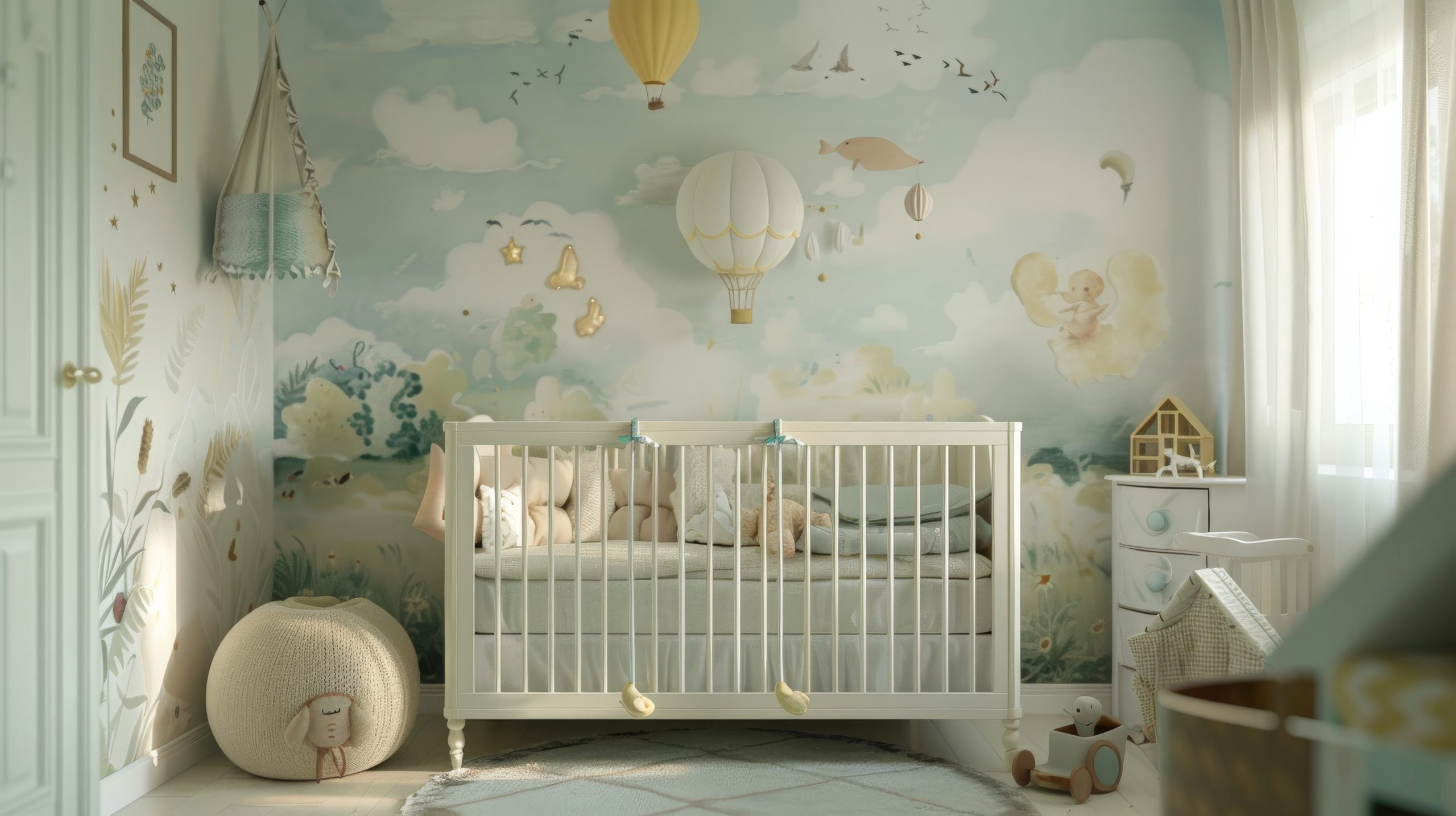
Let your baby’s imagination soar with a whimsical hot-air balloon-themed nursery. This charming theme is full of soft colours, airy designs, and elements of exploration. Think pastel skies, fluffy clouds, and gently floating hot air balloons decorating the walls.
Hang 3D hot air balloons from the ceiling to create a sense of flight, and add cloud-shaped pillows or rugs for a gentle, playful feel. Stick to calming blues, whites, and creams to preserve a serene, dreamy ambience. This theme is perfect for parents who want to nurture a sense of curiosity and wonder during their baby’s early years.
6. World Explorer
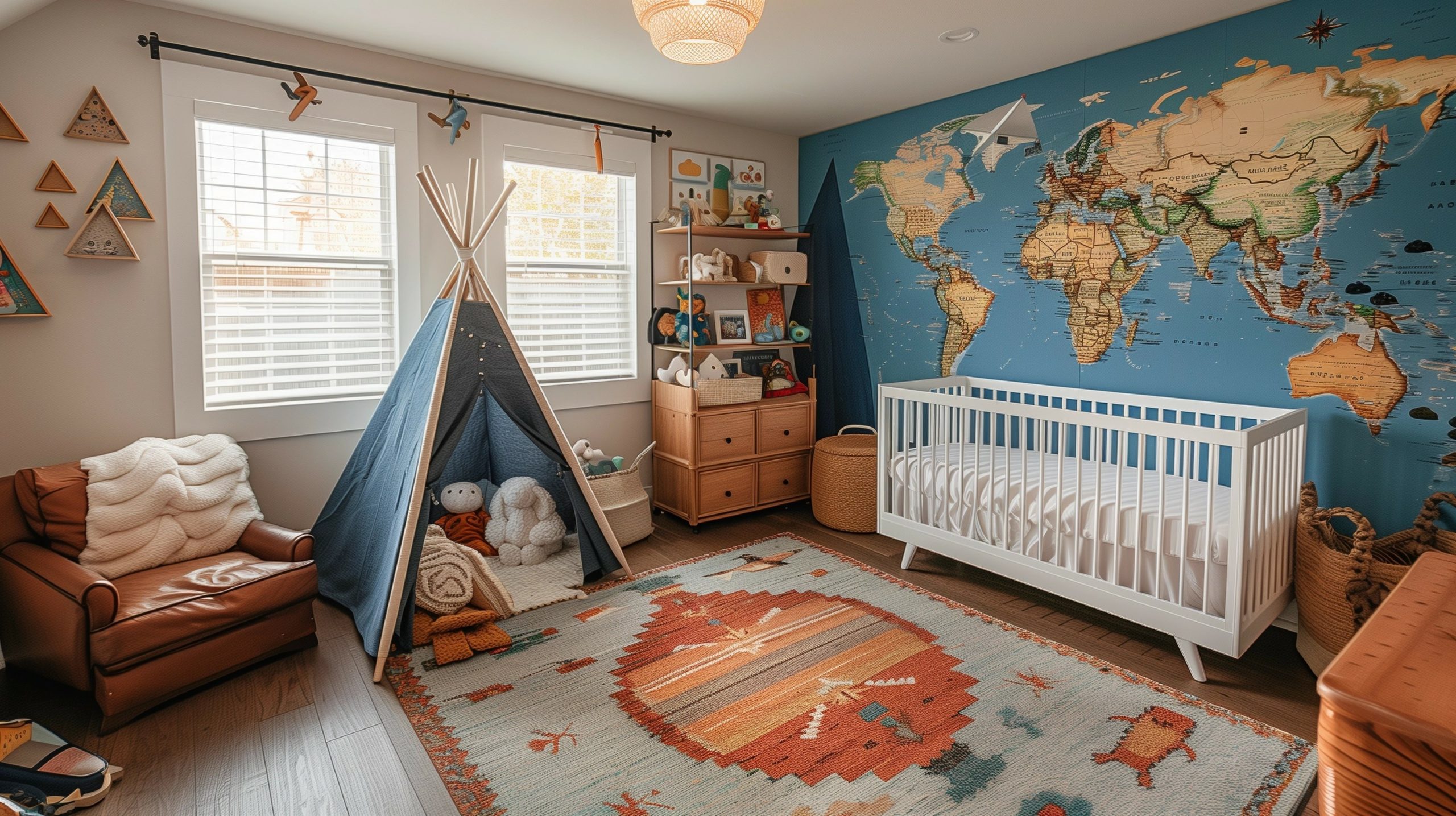
A world explorer baby boy nursery theme is ideal for the little traveller in your life. Transform your baby’s room into a space that ignites curiosity about the world by incorporating a large map mural or wallpaper on one wall. Opt for a vintage map style for a timeless look or a vibrant, playful map for a more contemporary feel.
Compliment the world map with globes, aeroplane mobiles, and travel-themed decorations. Use map-patterned bedding or an animal-world rug to bring the entire look together. This theme promotes a sense of adventure, exploration, and education, making it visually appealing and educational for your baby as they grow.
7. Modern Minimalist
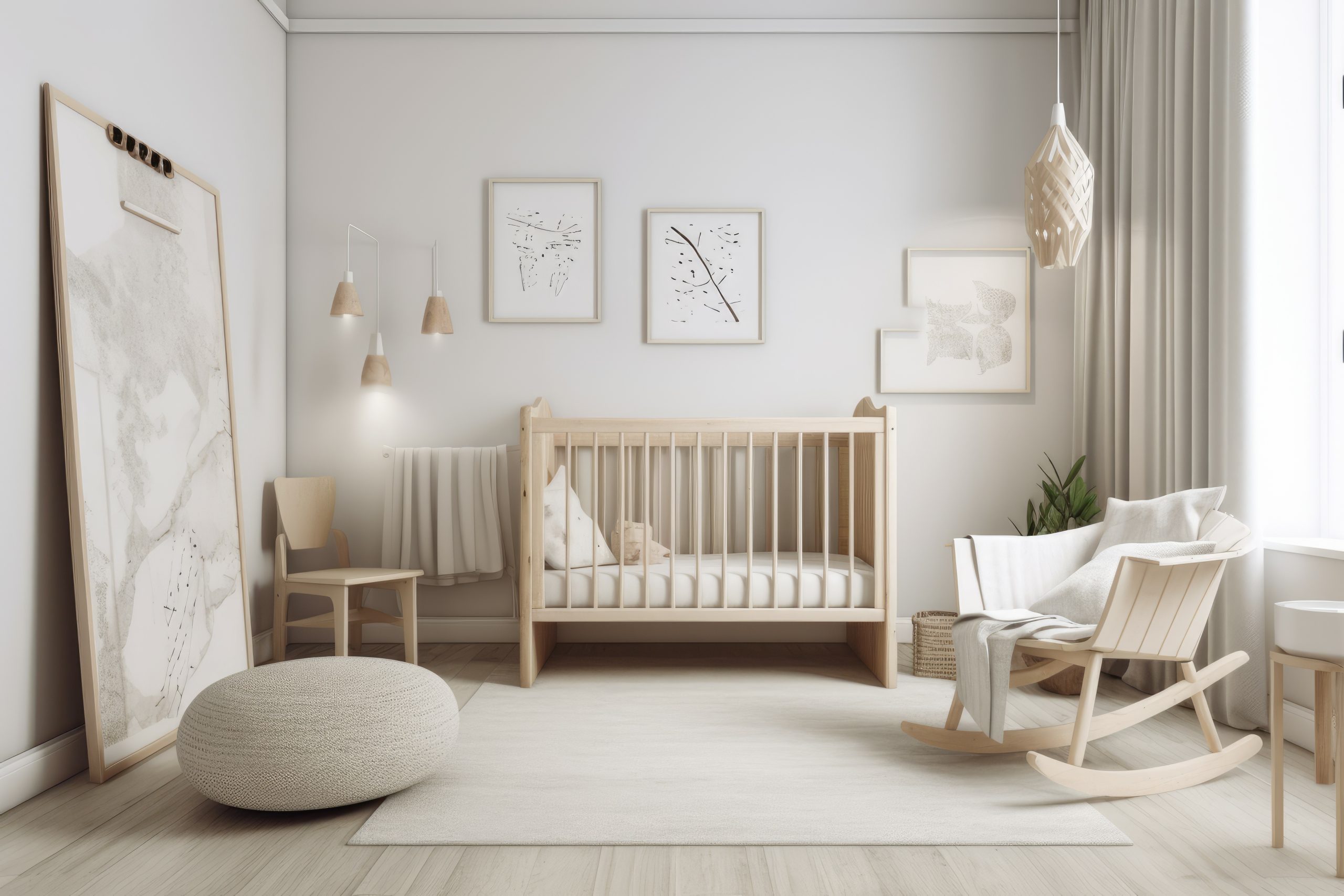
If you’re a parent who appreciates a clean and uncomplicated look, a modern minimalist style might be just what you’re looking for. Simple, straight lines, muted colours, and very little clutter can help establish a soothing and stress-free atmosphere for both you and your little one. Stick to soft whites, light greys, and subtle beiges to maintain a bright and airy feel in the room.
Select a few significant decor items, such as a geometric mobile or abstract wall art, and refrain from overcrowding the space with excessive furniture or toys. Add in natural wood touches, minimalist bedding, and uncomplicated shelving to achieve the desired aesthetic. This theme is all about creating a peaceful, open space that will grow with your child.
8. Nautical Adventure
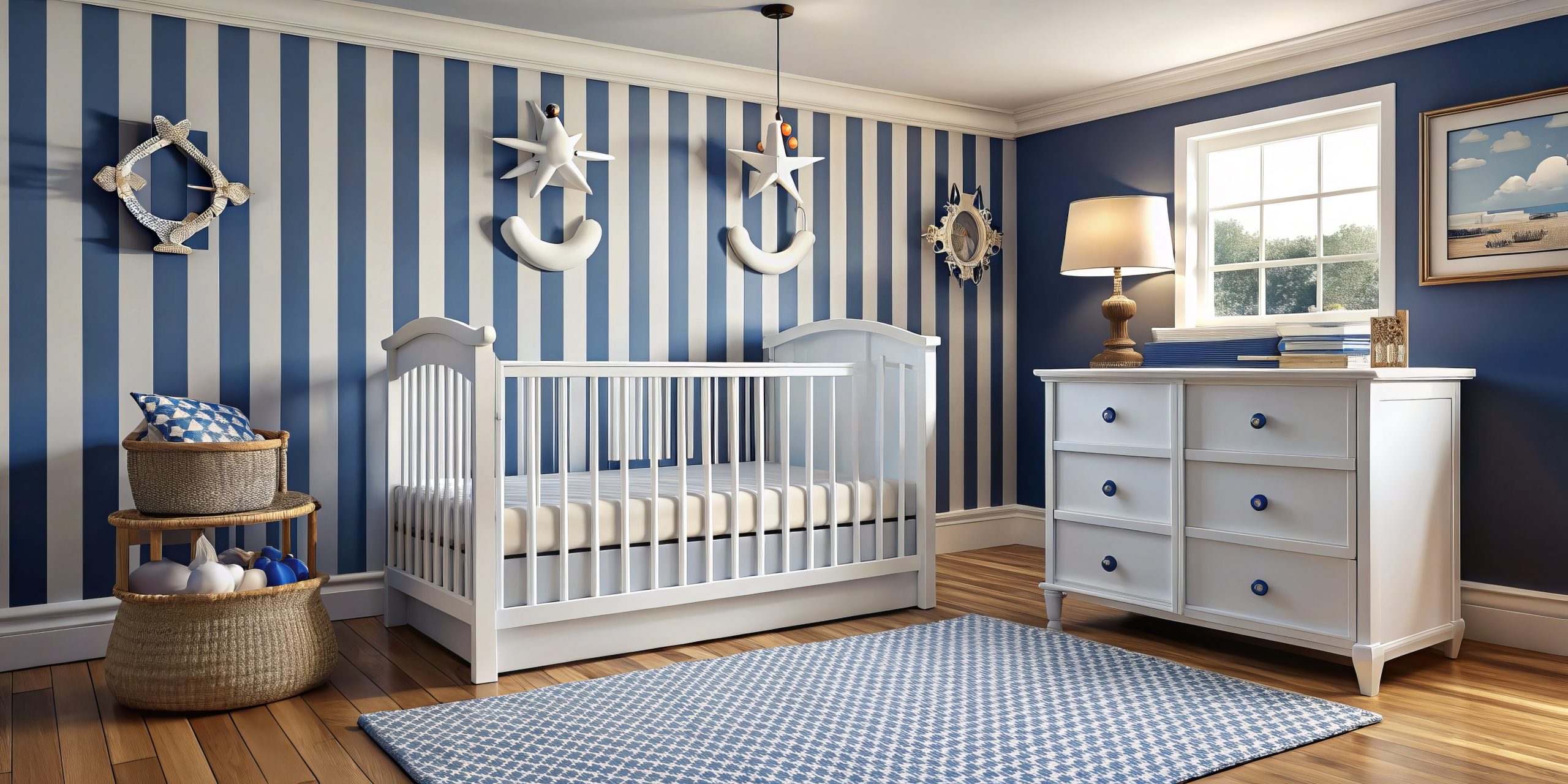
If you’re drawn to the sea but want a more classic twist, consider a nautical theme for your baby boy’s nursery. The nautical decor features crisp navy blues, whites, and reds with anchors, ships, and sailor stripes. This timeless theme brings in elements of maritime adventure while maintaining a clean, structured design.
Decorate with anchor-patterned bedding, rope accents, and sailboat wall art. A ship wheel or lighthouse-shaped lamp can add the perfect finishing touch. Nautical themes are great because they offer a versatile look that can be easily adapted as your child grows.
9. Dinosaur Roar
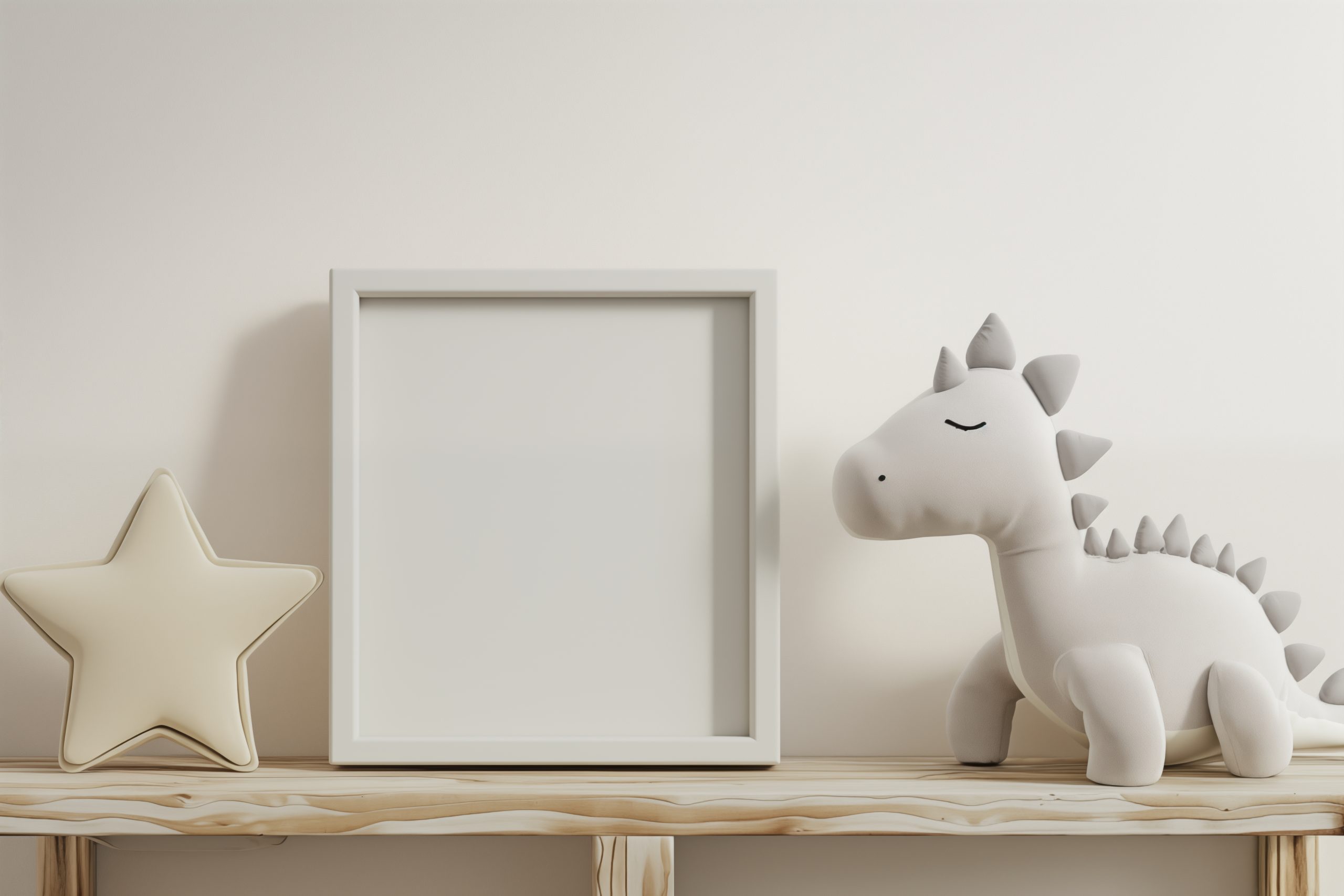
A dinosaur theme is a popular choice for a baby boy who is ready to embark on his journey in life. Create a lively atmosphere with friendly, prehistoric creatures such as T-Rex, triceratops, and brontosaurus using colourful wall decals, plush toys, and bedding. The dino theme is vibrant, striking, and ideal for nurturing creativity.
Use vibrant greens and blues to paint the walls, resembling a prehistoric jungle, or opt for a neutral colour palette and allow the dinosaur accents to take centre stage. Consider incorporating a dinosaur footprint rug or themed bookshelves as well. This enjoyable theme is sure to transform your baby boy’s nursery into a stimulating and captivating space.
10. Boho Chic
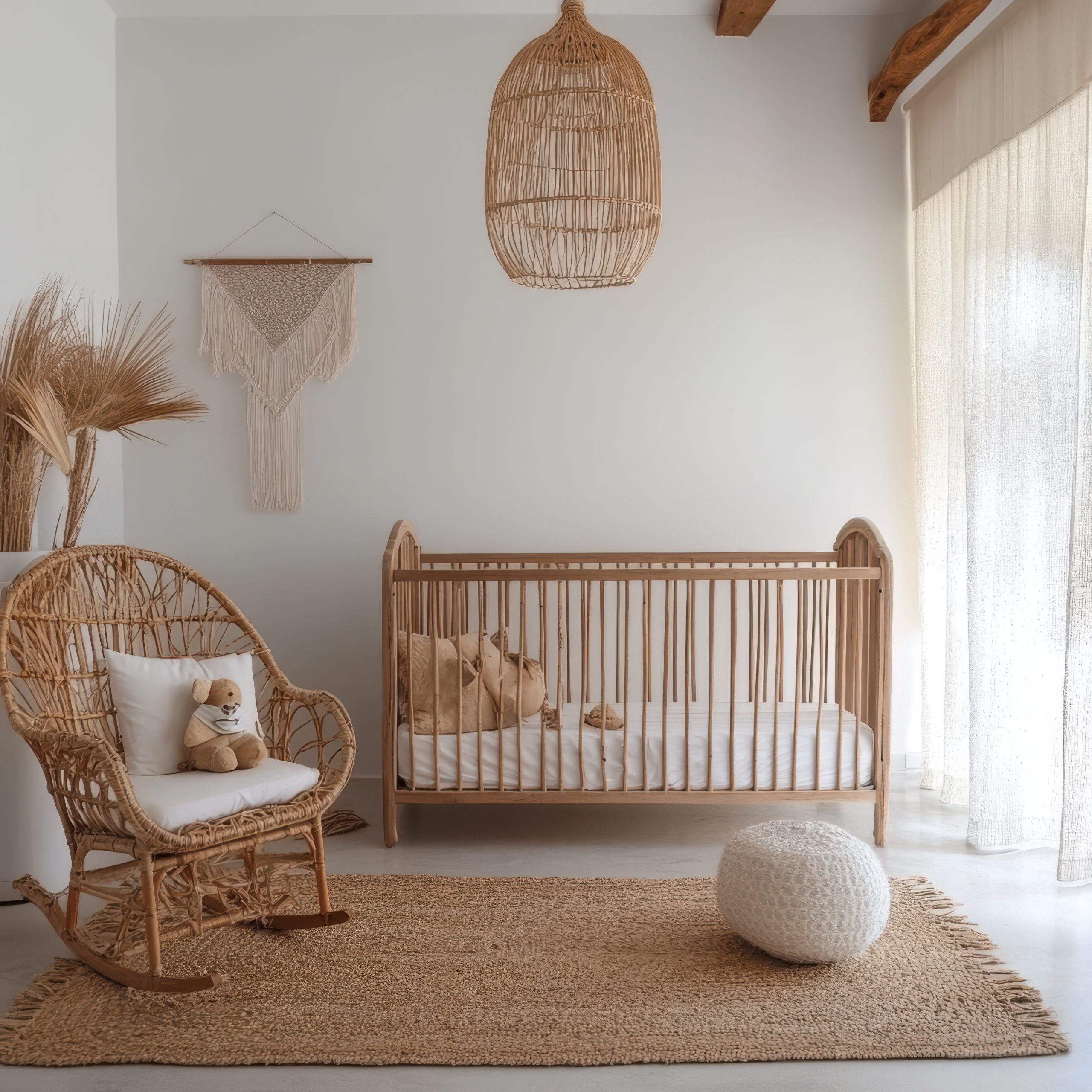
Looking for a stylish yet laid-back baby boy nursery theme? Consider boho chic, which combines natural materials, earthy tones, and diverse decor for a cozy, relaxed ambience. Choose warm colours like terracotta, mustard, and cream, and incorporate textures such as macrame, wicker, and wood.
Add a bohemian flair with dreamcatchers, woven baskets, and tassel garlands. A simple crib with a light canopy contributes to the room’s tranquil, airy atmosphere. The boho chic theme offers a relaxed, free-spirited ambience while incorporating natural, soothing elements.
No matter which nursery baby boy nursery theme you choose, creating a beautiful, cozy space will be a memorable and rewarding experience that sets the stage for his early adventures.


















































 Lighting is key in creating the right mood in your master bedroom. A statement chandelier or pendant light can serve as both a functional light source and a striking visual centrepiece. Whether you prefer a modern geometric fixture or a more classic, ornate chandelier, the right lighting can set the tone for the entire space. Consider selecting a fixture that complements your bedroom’s overall aesthetic. For example, a minimalist space might call for sleek, understated lighting, while a vintage-inspired bedroom could benefit from a chandelier with intricate details and soft, diffused light. The key is to ensure that your choice of overhead lighting not only enhances the design but also provides enough brightness for the room’s general needs.
Lighting is key in creating the right mood in your master bedroom. A statement chandelier or pendant light can serve as both a functional light source and a striking visual centrepiece. Whether you prefer a modern geometric fixture or a more classic, ornate chandelier, the right lighting can set the tone for the entire space. Consider selecting a fixture that complements your bedroom’s overall aesthetic. For example, a minimalist space might call for sleek, understated lighting, while a vintage-inspired bedroom could benefit from a chandelier with intricate details and soft, diffused light. The key is to ensure that your choice of overhead lighting not only enhances the design but also provides enough brightness for the room’s general needs.
 A clutter-free master bedroom is essential for maintaining a peaceful and relaxing environment. Without proper storage solutions, it’s easy for clothes, shoes, and other personal items to accumulate and detract from the room’s tranquillity. Built-in wardrobes are a great solution for maximizing storage without taking up too much floor space. These can be customized to fit your exact needs, offering designated areas for clothing, accessories, and even shoes. If space is limited, under-bed storage is a practical alternative. Using stylish storage bins or drawers that slide easily under the bed can help you make the most of every inch of the room without sacrificing aesthetics. Floating shelves or wall-mounted storage units are another space-saving option, providing a place to display books, decor items, or extra linens while keeping the floor free of clutter.
A clutter-free master bedroom is essential for maintaining a peaceful and relaxing environment. Without proper storage solutions, it’s easy for clothes, shoes, and other personal items to accumulate and detract from the room’s tranquillity. Built-in wardrobes are a great solution for maximizing storage without taking up too much floor space. These can be customized to fit your exact needs, offering designated areas for clothing, accessories, and even shoes. If space is limited, under-bed storage is a practical alternative. Using stylish storage bins or drawers that slide easily under the bed can help you make the most of every inch of the room without sacrificing aesthetics. Floating shelves or wall-mounted storage units are another space-saving option, providing a place to display books, decor items, or extra linens while keeping the floor free of clutter.
 Your master bedroom should be a reflection of your personality, a space that feels uniquely yours. Incorporating personal touches such as family photos, cherished mementos, or travel souvenirs can give the room a sentimental and intimate atmosphere. These elements add warmth and individuality to the space, turning it into a true personal sanctuary. Consider creating a gallery wall with a mix of family portraits, art prints, or framed memorabilia to showcase your story. Personalized items, such as monogrammed pillows or blankets, can also be subtle ways to infuse your space with character.
Your master bedroom should be a reflection of your personality, a space that feels uniquely yours. Incorporating personal touches such as family photos, cherished mementos, or travel souvenirs can give the room a sentimental and intimate atmosphere. These elements add warmth and individuality to the space, turning it into a true personal sanctuary. Consider creating a gallery wall with a mix of family portraits, art prints, or framed memorabilia to showcase your story. Personalized items, such as monogrammed pillows or blankets, can also be subtle ways to infuse your space with character. While the bed is often the main focal point of a master bedroom, incorporating other statement furniture pieces can enhance the room’s character and function. Adding a well-crafted dresser, a graceful chaise lounge, or a distinctive nightstand can enhance the visual appeal and elevate the room’s ambience. For instance, a vintage dresser can introduce a sense of enduring charm, while a sleek, modern headboard can establish a contemporary atmosphere. When choosing standout furniture, it’s important to maintain balance. Make sure that the selected pieces complement each other and the room’s overall style. Mixing materials such as wood, metal, and fabric can also produce a complex and refined appearance. In addition to aesthetics, functionality should be a primary consideration when choosing statement furniture. A bench at the foot of the bed not only adds a stylish touch but also provides practical storage or seating. Similarly, a bold nightstand can be both a design element and a functional piece for storing essentials. The right furniture choices can transform your master bedroom into a space that is not only visually appealing but also perfectly suited to your lifestyle. Remember, each piece should contribute to the overall comfort and utility of the room, ensuring that it remains a peaceful retreat.
While the bed is often the main focal point of a master bedroom, incorporating other statement furniture pieces can enhance the room’s character and function. Adding a well-crafted dresser, a graceful chaise lounge, or a distinctive nightstand can enhance the visual appeal and elevate the room’s ambience. For instance, a vintage dresser can introduce a sense of enduring charm, while a sleek, modern headboard can establish a contemporary atmosphere. When choosing standout furniture, it’s important to maintain balance. Make sure that the selected pieces complement each other and the room’s overall style. Mixing materials such as wood, metal, and fabric can also produce a complex and refined appearance. In addition to aesthetics, functionality should be a primary consideration when choosing statement furniture. A bench at the foot of the bed not only adds a stylish touch but also provides practical storage or seating. Similarly, a bold nightstand can be both a design element and a functional piece for storing essentials. The right furniture choices can transform your master bedroom into a space that is not only visually appealing but also perfectly suited to your lifestyle. Remember, each piece should contribute to the overall comfort and utility of the room, ensuring that it remains a peaceful retreat.

 Incorporating plants into your main bedroom is a fantastic way to introduce a natural element and enhance the overall atmosphere. Indoor plants not only function as attractive decor but also provide numerous advantages, such as purifying the air and improving indoor air quality. Specific plants like snake plants, spider plants, and peace lilies are recognized for their air-purifying properties and minimal upkeep needs, making them well-suited for bedrooms. These plants can contribute to establishing a tranquil and relaxing setting, perfect for a space prioritizing relaxation. Even a small plant on a nightstand or a hanging plant in a corner can immediately infuse vitality into the room, imparting a fresh and peaceful ambience. If you’re concerned about plant care, don’t worry! There are plenty of low-maintenance options, and you can even opt for high-quality artificial plants to achieve the same aesthetic effect without the upkeep. Potted plants can be displayed in various ways—on shelves, in stylish planters, or as part of a vertical garden feature for added texture and interest. Pairing plants with natural materials like wood or woven baskets can also enhance the overall organic vibe of the room. Greenery in your bedroom creates a direct connection to nature, which can promote relaxation and improve your overall well-being.
Incorporating plants into your main bedroom is a fantastic way to introduce a natural element and enhance the overall atmosphere. Indoor plants not only function as attractive decor but also provide numerous advantages, such as purifying the air and improving indoor air quality. Specific plants like snake plants, spider plants, and peace lilies are recognized for their air-purifying properties and minimal upkeep needs, making them well-suited for bedrooms. These plants can contribute to establishing a tranquil and relaxing setting, perfect for a space prioritizing relaxation. Even a small plant on a nightstand or a hanging plant in a corner can immediately infuse vitality into the room, imparting a fresh and peaceful ambience. If you’re concerned about plant care, don’t worry! There are plenty of low-maintenance options, and you can even opt for high-quality artificial plants to achieve the same aesthetic effect without the upkeep. Potted plants can be displayed in various ways—on shelves, in stylish planters, or as part of a vertical garden feature for added texture and interest. Pairing plants with natural materials like wood or woven baskets can also enhance the overall organic vibe of the room. Greenery in your bedroom creates a direct connection to nature, which can promote relaxation and improve your overall well-being. The flooring you choose for your master bedroom can significantly impact both the aesthetics and comfort of the space. Hardwood floors are a popular option due to their timeless appeal, durability, and the warmth they bring to the room. They pair well with various styles, from traditional to modern, and can be enhanced with rugs to add softness underfoot. If you’re looking for an extra touch of luxury, consider adding an area rug or runner in key spaces such as next to the bed or under seating areas. These not only provide visual contrast but also make the room feel cozier and more inviting. For those who prioritize comfort, wall-to-wall carpeting is an excellent option. Carpeting offers a soft, warm surface that feels good underfoot, especially during colder months. It’s available in a variety of colours, patterns, and textures, allowing you to customize the look and feel of the room. Choose neutral tones for a classic and versatile foundation, or opt for more adventurous patterns or textures to add personality. If you prefer easy maintenance, look for high-quality, stain-resistant carpeting that combines comfort with practicality, ensuring that your master bedroom remains both stylish and functional for years to come.
The flooring you choose for your master bedroom can significantly impact both the aesthetics and comfort of the space. Hardwood floors are a popular option due to their timeless appeal, durability, and the warmth they bring to the room. They pair well with various styles, from traditional to modern, and can be enhanced with rugs to add softness underfoot. If you’re looking for an extra touch of luxury, consider adding an area rug or runner in key spaces such as next to the bed or under seating areas. These not only provide visual contrast but also make the room feel cozier and more inviting. For those who prioritize comfort, wall-to-wall carpeting is an excellent option. Carpeting offers a soft, warm surface that feels good underfoot, especially during colder months. It’s available in a variety of colours, patterns, and textures, allowing you to customize the look and feel of the room. Choose neutral tones for a classic and versatile foundation, or opt for more adventurous patterns or textures to add personality. If you prefer easy maintenance, look for high-quality, stain-resistant carpeting that combines comfort with practicality, ensuring that your master bedroom remains both stylish and functional for years to come.










